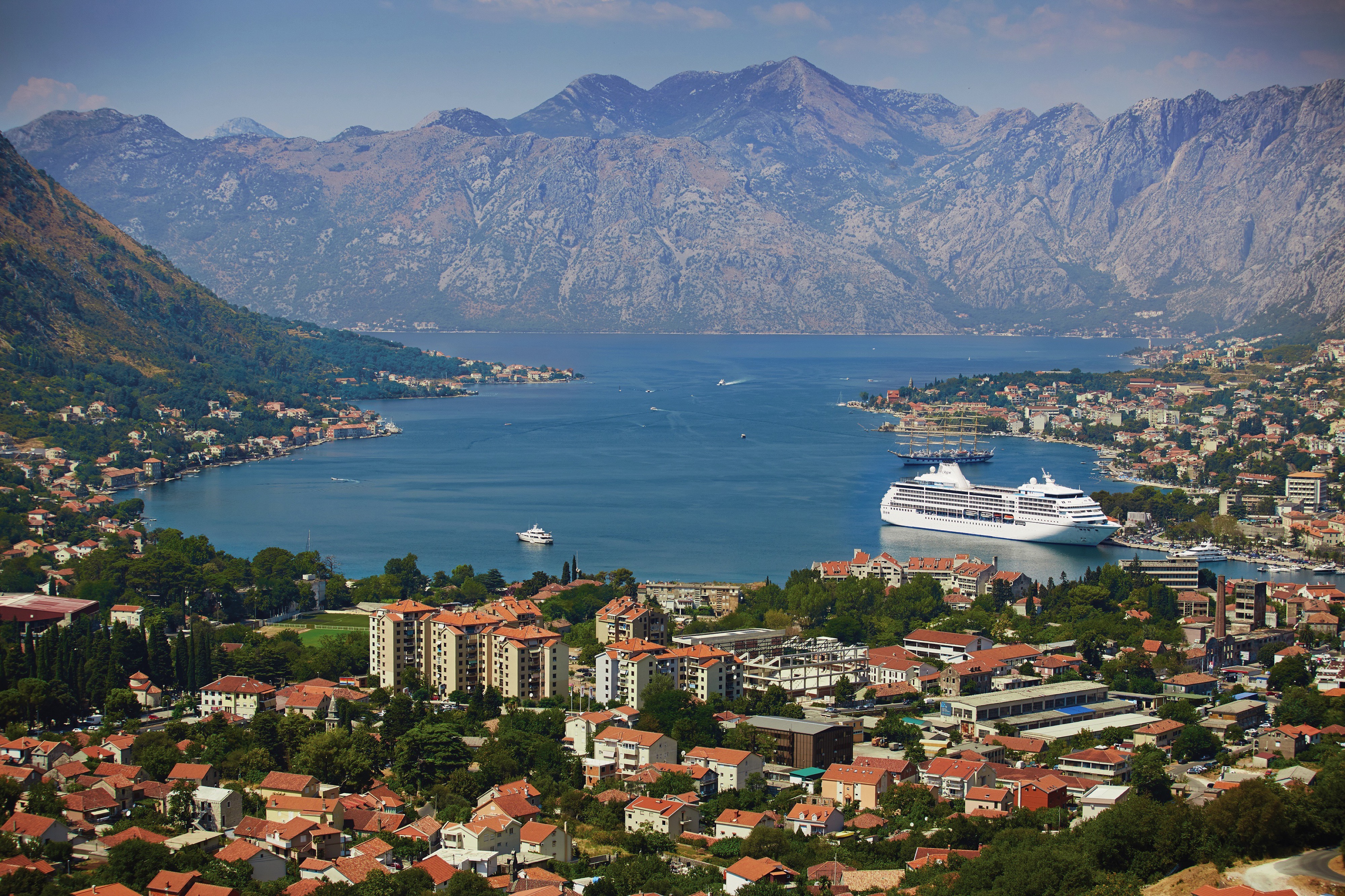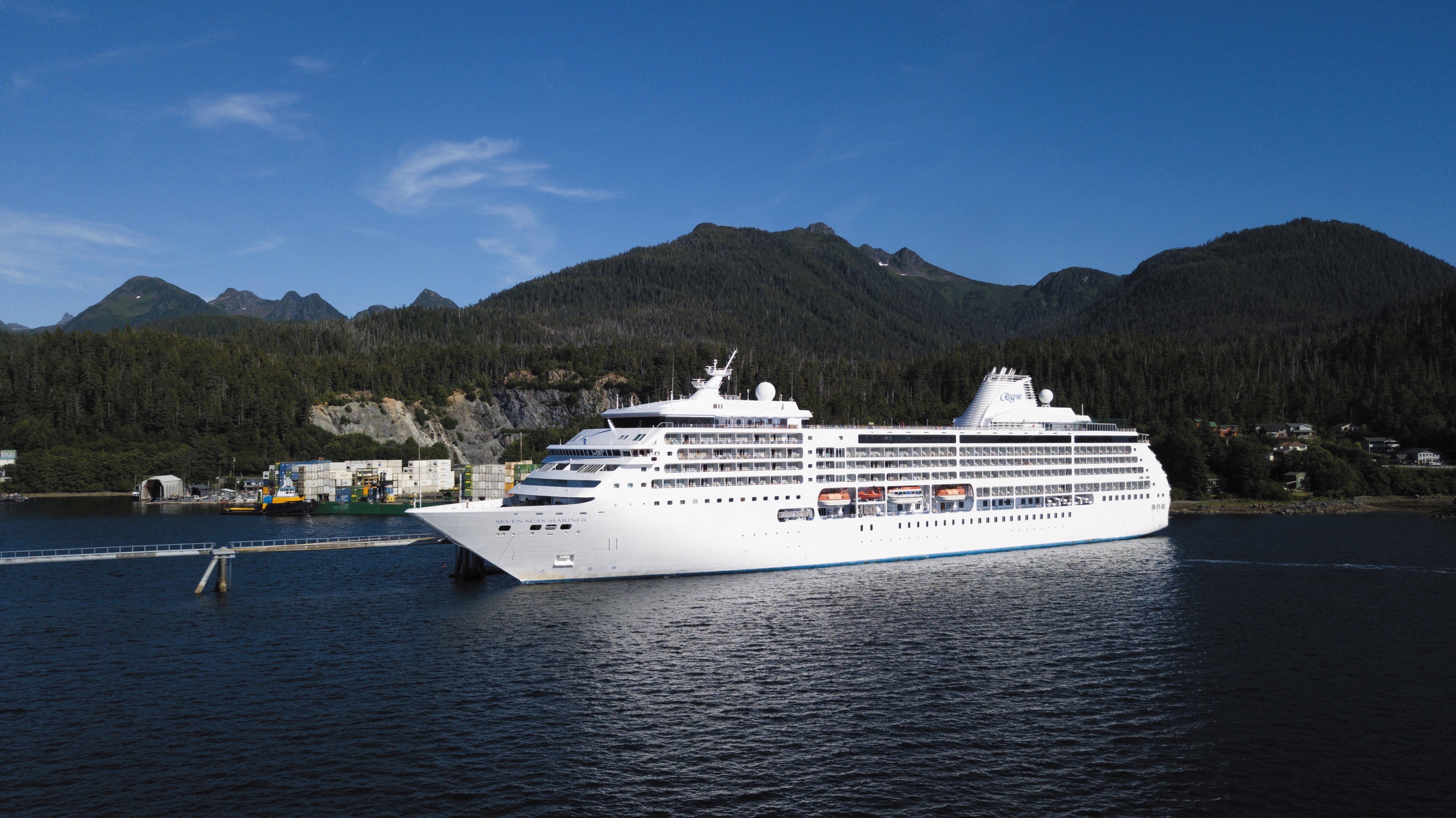Itinerary
Miami is one of the world’s most popular holiday spots. It has so much to offer; from its countless beach areas, to culture and museums, from spa and shopping days out, to endless cuban restaurants and cafes. Miami is a multicultural city that has something to offer to everyone.
Miami is one of the world’s most popular holiday spots. It has so much to offer; from its countless beach areas, to culture and museums, from spa and shopping days out, to endless cuban restaurants and cafes. Miami is a multicultural city that has something to offer to everyone.
Cartagena’s magnificent city walls and fortresses, now a UNESCO World Heritage Site, enclose a well-restored historic center (the Cuidad Amurallada, or walled city) with plazas, churches, museums, and shops that have made it a lively coastal vacation spot for South Americans and others. New hotels and restaurants make the walled city a desirable place to stay, and the formerly down-at-the-heels Getsemaní neighborhood attracts those seeking a bohemian buzz. The historic center is a small section of Cartagena; many hotels are in the Bocagrande district, an elongated peninsula where high-rise hotels overlook a long, gray-sand beach.When it was founded in 1533 by Spanish conquistador Pedro de Heredia, Cartagena was the only port on the South American mainland. Gold and silver looted from indigenous peoples passed through here en route to Spain and attracted pirates, including Sir Francis Drake, who in 1586 torched 200 buildings. Cartagena’s walls protected the city’s riches as well as the New World’s most important African slave market.
This town is not on the Nicoya Peninsula, but rather on Costa Rica’s mainland. It is best known as a cruise-ship port and launching pad for ferries heading southeast to the coast of the Nicoya Peninsula and for cruises sailing out on the Gulf of Nicoya. Puntarenas is also a major fishing port with a lively fish market. The town’s reputation suffers from the unimpressive parts you see from your car as you roll through town on the way to the ferry dock. But the town has a lot of character off the main drag, thanks to its illustrious past as an affluent port town and principal vacation spot for San José’s wealthy, who arrived by train in the last century. Once the port was moved and roads opened to other beaches, Puntarenas’s economy crashed, but it’s making a comeback. Sitting on a narrow spit of sand—punta de arenas literally means “point of sand”—that protrudes into the Gulf of Nicoya, the town boasts a beautifully groomed, wide Blue Flag beach with views of the Nicoya Peninsula and spectacular sunsets, along with a public swimming pool, the San Lucas Beach Club, and a marine-life museum. Ticos arrive by bus and car to enjoy the beach and stroll the Paseo de los Turistas, a beachfront promenade lined with tree-shaded concrete benches and seafood restaurants. Crowds of locals, called porteños, cruise by on bicycles, the town’s most popular form of transport.
Puerto Quetzal is Guatemala’s largest Pacific Ocean port. It is important for both cargo traffic and as a stop-off point for cruise liners
Acapulco is a major seaport on the scenic Pacific coast of Mexico, located on a deep semi-circular bay with sandy beaches and blue waters. It was a popular destination for many movie stars during the Golden Age of Hollywood, including Elvis Presley and Elizabeth Taylor.
Cabo San Lucas, a resort city on the southern tip of Mexico’s Baja California peninsula, is known for its beaches, water-based activities and nightlife. Playa El Médano is Cabo’s main beach, with outdoor restaurants and numerous bars. Past the marina is Land’s End promontory, site of Playa del Amor (Lover’s Beach) and El Arco, a natural archway in the seacliffs.
Capital of Hawaii, and a popular tourist destination, Honolulu is known for surfing and water sports. However, there’s more to the city than surfing; with museums, the only royal palace in the country, and a mall, there’s bound to be something of interest for any visitor.
Capital of Hawaii, and a popular tourist destination, Honolulu is known for surfing and water sports. However, there’s more to the city than surfing; with museums, the only royal palace in the country, and a mall, there’s bound to be something of interest for any visitor.
Kailua-Kona is a town on the west coast of Hawaii Island (the Big Island). Hulihee Palace is a former royal vacation home dating from 1838. Mokuaikaua Church, from the 1800s, is Hawaii’s oldest Christian church. On Kailua Bay, reconstructed thatched houses at Kamakahonu National Historic Landmark mark King Kamehameha I’s residence. Colorful coral lies off Kamakahonu Beach. Kailua Pier has boat moorings.
Simply saying the name Bora Bora is usually enough to induce gasps of jealousy, as images of milky blue water, sparkling white beaches and casually leaning palm trees immediately spring to mind. The imagination doesn’t lie, either, and if you visit, you’ll soon realise this island is every bit as gorgeous as you ever imagined. Thatched wooden huts stand out over shallow, sparkling seawater, with vivid fish swirling just below. Soak up the sun, scuba dive, or simply revel in the opulent luxury of one of the island’s many magnificent resorts. If blissful inactivity doesn’t appeal, then get active, and hike the greenery of the sharp Mount Pahia.
Simply saying the name Bora Bora is usually enough to induce gasps of jealousy, as images of milky blue water, sparkling white beaches and casually leaning palm trees immediately spring to mind. The imagination doesn’t lie, either, and if you visit, you’ll soon realise this island is every bit as gorgeous as you ever imagined. Thatched wooden huts stand out over shallow, sparkling seawater, with vivid fish swirling just below. Soak up the sun, scuba dive, or simply revel in the opulent luxury of one of the island’s many magnificent resorts. If blissful inactivity doesn’t appeal, then get active, and hike the greenery of the sharp Mount Pahia.
Papeete will be your gateway to the tropical paradise of French Polynesia, where islands fringed with gorgeous beaches and turquoise ocean await to soothe the soul. This spirited city is the capital of French Polynesia, and serves as a superb base for onward exploration of Tahiti – an island of breathtaking landscapes and oceanic vistas. Wonderful lagoons of crisp, clear water beg to be snorkelled, stunning black beaches and blowholes pay tribute to the island’s volcanic heritage, and lush green mountains beckon you inland on adventures, as you explore extraordinary Tahiti. Visit to relax inside picturesque stilted huts, which stand out over shimmering water, as you settle into the intoxicating rhythm of life, in this Polynesian paradise.
Papeete will be your gateway to the tropical paradise of French Polynesia, where islands fringed with gorgeous beaches and turquoise ocean await to soothe the soul. This spirited city is the capital of French Polynesia, and serves as a superb base for onward exploration of Tahiti – an island of breathtaking landscapes and oceanic vistas. Wonderful lagoons of crisp, clear water beg to be snorkelled, stunning black beaches and blowholes pay tribute to the island’s volcanic heritage, and lush green mountains beckon you inland on adventures, as you explore extraordinary Tahiti. Visit to relax inside picturesque stilted huts, which stand out over shimmering water, as you settle into the intoxicating rhythm of life, in this Polynesian paradise.
Mo’orea is one of the Society Islands of the French Polynesia. Located in the South Pacific, it is considered a magical island thanks to its majestic volcanic mountains, set against warm lagoon waters and green meadows. It is an island that attracts visitors of all abilities wanting to explore both above and below the ocean waters.
American Samoa is a tropical paradise, located in the Pacific Ocean and home to some of the world’s most unique flora and fauna. Pago Pago is the main harbour and village of Tutuila island. It is considered the capital of the territory and is the entry point for visitors exploring the picturesque volcanic islands.
Samoa is a group of ten islands located in the South Pacific. The tropical climate and volcanic landscape create a picturesque location for visitors to explore, together with the experience of Fa’a Samoa, the three thousand year old way of life on Samoa.
Fiji is a collection of tropical islands in the South Pacific and is well known for soft coral diving, white sandy beaches, and idyllic and peaceful surroundings. Because of its paradisiac surroundings, Fiji is a popular location for weddings and honeymoons. Suva is the capital of the Fiji archipelago, located on the southeastern coast of the island of Viti Levu and is the second most populated city of Fiji.
North of Nadi through sugarcane plantations and past the Sabeto Mountains is Lautoka, nicknamed the Sugar City for the local agriculture and its big processing mill. With a population of around 50,000, it’s the only city besides Suva and, like the capital, has a pleasant waterfront. It’s the sailing point for Blue Lagoon and Beachcomber Cruises but is otherwise unremarkable for tourists, itself having few hotels and fewer good restaurants. Locals recommend the city as a less-expensive place to shop for clothing, but note that it can take as long as 45 minutes to drive here. Legend has it that Lautoka acquired its name when two chiefs engaged in combat and one hit the other with a spear. He proclaimed “lau toka” (spear hit) and thus the future town was named.
Vanuatu is an island nation located in the southern Pacific Ocean. The archipelago, which is of volcanic origin, is approximately 1,090 miles (about 1,750 kilometres) east of northern Australia, approximately 310 miles (about 500 kilometres) northeast of New Caledonia, west of Fiji and southeast of the Solomon Islands, near New Guinea. Located on Mélé Bay along the southwest coast of Éfaté, Port Vila is the capital and largest city of Vanuatu, as well as its commercial and economic centre. Although Port Vila’s British and French influences are apparent, its multinational population includes ni-Vanuatu, British, French, Chinese, and Vietnamese citizens. An active commercial port, the city is home to hospitals, hotels, casinos, markets and shopping districts, a sports stadium, cultural centre, teacher-training institution, campus of the University of the South Pacific, and several meat- and fish-processing plants. The municipality of Port Vila is divided into four wards, Malapoa-Tagabe, Anabrou-Melcofe-Tassiriki, Centre and South. The area occupied by Port Vila has been inhabited by Melanesian people for thousands of years. In 2004, an archaeological expedition unearthed a burial site with 25 tombs, skeletons and pieces of ceramic pottery dating from 1300 B.C. The Vanuatu Islands first had contact with Europeans in 1606 with the arrival of Portuguese explorer Pedro Fernandes de Queirós. Europeans did not return until 1768, when Louis Antoine de Bougainville rediscovered the islands. In 1774, Captain Cook called the islands the ‘New Hebrides’, a name that would last until their independence in 1980. In 1825, sandalwood was discovered on the island of Erromango, prompting a rush of immigrants that included Catholic and Protestant missionaries from European and North America, as well as settlers looking for land to farm cotton, coffee, cocoa, bananas, and coconuts. British subjects from Australia made up the majority of settlers, but the establishment of the Caledonian Company of the New Hebrides in 1882 attracted more French subjects. The land around Port Vila was converted into the municipality of Franceville in 1889. By the start of the 20th century, the French outnumbered the British, and the two nations agreed to govern the islands jointly by way of the British-French Condominium. During World War II, Port Vila was an American and Australian airbase. The New Hebrides National Party was established in the early-1970s. Renamed Vanua’aku Pati in 1974, the party pushed for independence. In 1980, amidst the brief Coconut War, the Republic of Vanuatu was created. The economies of Port Vila and Vanuatu are supported by the agriculture, offshore financial services and cattle industries. However, the abundant tropical beauty of Vanuatu has made Port Vila a popular tourist destination for outdoor and nature enthusiasts alike. Renowned for its tropical climate and exquisite, white-sand beaches and world-class fishing, the archipelago is a region of spectacular geographic diversity that includes spectacular volcanoes, mountains and valleys, along with idyllic jungles, rainforests, botanical gardens, mineral springs, and waterfalls. What’s more, Port Vila offers easy access to exploring the city, Vanuatu and the offshore islands that comprise this wonderful South Pacific island chain. Port Vila consists of a diverse blend of Melanesian, Eastern and Western cultures that presents a unique opportunity to discover the people, traditions and history of Vanuatu. Cultural village tours are a fantastic way to meet the locals and experience indigenous lifestyles and customs through storytelling, music, dance, kava-tasting, and a traditional Melanesian feast. The evolution of Port Vila and Vanuatu can be explored during visits to the Vanuatu Cultural Centre and Museum features a collection of historical artefacts from the Vanuatu Island. Additional historic landmarks include Independence Park, the French and British residencies, Supreme Court, Georges Pompidou Building, World War I and II memorials, Tanna Coffee-Roasting Factory, and more. Vanuatu’s verdant canyons, jungle-covered mountain peaks, volcanoes, waterfalls, botanical gardens, mineral springs, white-sand beaches, and rainforests invite a wide array of picturesque, memorable and exciting sightseeing venues for outdoor enthusiasts. Land-based excursions include bird-watching, bicycling and motor-biking, eco-tours, hiking through jungle and rainforest nature trails, horseback-riding at the nearby Sea Horse Ranch or Club Hippique Adventure Park, helicopter or seaplane flight-seeing, dune-bugging the beaches and jungles, ‘zorbing’ down the hillsides, abseiling down a cascading waterfall, volcano trekking and sandboarding, zip-lining through the jungle canopy, and golfing at the stunningly beautiful Port Vila Golf and Country Club, the only 18-hole championship course in Vanuatu and home to the PGA-sanctioned Vanuatu Open. Picturesque and fun-filled water-based excursions include swimming, boating and sailing along the exquisite coast of Port Vila and Vanuatu, deep-sea fishing for enormous dolphin, marlin, wahoo, dorado, tuna, swordfish, and sailfish, jet-skiing and high-speed jet-boating, stand-up paddle-boarding, surfing, kite-surfing, and parasailing. The archipelago also offers some of the world’s finest snorkelling and diving at venues such as the Hideaway Islands Marine Reserves, JoJo Beach Club, Havannah Beach and Boat Club, and Iririki Island.Due to its compact size, Port Vila can be easily explored in just a single day.
Lifou is a commune of France in the Loyalty Islands of New Caledonia. Lifou is made up of two main islands – Lifou Island and Tiga Island- in additional to a number of uninhabited islets. Lifou Isand is the largest atoll in the world. The island is actually made of fossilized coral – known as a makatea. Lifou island does not have any surface water and it relies on a freshwater reservoir accessed by caves. Lifou Island is best known for its vast atoll (the largest in the world). This ring-shaped coral reef affords some of the best snorkelling in the world. Popular activities on this island include scenic walks, relaxing days on the beach, swimming and snorkelling. There are no organized tours being offered during this call to Lifou Island, guests may explore on their own.
With its elegant urban infrastructure in a stunning natural setting, Noumea is a truly unique island and part of the New Caledonia archipelago. Noumea started as a penal colony, but has since evolved to a lovely metropolis and today has almost two thirds of New Caledonia’s population. While much of the archipelago of New Caledonia has a large percentage of Kanak people – the indigenous inhabitants who live in tribal areas across the country – Noumea is predominantly European with a strong French influence. The city’s center and Place de Cocotiers, the main park, are located close to the harbor and several churches date back to the late 19th century. Other attractions include a world-class aquarium at Anse Vata, several long beaches to the south, and a noteworthy collection of Kanak and South Pacific objects at the Museum of New Caledonia. The architectural gem of the city is the Tjibaou Cultural Center, the structure of which resembles sails, or the roofs of Kanak houses hidden behind mangroves.
Auckland is called the City of Sails, and visitors flying in will see why. On the East Coast is the Waitemata Harbour—a Māori word meaning sparkling waters—which is bordered by the Hauraki Gulf, an aquatic playground peppered with small islands where many Aucklanders can be found “mucking around in boats.”Not surprisingly, Auckland has some 70,000 boats. About one in four households in Auckland has a seacraft of some kind, and there are 102 beaches within an hour’s drive; during the week many are quite empty. Even the airport is by the water; it borders the Manukau Harbour, which also takes its name from the Māori language and means solitary bird.According to Māori tradition, the Auckland isthmus was originally peopled by a race of giants and fairy folk. When Europeans arrived in the early 19th century, however, the Ngāti-Whātua tribe was firmly in control of the region. The British began negotiations with the Ngāti-Whātua in 1840 to purchase the isthmus and establish the colony’s first capital. In September of that year the British flag was hoisted to mark the township’s foundation, and Auckland remained the capital until 1865, when the seat of government was moved to Wellington. Aucklanders expected to suffer from the shift; it hurt their pride but not their pockets. As the terminal for the South Sea shipping routes, Auckland was already an established commercial center. Since then the urban sprawl has made this city of approximately 1.3 million people one of the world’s largest geographically.A couple of days in the city will reveal just how developed and sophisticated Auckland is—the Mercer City Survey 2012 saw it ranked as the third-highest city for quality of life—though those seeking a New York in the South Pacific will be disappointed. Auckland is more get-up and go-outside than get-dressed-up and go-out. That said, most shops are open daily, central bars and a few nightclubs buzz well into the wee hours, especially Thursday through Saturday, and a mix of Māori, Pacific people, Asians, and Europeans contributes to the cultural milieu. Auckland has the world’s largest single population of Pacific Islanders living outside their home countries, though many of them live outside the central parts of the city and in Manukau to the south. The Samoan language is the second most spoken in New Zealand. Most Pacific people came to New Zealand seeking a better life. When the plentiful, low-skilled work that attracted them dried up, the dream soured, and the population has suffered with poor health and education. Luckily, policies are now addressing that, and change is slowly coming. The Pacifica Festival in March is the region’s biggest cultural event, attracting thousands to Western Springs. The annual Pacific Island Secondary Schools’ Competition, also in March, sees young Pacific Islander and Asian students compete in traditional dance, drumming, and singing. This event is open to the public.At the geographical center of Auckland city is the 1,082-foot Sky Tower, a convenient landmark for those exploring on foot and some say a visible sign of the city’s naked aspiration. It has earned nicknames like the Needle and the Big Penis—a counterpoint to a poem by acclaimed New Zealand poet James K. Baxter, which refers to Rangitoto Island as a clitoris in the harbor.The Waitemata Harbour has become better known since New Zealand staged its first defense of the America’s Cup in 2000 and the successful Louis Vuitton Pacific Series in early 2009. The first regatta saw major redevelopment of the waterfront. The area, where many of the city’s most popular bars, cafés, and restaurants are located, is now known as Viaduct Basin or, more commonly, the Viaduct. A recent expansion has created another area, Wynyard Quarter, which is slowly adding restaurants.These days, Auckland is still considered too bold and brash for its own good by many Kiwis who live “south of the Bombay Hills,” the geographical divide between Auckland and the rest of New Zealand (barring Northland). “Jafa,” an acronym for “just another f—ing Aucklander,” has entered the local lexicon; there’s even a book out called Way of the Jafa: A Guide to Surviving Auckland and Aucklanders. A common complaint is that Auckland absorbs the wealth from the hard work of the rest of the country. Most Aucklanders, on the other hand, still try to shrug and see it as the parochial envy of those who live in small towns. But these internal identity squabbles aren’t your problem. You can enjoy a well-made coffee in almost any café, or take a walk on a beach—knowing that within 30 minutes’ driving time you could be cruising the spectacular harbor, playing a round at a public golf course, or even walking in subtropical forest while listening to the song of a native tûî bird.
Auckland is called the City of Sails, and visitors flying in will see why. On the East Coast is the Waitemata Harbour—a Māori word meaning sparkling waters—which is bordered by the Hauraki Gulf, an aquatic playground peppered with small islands where many Aucklanders can be found “mucking around in boats.”Not surprisingly, Auckland has some 70,000 boats. About one in four households in Auckland has a seacraft of some kind, and there are 102 beaches within an hour’s drive; during the week many are quite empty. Even the airport is by the water; it borders the Manukau Harbour, which also takes its name from the Māori language and means solitary bird.According to Māori tradition, the Auckland isthmus was originally peopled by a race of giants and fairy folk. When Europeans arrived in the early 19th century, however, the Ngāti-Whātua tribe was firmly in control of the region. The British began negotiations with the Ngāti-Whātua in 1840 to purchase the isthmus and establish the colony’s first capital. In September of that year the British flag was hoisted to mark the township’s foundation, and Auckland remained the capital until 1865, when the seat of government was moved to Wellington. Aucklanders expected to suffer from the shift; it hurt their pride but not their pockets. As the terminal for the South Sea shipping routes, Auckland was already an established commercial center. Since then the urban sprawl has made this city of approximately 1.3 million people one of the world’s largest geographically.A couple of days in the city will reveal just how developed and sophisticated Auckland is—the Mercer City Survey 2012 saw it ranked as the third-highest city for quality of life—though those seeking a New York in the South Pacific will be disappointed. Auckland is more get-up and go-outside than get-dressed-up and go-out. That said, most shops are open daily, central bars and a few nightclubs buzz well into the wee hours, especially Thursday through Saturday, and a mix of Māori, Pacific people, Asians, and Europeans contributes to the cultural milieu. Auckland has the world’s largest single population of Pacific Islanders living outside their home countries, though many of them live outside the central parts of the city and in Manukau to the south. The Samoan language is the second most spoken in New Zealand. Most Pacific people came to New Zealand seeking a better life. When the plentiful, low-skilled work that attracted them dried up, the dream soured, and the population has suffered with poor health and education. Luckily, policies are now addressing that, and change is slowly coming. The Pacifica Festival in March is the region’s biggest cultural event, attracting thousands to Western Springs. The annual Pacific Island Secondary Schools’ Competition, also in March, sees young Pacific Islander and Asian students compete in traditional dance, drumming, and singing. This event is open to the public.At the geographical center of Auckland city is the 1,082-foot Sky Tower, a convenient landmark for those exploring on foot and some say a visible sign of the city’s naked aspiration. It has earned nicknames like the Needle and the Big Penis—a counterpoint to a poem by acclaimed New Zealand poet James K. Baxter, which refers to Rangitoto Island as a clitoris in the harbor.The Waitemata Harbour has become better known since New Zealand staged its first defense of the America’s Cup in 2000 and the successful Louis Vuitton Pacific Series in early 2009. The first regatta saw major redevelopment of the waterfront. The area, where many of the city’s most popular bars, cafés, and restaurants are located, is now known as Viaduct Basin or, more commonly, the Viaduct. A recent expansion has created another area, Wynyard Quarter, which is slowly adding restaurants.These days, Auckland is still considered too bold and brash for its own good by many Kiwis who live “south of the Bombay Hills,” the geographical divide between Auckland and the rest of New Zealand (barring Northland). “Jafa,” an acronym for “just another f—ing Aucklander,” has entered the local lexicon; there’s even a book out called Way of the Jafa: A Guide to Surviving Auckland and Aucklanders. A common complaint is that Auckland absorbs the wealth from the hard work of the rest of the country. Most Aucklanders, on the other hand, still try to shrug and see it as the parochial envy of those who live in small towns. But these internal identity squabbles aren’t your problem. You can enjoy a well-made coffee in almost any café, or take a walk on a beach—knowing that within 30 minutes’ driving time you could be cruising the spectacular harbor, playing a round at a public golf course, or even walking in subtropical forest while listening to the song of a native tûî bird.
The Tasman Sea on the west and the Pacific Ocean on the east meet at thetop of North Island at Cape Reinga. No matter what route you take, you’ll passfarms and forests, marvellous beaches, and great open spaces. The East Coast,up to the Bay of Islands, is Northland’s most densely populated, often withrefugees from bigger cities—looking for a more relaxed life—clustered aroundbreathtaking beaches. The first decision on the drive north comes at the footof the Brynderwyn Hills. Turning left will take you up the West Coast throughareas once covered with forests and now used for either agricultural orhorticulture. Driving over “the Brynderwyns,” as they are known,takes you to Whangarei, the only city in Northland. If you’re in the mood for adiversion, you can slip to the beautiful coastline and take in Waipu Cove, anarea settled by Scots, and Laings Beach, where million-dollar homes sit next tosmall Kiwi beach houses.An hour’s drive farther north is the Bay of Islands, known all over theworld for its beauty. There you will find lush forests, splendid beaches, andshimmering harbors. The Treaty of Waitangi was signed here in 1840 betweenMāoriand the British Crown, establishing the basis for the modern New Zealandstate. Every year on February 6, the extremely beautiful Waitangi Treaty Ground(the name means weeping waters) is the sight of a celebration of the treaty andprotests by Māori unhappy with it. Continuing north on the East Coast, theagricultural backbone of the region is even more evident and a series ofwinding loop roads off the main highway will take you to beaches that are bothbeautiful and isolated where you can swim, dive, picnic, or just laze. .The West Coast is even less populated, and the coastline is rugged andwindswept. In the Waipoua Forest, you will find some of New Zealand’s oldestand largest kauri trees; the winding road will also take you past mangroveswamps. Crowning the region is the spiritually significant Cape Reinga, theheadland at the top of the vast stretch of 90 Mile Beach, where it’s believedMāori souls depart after death. Today Māori make up roughly a quarter of thearea’s population (compared with the national average of about 15%). The legendaryMāori navigator Kupe was said to have landed on the shores of Hokianga Harbour,where the first arrivals made their home. Many different wi (tribes) livedthroughout Northland, including Ngapuhi (the largest), Te Roroa, Ngati Wai,Ngati Kuri, Te Aupouri, Ngaitakoto, Ngati Kahu, and Te Rarawa. Many Māoriherecan trace their ancestry to the earliest inhabitants
Sydney belongs to the exclusive club of cities that generate excitement. At the end of a marathon flight there’s renewed vitality in the cabin as the plane circles the city, where thousands of yachts are suspended on the dark water and the sails of the Opera House glisten in the distance. Blessed with dazzling beaches and a sunny climate, Sydney is among the most beautiful cities on the planet.With 4.6 million people, Sydney is the biggest and most cosmopolitan city in Australia. A wave of immigration from the 1950s has seen the Anglo-Irish immigrants who made up the city’s original population joined by Italians, Greeks, Turks, Lebanese, Chinese, Vietnamese, Thais, and Indonesians. This intermingling has created a cultural vibrancy and energy—and a culinary repertoire—that was missing only a generation ago.Sydneysiders embrace their harbor with a passion. Indented with numerous bays and beaches, Sydney Harbour is the presiding icon for the city, and urban Australia. Captain Arthur Phillip, commander of the 11-ship First Fleet, wrote in his diary when he first set eyes on the harbor on January 26, 1788: “We had the satisfaction of finding the finest harbor in the world.”Although a visit to Sydney is an essential part of an Australian experience, the city is no more representative of Australia than Los Angeles is of the United States. Sydney has joined the ranks of the great cities whose characters are essentially international. What Sydney offers is style, sophistication, and great looks—an exhilarating prelude to the continent at its back door.
Sydney belongs to the exclusive club of cities that generate excitement. At the end of a marathon flight there’s renewed vitality in the cabin as the plane circles the city, where thousands of yachts are suspended on the dark water and the sails of the Opera House glisten in the distance. Blessed with dazzling beaches and a sunny climate, Sydney is among the most beautiful cities on the planet.With 4.6 million people, Sydney is the biggest and most cosmopolitan city in Australia. A wave of immigration from the 1950s has seen the Anglo-Irish immigrants who made up the city’s original population joined by Italians, Greeks, Turks, Lebanese, Chinese, Vietnamese, Thais, and Indonesians. This intermingling has created a cultural vibrancy and energy—and a culinary repertoire—that was missing only a generation ago.Sydneysiders embrace their harbor with a passion. Indented with numerous bays and beaches, Sydney Harbour is the presiding icon for the city, and urban Australia. Captain Arthur Phillip, commander of the 11-ship First Fleet, wrote in his diary when he first set eyes on the harbor on January 26, 1788: “We had the satisfaction of finding the finest harbor in the world.”Although a visit to Sydney is an essential part of an Australian experience, the city is no more representative of Australia than Los Angeles is of the United States. Sydney has joined the ranks of the great cities whose characters are essentially international. What Sydney offers is style, sophistication, and great looks—an exhilarating prelude to the continent at its back door.
Tourism is the lifeblood of Cairns (pronounced Caans). The city makes a good base for exploring the wild top half of Queensland, and tens of thousands of international travelers use it as a jumping-off point for activities such as scuba diving and snorkeling trips to the Barrier Reef, as well as boating, fishing, parasailing, scenic flights, and rain-forest treks.It’s a tough environment, with intense heat and fierce wildlife. Along with wallabies and grey kangaroos in the savannah and tree kangaroos in the rain forest, you’ll find stealthy saltwater crocodiles, venomous snakes, and jellyfish so deadly they put the region’s stunning beaches off- limits to swimmers for nearly half the year. Yet despite this formidable setting, Cairns and tropical North Queensland are far from intimidating places. The people are warm and friendly, the sights spectacular, and—at the right time of year—the beachside lounging is world-class.
Darwin is Australia’s most colorful, and exotic, capital city. Surrounded on three sides by the turquoise waters of the Timor Sea, the streets are lined with tropical flowers and trees. Warm and dry in winter, hot and steamy in summer, it’s a relaxed and casual place, as well as a beguiling blend of tropical frontier outpost and Outback hardiness. Thanks to its close proximity to Southeast Asia and its multicultural population it also seems more like Asia than the rest of Australia. Darwin is a city that has always had to fight for its survival. The seductiveness of contemporary Darwin lifestyles belies a history of failed attempts that date from 1824 when Europeans attempted to establish an enclave in this harsh, unyielding climate. The original 1869 settlement, called Palmerston, was built on a parcel of mangrove wetlands and scrub forest that had changed little in 15 million years. It was not until 1911, after it had already weathered the disastrous cyclones of 1878, 1882, and 1897, that the town was named after the scientist who had visited Australia’s shores aboard the Beagle in 1839. During World War II it was bombed more than 60 times, as the harbor full of warships was a prime target for the Japanese war planes. Then, on the night of Christmas Eve 1974, the city was almost completely destroyed by Cyclone Tracy, Australia’s greatest natural disaster. It’s a tribute to those who stayed and to those who have come to live here after Tracy that the rebuilt city now thrives as an administrative and commercial center for northern Australia. Old Darwin has been replaced by something of an edifice complex—such buildings as Parliament House and the Supreme Court all seem very grand for such a small city, especially one that prides itself on its casual, outdoor-centric lifestyle. Today Darwin is the best place from which to explore Australia’s Top End, with its wonders of Kakadu and the Kimberley region.
Darwin is Australia’s most colorful, and exotic, capital city. Surrounded on three sides by the turquoise waters of the Timor Sea, the streets are lined with tropical flowers and trees. Warm and dry in winter, hot and steamy in summer, it’s a relaxed and casual place, as well as a beguiling blend of tropical frontier outpost and Outback hardiness. Thanks to its close proximity to Southeast Asia and its multicultural population it also seems more like Asia than the rest of Australia. Darwin is a city that has always had to fight for its survival. The seductiveness of contemporary Darwin lifestyles belies a history of failed attempts that date from 1824 when Europeans attempted to establish an enclave in this harsh, unyielding climate. The original 1869 settlement, called Palmerston, was built on a parcel of mangrove wetlands and scrub forest that had changed little in 15 million years. It was not until 1911, after it had already weathered the disastrous cyclones of 1878, 1882, and 1897, that the town was named after the scientist who had visited Australia’s shores aboard the Beagle in 1839. During World War II it was bombed more than 60 times, as the harbor full of warships was a prime target for the Japanese war planes. Then, on the night of Christmas Eve 1974, the city was almost completely destroyed by Cyclone Tracy, Australia’s greatest natural disaster. It’s a tribute to those who stayed and to those who have come to live here after Tracy that the rebuilt city now thrives as an administrative and commercial center for northern Australia. Old Darwin has been replaced by something of an edifice complex—such buildings as Parliament House and the Supreme Court all seem very grand for such a small city, especially one that prides itself on its casual, outdoor-centric lifestyle. Today Darwin is the best place from which to explore Australia’s Top End, with its wonders of Kakadu and the Kimberley region.
Pink Beach earned its name for the way the beach can appear to have a rosy hue in certain lights. The color comes from small flecks of red coral mixed in with the fine white reef sand. With a few trees along the beach for shade, this stretch of coast makes a fine place to relax or enjoy a snorkel or dive in the crystal clear waters. It is possible to spot a striped clown fish nestled among the protective tentacles of its sea anemone host, or to see a grouper lazily swimming by a flamboyant soft coral. The reef here is now protected by law and the maturing corals are a joy to behold.
Bali really is as alluring as everyone says. This island, slightly bigger than Delaware, has it all: beaches, volcanoes, terraced rice fields, forests, renowned resorts, surfing, golf, and world-class dive sites. But what sets Bali apart from other nearby tropical destinations is Balinese tradition, and villagers dedicated to celebrating it. The hundreds of temples, dances, rituals, and crafts linked to their ancient Hindu faith aren’t a show for tourists, but a living, breathing culture in which visitors are warmly received by the Balinese, who cherish their own identities.
Bali really is as alluring as everyone says. This island, slightly bigger than Delaware, has it all: beaches, volcanoes, terraced rice fields, forests, renowned resorts, surfing, golf, and world-class dive sites. But what sets Bali apart from other nearby tropical destinations is Balinese tradition, and villagers dedicated to celebrating it. The hundreds of temples, dances, rituals, and crafts linked to their ancient Hindu faith aren’t a show for tourists, but a living, breathing culture in which visitors are warmly received by the Balinese, who cherish their own identities.
Semarang is one of the oldest cities in Indonesia, situated on Java’s north coast between the shore of the Java Sea and a small ridge of mountains. Ceded to the Dutch West India Company in 1677 by King Amangkurat I in payment of his debts, it became their headquarters and the seat of the Dutch governor of the northeast provinces. Semarang’s usefulness as a port waned due to the gradual silting up of the harbor; by the 19th century, Surabaya had eclipsed Semarang as Java’s premier port. With a population of over one million, a third of whom are thought to be of Chinese extraction, Semarang is the largest city in Central Java and its administrative capital. The city consists of two parts: the coastal lowland where most of the commercial activities are found; and the hilly residential area. Although more a business center than a city for tourists, Semarang serves as a popular gateway to the mountainous interior of Central Java and to fabled Borobudur.
Romantically referred to by the French as the Pearl of the Orient, Ho Chi Minh City today is a super-charged city of sensory overload. Motorbikes zoom day and night along the wide boulevards, through the narrow back alleys and past vendors pushing handcarts hawking goods of all descriptions. Still called Saigon by most residents, this is Vietnam’s largest city and the engine driving the country’s current economic resurgence, but despite its frenetic pace, it’s a friendlier place than Hanoi and locals will tell you the food—simple, tasty, and incorporating many fresh herbs—is infinitely better than in the capital.This is a city full of surprises. The madness of the city’s traffic—witness the oddball things that are transported on the back of motorcycles—is countered by tranquil pagodas, peaceful parks, quirky coffee shops, and whole neighborhoods hidden down tiny alleyways, although some of these quiet spots can be difficult to track down. Life in Ho Chi Minh City is lived in public: on the back of motorcycles, on the sidewalks, and in the parks. Even when its residents are at home, they’re still on display. With many living rooms opening onto the street, grandmothers napping, babies being rocked, and food being prepared, are all in full view of passersby.Icons of the past endure in the midst of the city’s headlong rush into capitalism. The Hotel Continental, immortalized in Graham Greene’s The Quiet American, continues to stand on the corner of old Indochina’s most famous thoroughfare, the rue Catinat, known to American G.I.s during the Vietnam War as Tu Do (Freedom) Street and renamed Dong Khoi (Uprising) Street by the Communists. The city still has its ornate opera house and its old French city hall, the Hôtel de Ville. The broad colonial boulevards leading to the Saigon River and the gracious stucco villas are other remnants of the French colonial presence. Grisly reminders of the more recent past can be seen at the city’s war-related museums. Residents, however, prefer to look forward rather than back and are often perplexed by tourists’ fascination with a war that ended 40 years ago.The Chinese influence on the country is still very much in evidence in the Cholon district, the city’s Chinatown, but the modern office towers and international hotels that mark the skyline symbolize Vietnam’s fixation on the future.
Romantically referred to by the French as the Pearl of the Orient, Ho Chi Minh City today is a super-charged city of sensory overload. Motorbikes zoom day and night along the wide boulevards, through the narrow back alleys and past vendors pushing handcarts hawking goods of all descriptions. Still called Saigon by most residents, this is Vietnam’s largest city and the engine driving the country’s current economic resurgence, but despite its frenetic pace, it’s a friendlier place than Hanoi and locals will tell you the food—simple, tasty, and incorporating many fresh herbs—is infinitely better than in the capital.This is a city full of surprises. The madness of the city’s traffic—witness the oddball things that are transported on the back of motorcycles—is countered by tranquil pagodas, peaceful parks, quirky coffee shops, and whole neighborhoods hidden down tiny alleyways, although some of these quiet spots can be difficult to track down. Life in Ho Chi Minh City is lived in public: on the back of motorcycles, on the sidewalks, and in the parks. Even when its residents are at home, they’re still on display. With many living rooms opening onto the street, grandmothers napping, babies being rocked, and food being prepared, are all in full view of passersby.Icons of the past endure in the midst of the city’s headlong rush into capitalism. The Hotel Continental, immortalized in Graham Greene’s The Quiet American, continues to stand on the corner of old Indochina’s most famous thoroughfare, the rue Catinat, known to American G.I.s during the Vietnam War as Tu Do (Freedom) Street and renamed Dong Khoi (Uprising) Street by the Communists. The city still has its ornate opera house and its old French city hall, the Hôtel de Ville. The broad colonial boulevards leading to the Saigon River and the gracious stucco villas are other remnants of the French colonial presence. Grisly reminders of the more recent past can be seen at the city’s war-related museums. Residents, however, prefer to look forward rather than back and are often perplexed by tourists’ fascination with a war that ended 40 years ago.The Chinese influence on the country is still very much in evidence in the Cholon district, the city’s Chinatown, but the modern office towers and international hotels that mark the skyline symbolize Vietnam’s fixation on the future.
Sihanoukville is the premier beach destination in Cambodia for tourists and Cambodians alike, with golden white sands, tropical islands and mangrove jungles. A relatively new city, it sprang to life in 1955 with the construction of the only deep-sea port of a newly independent Cambodia. With the bay of Thailand surrounding it on three sides, Sihanoukville was named in honour of the former King Norodom Sihanouk in 1964. As Cambodia descended into civil war the town fell on hard times with the Khmer Rouge using the famous Independence Hotel for target practice. In 1993 peace returned to Cambodia and since then Sihanoukville has been slowly rebuilding itself. Today it attracts Asian Individual travellers, young students and back-packers but after decades of war and upheaval the town’s infrastructure is still very much in its infancy. A visit to Ream National Park offers pristine mangrove forests rich in wildlife with miles of beaches unmarked by footprints.
There are two Bangkoks, the ancient soul of Thailand with its long and fascinating history and the frantic, modern metropolis that embraces the latest trends both Eastern and Western. The two blend together remarkably well—even the most jarring juxtapositions of old and new somehow make sense. Bangkok is not only the biggest city in Thailand, but also the most mesmerizing, with some of the country’s most beautiful temples and shrines. The city’s energy is palpable, especially at night, when traffic opens up a bit, its famous markets get going, and everything seems lit up—from its proudest monuments to its seediest streets. When Ayutthaya was besieged and pillaged by the Burmese in 1766, Thonburi became Thailand’s capital. The Thais call Bangkok Krung Thep (City of Angels), and in 1782 King Rama I moved his capital here, just across the Chao Praya River. Laem Chabang is approximately 130 km (81 mi) from Bangkok.
There are two Bangkoks, the ancient soul of Thailand with its long and fascinating history and the frantic, modern metropolis that embraces the latest trends both Eastern and Western. The two blend together remarkably well—even the most jarring juxtapositions of old and new somehow make sense. Bangkok is not only the biggest city in Thailand, but also the most mesmerizing, with some of the country’s most beautiful temples and shrines. The city’s energy is palpable, especially at night, when traffic opens up a bit, its famous markets get going, and everything seems lit up—from its proudest monuments to its seediest streets. When Ayutthaya was besieged and pillaged by the Burmese in 1766, Thonburi became Thailand’s capital. The Thais call Bangkok Krung Thep (City of Angels), and in 1782 King Rama I moved his capital here, just across the Chao Praya River. Laem Chabang is approximately 130 km (81 mi) from Bangkok.
Koh Samui is the most popular tourist destination on the Western Gulf coast, which isn’t surprising, considering the island’s gorgeous beaches, perfect weather, and sparkling blue, almost turquoise, water. Koh Samui has seen rapid development since the 1990s, and you’ll encounter hotels in all price ranges.Koh Samui is half the size of Phuket, so you could easily drive around it in a day. But Koh Samui is best appreciated by those who take a slower, more casual approach. Most people come for the sun and sea, so they head straight to their hotel and rarely venture beyond its beach. But it’s worth exploring beyond your lodging. Every beach has its own character, and you might find the perfect one for you. One beach many visitors find to their liking is Chawaeng. On Koh Samui’s east coast, this stretch of glistening white sand is divided into two main sections—Chawaeng Yai (yai means “big”) and Chawaeng Noi (noi means “little”). You’ll find the greatest variety of hotels, restaurants, and bars here. Despite the crowds, Chawaeng is no Pattaya or Patong—the mood is very laid-back. A rocky headland separates Chawaeng Lamai Beach, whose clear water and long stretch of sand were the first place on the island to attract developers. More budget accommodations are available here than in Chawaeng, and there are some happening nightclubs.On the west coast of Koh Samui, Na Thon is the island’s primary port and the spot where ferries arrive from the mainland. It’s home to the island’s governmental offices, including the Tourism Authority of Thailand, and there are banks, foreign-exchange booths, travel agents, shops, restaurants, and cafés by the ferry pier. A few places rent rooms, but there’s really no reason to stay here—nicer accommodations can be found a short songthaew ride away.To the north and east of Na Thon lie a few beaches worthy of exploration. Laem Yai, 5 km (3 miles) north, has great seafood. East of here, a small headland separates two low-key communities on the northern shore, Mae Nam and Bophut Beach. Mae Nam is also the departure point for boats bound for Koh Phangan and Koh Tao . Just south of the Samui’s northeastern tip you’ll find sandy Choengmon Beach, a good area for swimming that’s not overdeveloped.
The main island of Singapore is shaped like a flattened diamond, 42 km (26 miles) east to west and 23 km (14 miles) north to south. Near the northern peak is the causeway leading to West Malaysia—Kuala Lumpur is less than four hours away by car. It is at the southern foot where you will find most of the city-state’s action, with its gleaming office towers, working docks, and futuristic “supertrees,” which are solar-powered and serve as vertical gardens. Offshore are Sentosa and over 60 smaller islands, most uninhabited, that serve as bases for oil refining or as playgrounds and beach escapes from the city. To the east is Changi International Airport, connected to the city by metro, bus, and a tree-lined parkway. Of the island’s total land area, more than half is built up, with the balance made up of parkland, farmland, plantations, swamp areas, and rain forest. Well-paved roads connect all parts of the island, and Singapore city has an excellent, and constantly expanding, public transportation system. The heart of Singapore’s history and its modern wealth are in and around the Central Business District. The area includes the skyscrapers in the Central Business District, the 19th-century Raffles Hotel, the convention centers of Marina Square, on up to the top of Ft. Canning. Although most of old Singapore has been knocked down to make way for the modern city, most colonial landmarks have been preserved in the CBD, including early-19th-century buildings designed by the Irish architect George Coleman.
The main island of Singapore is shaped like a flattened diamond, 42 km (26 miles) east to west and 23 km (14 miles) north to south. Near the northern peak is the causeway leading to West Malaysia—Kuala Lumpur is less than four hours away by car. It is at the southern foot where you will find most of the city-state’s action, with its gleaming office towers, working docks, and futuristic “supertrees,” which are solar-powered and serve as vertical gardens. Offshore are Sentosa and over 60 smaller islands, most uninhabited, that serve as bases for oil refining or as playgrounds and beach escapes from the city. To the east is Changi International Airport, connected to the city by metro, bus, and a tree-lined parkway. Of the island’s total land area, more than half is built up, with the balance made up of parkland, farmland, plantations, swamp areas, and rain forest. Well-paved roads connect all parts of the island, and Singapore city has an excellent, and constantly expanding, public transportation system. The heart of Singapore’s history and its modern wealth are in and around the Central Business District. The area includes the skyscrapers in the Central Business District, the 19th-century Raffles Hotel, the convention centers of Marina Square, on up to the top of Ft. Canning. Although most of old Singapore has been knocked down to make way for the modern city, most colonial landmarks have been preserved in the CBD, including early-19th-century buildings designed by the Irish architect George Coleman.
Kuala Lumpur, or KL as locals refer to it, intrigues visitors with its diversity and multicultural character. The city’s old quarter features stretches of shop houses that hint at its colonial past, while modern buildings—including the iconic Petronas Towers—give a glimpse of its modern financial ambitions. The city is filled with culturally colorful quarters dedicated to Chinese, Malay, and Indian communities. New shopping malls with designer labels, five-star hotels, and top-notch restaurants also proliferate in this bustling city of 1.6 million.
On Malaysia’s west coast, Langkawi is an archipelago made up of 99 islands. The only real settlement is on the main island, Pulau Langkawi. This popular beach destination attracts divers from around the world to explore the sea life, and after being declared a duty-free zone back in the ’80s, it has become a favorite shopping spot for visitors seeking cheap booze. You’ll find sightseeing attractions—such as national parks, a cable car ride, and a large aquarium—throughout this island of lush rainforests. However, it’s the long stretches of sandy beach that attract most visitors to this tropical paradise.
Though few tourists linger here, Phuket Town, the provincial capital, is one of the more culturally interesting places on the island to spend half a day. About one-third of the island’s population lives here, and the town is an intriguing mix of old Sino-Portuguese architecture and the influences of the Chinese, Muslims, and Thais that inhabit it. The old Chinese quarter along Talang Street is especially good for a stroll, as its history has not yet been replaced by modern concrete and tile. And this same area has a variety of antiques shops, art studios, and trendy cafés. Besides Talang, the major thoroughfares are Ratsada, Phuket, and Ranong roads. Ratsada connects Phuket Road (where you’ll find the Tourism Authority of Thailand office) to Ranong Road, where there’s an aromatic local market filled with fruits, vegetables, spices, and meats.
Galle is the administrative capital of the Southern Province in Sri Lanka. The city has a beautiful tropical setting with Dutch-colonial architecture. Explore the maritime museums, try some of the delicacies and explore the shops for souvenirs.
Sri Lanka’s capital and largest city, Colombo offers fine restaurants, a buzzing nightlife scene, and good museums, parks, and beautiful Buddhist temples that are all worth visiting. The beach resort of Mt. Lavinia is only a short taxi ride from the downtown area and offers a golden, sandy beach and sunset views to die for. As an exciting blur of colors and cultures, Colombo presents a neatly packaged microcosm of this island nation.
Kochi, formerly and still commonly known as Cochin, is one of the west coast’s largest and oldest ports. The streets behind the docks of the historic Fort Cochin and Mattancherry districts are lined with old merchant houses, godowns (warehouses), and open courtyards heaped with betel nuts, ginger, peppercorns, and tea. Throughout the second millennium this ancient city exported spices, coffee, and coir (the fiber made from coconut husks), and imported culture and religion from Europe, China, and the Middle East. Today Kochi has a synagogue, several mosques, Portuguese Catholic churches, Hindu temples, and the United Church of South India (an amalgamation of several Protestant denominations). The city is spread out over mainland, peninsula, and islands. Ernakulam, on the mainland 2 km (3 miles) from the harbor, is the commercial center and the one-time capital of the former state of Cochin. Willingdon Island, which was created by dredging the harbor, holds several luxury hotels as well as a navy base. The beautiful Bolghatty Island, north of Ernakulam, is a favorite picnic spot for locals. On it there’s a government-run hotel in a colonial structure that was once used by the Dutch governor and later by the British Resident. Another local favorite is Cherai beach on Vypin Island, which is a 10-minute ferry ride from Fort Cochin. The Fort Cochin district, Kochi’s historic center, is at the northern tip of the Mattancherry peninsula. Houses here often recall Tudor manors; some have been converted to hotels, others remain in the hands of the venerable tea and trading companies. South of Fort Cochin, in the Mattancherry district, is where you’ll find the city’s dwindling Jewish community. Their small neighborhood, called Jew Town, which is now dotted with cafés and shops selling curios and antiques, is centered on the synagogue.
New Mangalore Port, established in 1974, is the major port of Karnataka. It has the distinction of the ninth biggest port of India. Its construction got completed in 12 years using the latest technology to provide the best port facilities. The port has been established in such a way that it can bear all kinds of climatic hazards. Mangalore is named after the goddess Mangaladevi. Mangalore is a panorama of palm-fringed beaches, lush green fields and enchanting forests. It is sheltered by the soaring western ghats on the east and the mighty Arabian sea roaring along its western shores. With an important port, this coastal town is a major commercial centre that still retains its old world charm-old tile-roofed buildings amidst coconut groves, fishing boats silhouetted against the darkening skyline, fishermen hauling in rich catch of fish, sea food served in spicy coconut curries.
As the gateway to Goa, Mormugao is a storied city, surrounded by beaches, fascinating heritage sites, and ocean-wary fortifications. As a former capital of Portuguese India, the colonisers who landed here embarked on an extensive programme of fortification, springing up defences along the region’s pretty beaches. Mormugao was also an important location for the spread of Christianity, with significant missionaries landing here including Saint Francis Xavier – whose final resting place can be found in Old Goa.
There are many nations around the world with bragging rights to miles of pristine white coral sand and balmy turquoise seas but few can take it to the same level as the Maldives. Its 1,200 islands are spread out over 26 coral atolls; the combined land of all the islands is little more than 100 square miles. That means you are rarely more than a few steps from the beach. Many of the villas are actually built on stilts out over the water, so you may actually have to walk onshore in order to get to the beach. Besides curling your toes in the sand, many people come here to sample the Maldives enviable world-class dive spots. Others simply snorkel among the endless coral reefs. There are so many coral atolls here that our English word derives from the Maldivian name atholhu.
Forty kilometers (25 miles) northeast of Mahé, Praslin is just a 15-minute flight or 45-minute ferry ride away. Praslin, at 11 km (7 miles) long and 4 km (2.5 miles) wide, is the second-largest island in the Seychelles. First settled as a hideaway by pirates and Arab merchants, the island’s original name, Isle de Palmes, bears testament to its reputation as home of the Vallée de Mai UNESCO World Heritage Site: the only place in the world where the famous Coco de Mer, the world’s heaviest nut, grows abundantly in the wild. Praslin’s endemic palm forests shelter many rare species, and the island is a major bird-watching destination. Surrounded by a coral reef, majestic bays, and gorgeous beaches, Praslin is much quieter and less developed than Mahé. With few real “sights,” the pleasures of Praslin largely involve relaxing in or exploring its stunning beaches and fantastical forests.
Like jade-coloured jewels in the Indian Ocean, the more than 100 Seychelles Islands are often regarded as the Garden of Eden. Lying just four degrees south of the equator, the Seychelles are some 1,000 miles (1,610 km) from the nearest mainland Africa. Little more than 200 years ago, all 115 islands were uninhabited. Then in 1742 a French ship dispatched from Mauritius sailed into one of the small bays. Captain Lazare Picault was the first to explore these unnamed islands. He encountered breathtaking vistas of rugged mountains, lagoons, coral atolls, splendid beaches and secluded coves. After Picault sailed away, the islands remained untouched for the next 14 years. Then France took possession of the seven islands in the Mahé group. During an expedition Captain Morphey named them the Sechelles, in honour of Vicomte Moreau de Sechelles. This name was later anglicised to Seychelles. The first settlers arrived at St. Anne’s Island in 1770; 15 years later the population of Mahé consisted of seven Europeans and 123 slaves. Today there are about 80,000 Seychellois, the majority of whom live on Mahé; the rest are scattered in small communities throughout the archipelago. The people are a fusion of three continents – Africa, Asia and Europe. This has created a unique culture and the use of three languages – Creole, French and English. Mahé is the largest island in the archipelago and the location of the capital, Victoria. Ringed by steep, magnificent mountains, few capitals can claim a more beautiful backdrop. The town features a mixture of modern and indigenous architecture; it is the centre of business and commerce thanks to the extensive port facilities. Noteworthy sites in Victoria are the museum, cathedral, government house, clock tower, botanical gardens and an open-air market. The major attractions are found outside of town where the island’s quiet, lazy atmosphere delights visitors. With 68 pristine, white sand beaches, Mahé boasts more beaches and tourist facilities than any of the other Seychelles Islands. Beautiful and remote Mahé with its green-clad mountains and palm-fringed beaches is indeed an island of abundance; pleasant surprises are around every bend in the trail. Come ashore and discover for yourself this marvellous island paradise.
Like jade-coloured jewels in the Indian Ocean, the more than 100 Seychelles Islands are often regarded as the Garden of Eden. Lying just four degrees south of the equator, the Seychelles are some 1,000 miles (1,610 km) from the nearest mainland Africa. Little more than 200 years ago, all 115 islands were uninhabited. Then in 1742 a French ship dispatched from Mauritius sailed into one of the small bays. Captain Lazare Picault was the first to explore these unnamed islands. He encountered breathtaking vistas of rugged mountains, lagoons, coral atolls, splendid beaches and secluded coves. After Picault sailed away, the islands remained untouched for the next 14 years. Then France took possession of the seven islands in the Mahé group. During an expedition Captain Morphey named them the Sechelles, in honour of Vicomte Moreau de Sechelles. This name was later anglicised to Seychelles. The first settlers arrived at St. Anne’s Island in 1770; 15 years later the population of Mahé consisted of seven Europeans and 123 slaves. Today there are about 80,000 Seychellois, the majority of whom live on Mahé; the rest are scattered in small communities throughout the archipelago. The people are a fusion of three continents – Africa, Asia and Europe. This has created a unique culture and the use of three languages – Creole, French and English. Mahé is the largest island in the archipelago and the location of the capital, Victoria. Ringed by steep, magnificent mountains, few capitals can claim a more beautiful backdrop. The town features a mixture of modern and indigenous architecture; it is the centre of business and commerce thanks to the extensive port facilities. Noteworthy sites in Victoria are the museum, cathedral, government house, clock tower, botanical gardens and an open-air market. The major attractions are found outside of town where the island’s quiet, lazy atmosphere delights visitors. With 68 pristine, white sand beaches, Mahé boasts more beaches and tourist facilities than any of the other Seychelles Islands. Beautiful and remote Mahé with its green-clad mountains and palm-fringed beaches is indeed an island of abundance; pleasant surprises are around every bend in the trail. Come ashore and discover for yourself this marvellous island paradise.
Nosy Bé, meaning Big Island in the Malagasy language, lies just a stone’s throw off Madagascar’s northwest coast. It is a remote and exotic destination. With its deserted beaches, rustic hotels and unhurried pace, it attracts travellers looking for a laid-back vacation. The fertile island is the centre for the production of perfume essence from the ylang-ylang trees. The heady scent of their flowers gave Nosy Bé the name “Perfumed Isle.” Other local products include sugar cane, coffee, vanilla and pepper; they are grown for export in large plantations. Hellville, the island’s main town and port, is situated in a sheltered bay. It is named after a former French governor, Admiral de Hell. The town features a few old colonial buildings, a busy market, some small boutiques and tourist shops along the busy main street. At the quayside, vendors display embroidered linens, wood carvings and straw articles. Trips into the lush countryside may include a ride up to Mt. Passot. At 950 feet (285 metres), this is the highest point on the island. The view from the top offers an extensive panorama of crater lakes nestled between verdant hills. Most visitors make the boat trip to Nosy Komba. The tiny island is known for its lemur reserve. These arboreal primates, with their large eyes, soft fur and long curling tails, have lived unharmed for centuries in the forest behind Ampangorina village. The lemurs are a popular tourist attraction and a profitable source of income to the small local community.
The city of Maputo was founded towards the end of the 18th century, and is influenced by a variety of cultures including Bantu, Arabian and Portuguese. Surrounded by beautiful colonial architecture and stunning natural scenery, it is an ideal base from which to explore the region. The scars from past wars and conflict are still evident, but the city is clearly regenerating, and the original beauty and cultural attractions of the area can easily be appreciated by visitors.
South Africa’s largest harbour is located on a lagoon on the Mhlatuze River on the northern coast of KwaZulu-Natal and takes its name from Admiral Sir F W Richards who sailed into the bay to deliver supplies to the troops during the Anglo/Zulu War of 1879. The Richards Bay lagoon was declared a game reserve in 1935, when conservationists objected to the growing industrialisation here. This however did nothing to halt development. Instead a compromise was agreed and a wall was built across the length of the bay to divide the lagoon. The north side became the seaport and the south remained a sanctuary for waterfowl and wildlife. The lagoon is famous for being the site where the longest crocodile ever recorded was shot by hunter John Dunn – it measured over 20 feet. The town was built on the shores of the lagoon in 1954 and although it was only a small fishing community in the 1960s, the development of the deep water harbour and railway in 1976 prompted the growth of the much larger township you see today. The bustling town is now a popular holiday destination with its unspoilt beaches at the edge of the Indian Ocean, year-round sunshine and excellent recreational facilities including surfing and fishing. It is also an excellent gateway to Zululand and the KwaZulu wildlife reserves. Richards Bay has recently undergone a major renovation that has given the town a Caribbean feel.
South Africa’s largest harbour is located on a lagoon on the Mhlatuze River on the northern coast of KwaZulu-Natal and takes its name from Admiral Sir F W Richards who sailed into the bay to deliver supplies to the troops during the Anglo/Zulu War of 1879. The Richards Bay lagoon was declared a game reserve in 1935, when conservationists objected to the growing industrialisation here. This however did nothing to halt development. Instead a compromise was agreed and a wall was built across the length of the bay to divide the lagoon. The north side became the seaport and the south remained a sanctuary for waterfowl and wildlife. The lagoon is famous for being the site where the longest crocodile ever recorded was shot by hunter John Dunn – it measured over 20 feet. The town was built on the shores of the lagoon in 1954 and although it was only a small fishing community in the 1960s, the development of the deep water harbour and railway in 1976 prompted the growth of the much larger township you see today. The bustling town is now a popular holiday destination with its unspoilt beaches at the edge of the Indian Ocean, year-round sunshine and excellent recreational facilities including surfing and fishing. It is also an excellent gateway to Zululand and the KwaZulu wildlife reserves. Richards Bay has recently undergone a major renovation that has given the town a Caribbean feel.
Durban, a glistening jewel on the south-east coast of Africa, is the third largest city in South Africa and the major city of KwaZulu-Natal. It has been a centre of sea trade since before colonisation and now has a flourishing artistic centre, which perfectly complements the vibrant markets and rich cultures of the city. Durban’s port is a natural half-moon harbour lined with white sand and azure water, punctuated by the port’s many piers which reach into the water like the leaves of a fan. The beaches of Durban’s famous Golden Mile stretch along the harbour and are popular all year round, as travellers and locals alike enjoy Durban’s warm, humid summers and mild, dry winters.
Sometimes referred to as the Mother City, Cape Town is the most famous port in South Africa and is influenced by many different cultures, including Dutch, British and Malay. The port was founded in 1652 by Dutch explorer Jan Van Riebeeck, and evidence of Dutch colonial rule remains throughout the region. The port is located on one of the world’s most important trade routes, and is mainly a container port and handler of fresh fruit. Fishing is another vital industry, with large Asian fishing fleets using Cape Town as a logistical repair base for much of the year. The region is famous for its natural beauty, with the imposing Table Mountain and Lions Head, as well as the many nature reserves and botanical gardens such as Kirstenbosch which boasts an extensive range of indigenous plant life, including proteas and ferns. Cape Town’s weather is mercurial, and can change from beautiful sunshine to dramatic thunderstorms within a short period. A local adage is that in Cape Town you can experience four seasons in one day.
Sometimes referred to as the Mother City, Cape Town is the most famous port in South Africa and is influenced by many different cultures, including Dutch, British and Malay. The port was founded in 1652 by Dutch explorer Jan Van Riebeeck, and evidence of Dutch colonial rule remains throughout the region. The port is located on one of the world’s most important trade routes, and is mainly a container port and handler of fresh fruit. Fishing is another vital industry, with large Asian fishing fleets using Cape Town as a logistical repair base for much of the year. The region is famous for its natural beauty, with the imposing Table Mountain and Lions Head, as well as the many nature reserves and botanical gardens such as Kirstenbosch which boasts an extensive range of indigenous plant life, including proteas and ferns. Cape Town’s weather is mercurial, and can change from beautiful sunshine to dramatic thunderstorms within a short period. A local adage is that in Cape Town you can experience four seasons in one day.
Once a whaling station, Walvis Bay provides a gateway to the extraordinary desert landscapes of Namibia and is itself an area of unusual natural beauty. The showpiece of the Walvis Bay area is the natural lagoon where you can see flamingos in their thousands at certain times of the year, along with a variety of other wading birds such as the white pelican. Further inland you will find the stunning Namib Desert, which provides an unlikely home for a diverse array of wildlife. Alternatively, you could venture into the desert of Sossusvlei, whose mountainous ochre sand dunes are said to be the highest in the world, or visit the colonial town of Swakopmund.
Once a whaling station, Walvis Bay provides a gateway to the extraordinary desert landscapes of Namibia and is itself an area of unusual natural beauty. The showpiece of the Walvis Bay area is the natural lagoon where you can see flamingos in their thousands at certain times of the year, along with a variety of other wading birds such as the white pelican. Further inland you will find the stunning Namib Desert, which provides an unlikely home for a diverse array of wildlife. Alternatively, you could venture into the desert of Sossusvlei, whose mountainous ochre sand dunes are said to be the highest in the world, or visit the colonial town of Swakopmund.
To visit Luanda is to witness the inhabitants of Angola rebuild a great city with their newly-acquired wealth. The sense of pride and confidence is overwhelming, and is demonstrated by the city’s new highways and skyscrapers, and by the wildlife and habitat rehabilitation programmes being carried out by the conservation authorities. The modern city of Luanda was founded in 1575 by Portuguese explorer Paulo Dias de Novais, and soon became a centre for trade between Portugal’s African colonies and Brazil. Apart from a short period of Dutch occupation, Luanda was under Portuguese rule until 1974. In the four decades since independence, Angola has become a peaceful and increasingly prosperous country, rich in diamonds and Africa’s second largest oil producer: many international companies now have head offices in Luanda. Please note: Owing to the destruction caused to the country’s infrastructure during the civil war that ended in 2002, Angola lost much of its ability to produce and distribute food: the resulting heavy import duties and high taxes have driven up the cost of goods and services, making Luanda one of the world’s most expensive cities. The price of excursions in this port reflects the prevailing local conditions.
Located in the Gulf of Guinea on the west coast of Africa, Principe island is twinned with Sao Tome and home to beautiful scenery and a rich culture. Enjoy the beautiful walks in Obo Natural Park, dive into the depths off the coasts of the many beaches and take a boat trip to see the whales and dolphins surrounding the islands.
Tucked between Nigeria and Togo in Benin is the busy trading port of Cotonou. Named a “market town” for its coastal placement and lucrative palm oil and textile trades, Cotonou is a sprawling amorphous city, swaddled between the Atlantic coast and Lake Nakoué. Because of its especial geographical situation, Cotonou is bursting with life — visitors disembarking here will find a colourful port, alive with economic activity and very much the capital (although not in name, the official capital is Porto-Novo to the east) of the trading industry.
Ghana’s fourth-largest city plays serene beaches against a bustling commercial centre. People from around the world visit the shore, both for its beauty and to enjoy the fresh seafood served right on the sands. Frantic city life awaits a short distance inland, where an economy fuelled by Ghana’s oil industry is most apparent in the maze of vendors at Market Circle.
Three hours south of Yamoussoukro, nestled in between the canals and waterways, lies Abidjan the economic capital of the Ivory Coast. Considered the crossroads of West Africa both economically and culturally, Abidjan benefits from clement temperatures year round, reaching average highs of around 88˚ Fahrenheit, or 30˚ Celsius. Like much of West Africa, this city has cachet and soul, and enjoys a diversity of cultures, traditions and people, notably through the French influence, but also through the steady stream of tourists that make the city both vibrant and cosmopolitan. Although its reputation was tarnished during the civil war in 2011, Abidjan held firm and has blossomed into a stunning coastal city, ripe for exploration.
Dakar, set at the tip of the Cape Vert peninsula, is West Africa’s westernmost point and the capital of French-speaking Senegal. Although it was not founded until 1857, it is West Africa’s oldest European city and one of the most westernised. The opening of the Dakar-St Louis railway in 1885 put the town on the map; it subsequently became a French naval base and in 1904, the capital of Afrique Occidentale Française. It bears the legacy of Africa’s French colonial past, especially so in the downtown Plateau area, where the architecture is redolent of southern France. Every inch a modern city, Dakar is a frenetic buzz of activity, which can be startling. Perhaps sample the popular mint tea and try your hand at bartering in the colourful craft markets for traditional embroidery, woodcarvings, metalwork and costume jewellery.
The crescent of volcanic islands which form the Cape Verde archipelago lie 310 miles off the Senegal coast. Despite the name (Green Cape), all the islands are barren, but they offer dramatic mountain scenery and pristine beaches. The Portuguese started colonising the islands during the 15th century and during the 16th century the archipelago became important for the supply of water and rations to boats sailing to America, Europe and Africa, and as a base for slave warehouses. The Cape Verde Islands obtained their independence from Portugal in 1975 and, although the isles may be African geographically speaking, they have retained a strong Latin flavour. Porto Grande, the port for Mindelo, is on the windward isle of São Vicente and covers an area of 88 square miles. Over 90% of the island’s inhabitants live in the capital of Mindelo, where the historic centre is characterised by old colonial houses and commemorative monuments. Please note that excursions from this port will be operated by basic minibuses: these vehicles are the best available, but lack air-conditioning, reclining seats and seat belts, and have no space for the storage of walkers or wheelchairs.
Also known as ‘La Isla Bonita’ (the beautiful island), La Palma is typified by lush forests of pine, laurel and fern which contrast with the rugged splendour of the gigantic Taburiente crater. The island is dotted with attractive villages, which are a delight to discover, and the capital Santa Cruz also makes for an interesting day of exploration. Perched on the edge of the volcanic crater of La Caldereta, Santa Cruz comfortably blends modern architecture with old colonial buildings. Perhaps visit the fascinating Natural History Museum, stroll around the historic quarters and the Plaza de Espana or travel a few miles outside the city to the exquisite Church of Our Lady. If you enjoy shopping, you can find reasonably priced silver jewellery, leather goods and beautifully embroidered clothes, tablecloths and napkins, a speciality of the Canary Islands.
Formed by a volcanic eruption, Madeira lies in the Gulf Stream, about 500 miles due west of Casablanca. Discovered by Portuguese explorer João Gonçalves Zarco in 1419, this beautiful island became part of Portugal’s vast empire and was named for the dense forest which cloaked it – ‘Madeira’ means ‘wood’ in Portuguese. Sugar plantations first brought wealth here, and when King Charles II of England granted an exclusive franchise to sell wine to England and its colonies, many British emigrants were drawn to the capital, Funchal. Today’s travellers come to Madeira for the varied and luxuriant scenery, from mountain slopes covered with vines to picturesque villages and a profusion of wild flowers. The natural beauty of the island has earned it many pseudonyms such as ‘The Floating Garden of the Atlantic’, ‘The Island of Eternal Springtime’ and ‘God’s Botanical Gardens’ and our selection of excursions aim to show you why.
Set on seven hills on the banks of the River Tagus, Lisbon has been the capital of Portugal since the 13th century. It is a city famous for its majestic architecture, old wooden trams, Moorish features and more than twenty centuries of history. Following disastrous earthquakes in the 18th century, Lisbon was rebuilt by the Marques de Pombal who created an elegant city with wide boulevards and a great riverfront and square, Praça do Comércio. Today there are distinct modern and ancient sections, combining great shopping with culture and sightseeing in the Old Town, built on the city’s terraced hillsides. The distance between the ship and your tour vehicle may vary. This distance is not included in the excursion grades.
Set on the five-sided island of Faial, Horta is decorated with a colourful cacophony of artworks, which have been daubed across its concrete marina by visitors from around the globe. Left behind by sailors, they tell thrilling stories of life on the high seas. Sitting in the midst of the vast Atlantic, 1,100 miles away from the Portuguese mainland, Horta is the ideal pit-stop for yachts traversing the Atlantic, and one of the world’s most visited marinas. The tapered, imposing peak of the Pico volcano, on neighbouring Pico Island, provides a glorious backdrop to the jostling yacht masts of the marina. For the ultimate view, however, you’ll need to head up to Faial’s own volcanic treasure – Caldeira. Look out from this colossal crater, to absorb the extraordinary views, and a demonstration of a volcano’s ability to create as well as destroy. The crater is a natural reserve that blooms with wildflowers and lush green scenery, and scattered sky-blue hydrangeas. Flowers spread colour right across these islands – and you can learn more about the native species at the Faial Botanical Garden.
With a permanent resident population of 1,500 households, Hamilton doesn’t qualify as a major metropolis. Yet it has enough stores, restaurants, and offices to amp up the island’s energy level. Moreover, it has a thriving international business community (centered on financial and investment services, insurance, telecommunications, global management of intellectual property, shipping, and aircraft and ship registration), which lends it a degree of sophistication seldom found in so small a center. The central parishes cover the large area of Paget, Warwick, and Devonshire. These parishes are much sleepier than Hamilton and provide great nature and beach respites when you tire of city life. Convenient bus and ferry connections connect the parishes, so trips outside of Hamilton are easy and a fun way to get off the tourist track.
Located 50 miles from Nassau, Great Stirrup Cay is a 250-acre island owned by Norwegian Cruise Line. A range of activities are on offer, including water sports, ping-pong, beach volleyball and a water slide. For lunch, the Jumbey Beach Grill offers barbecues on the beach. Afterwards, head to the Berried Treasure Bazaar to find a little something to bring back home.
Miami is one of the world’s most popular holiday spots. It has so much to offer; from its countless beach areas, to culture and museums, from spa and shopping days out, to endless cuban restaurants and cafes. Miami is a multicultural city that has something to offer to everyone.
Ship features
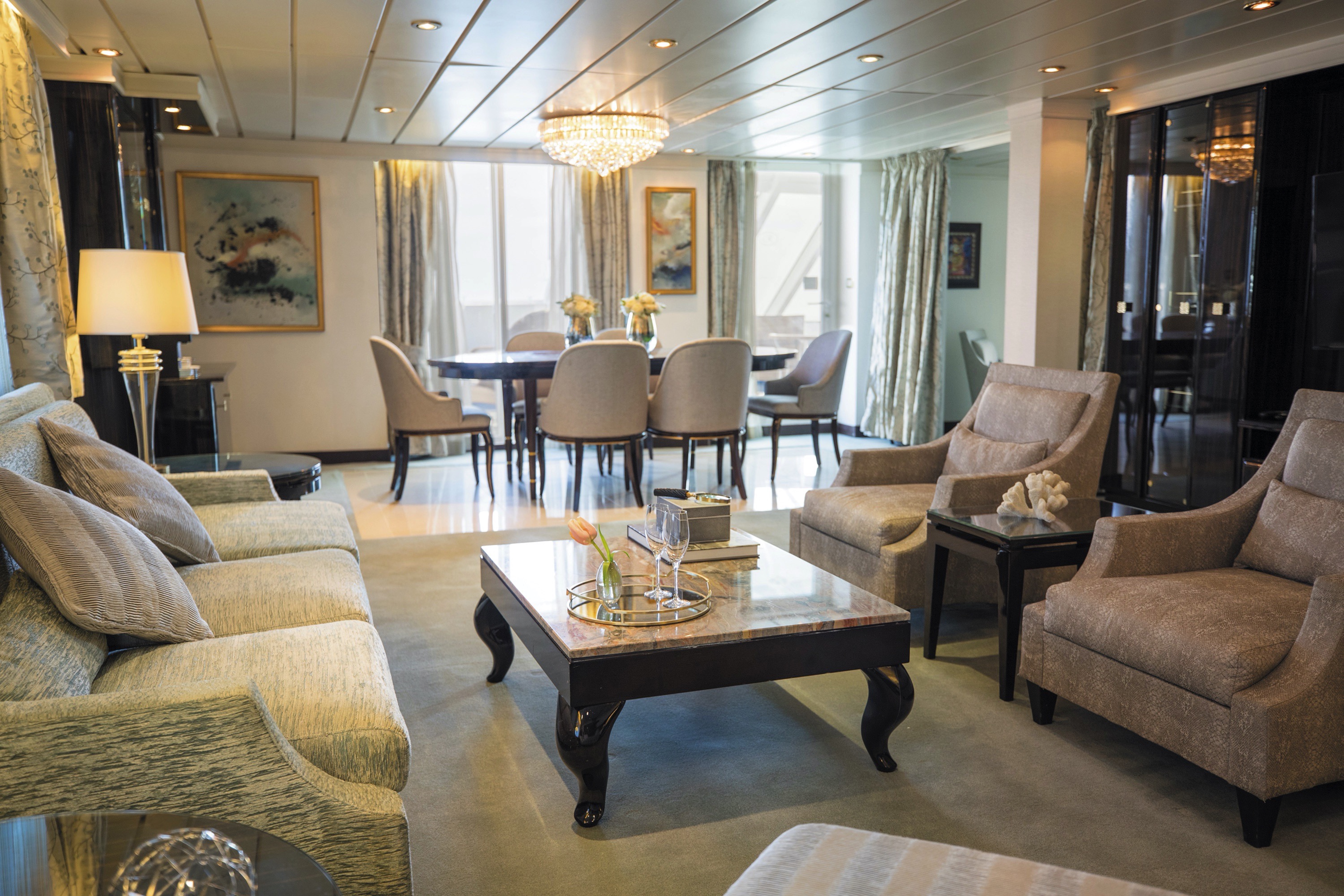
Signature Suite
You’ll find Park Avenue chic onboard Seven Seas Mariner® in this spectacular suite. Elegant rosewood furniture, luxe fabrics and a crystal chandelier create sophisticated comfort, while a personal butler is available to fulfil whatever requests you may have. With two bedrooms, two-and-a-half baths, a large living room and two private balconies, this sublime suite is perfect for hosting new friends in luxury.
Layout
- 2 Spacious Bedrooms with European King-Sized Elite Slumber™ Bed
- 2 1/2 Marble Bathrooms
- Spacious Living Room
- 2 Private Balconies
- Walk-in Closet With Safe
- Accommodates Up To 5 Guests
Amenities
- 1-Night Pre-Cruise Hotel Package Including:
– Ground Transfers
– Breakfast - – Porterage
- Unlimited WiFi includes up to four per suite
- 15 Minutes of Ship-to-Shore Phone Time
- Valet Laundry Service
- Choice of Guerlain, Acqua di Parma and L’Occitane® Jasmin & Bergamot Soaps, Shampoos and Lotions
- Guerlain Fragrance and Spongelle Buffer
- Personal Butler
- Priority Check-in on embarkation day with suite access at Noon
- Welcome Bottle of Premium Champagne
- Complimentary Pressing on First Night
- VIP Status to Include Dinner with a Senior Officer
- Welcome Letter from President and General Manager
- Complimentary Cocktail Party for 8
- Personalised In-Suite Full-Liquor Bar Set-Up
- 1 Sumptuous In-Suite Caviar Service
- Guaranteed Reservation Each Night in Specialty Restaurant of Your Choice†
- Complimentary 25-Minute Personal Fitness Session at the Serene Spa & Wellness™ Fitness Center
- 24-Hour Room Service with Specialty Restaurant Selections During Dining Hours
- Priority Online Shore Excursions and Dining Reservations
- 10% Discount on Premium Wine and Liquor
- 5% savings on Pre- or Post-Cruise Hotel or Land Programs
- 5% savings on Regent Choice Shore Excursions
- Selection of Bed Pillow Styles
- Selection of Fig and Tea Leaves Bath Salts
- Regent Plush Bathrobes and Slippers
- Daily Canapés
- Luxe Fruit Arrangement and Chocolate Leonidas
- Tea Forte Set-Up
- Personalised Stationery
- BOSE® SoundLink Mini II Bluetooth Speaker
- Complimentary Shore Excursion Bag
- Delivery of Up to Three Daily Newspapers
- World Atlas and Elegant Weather Clock
- Binoculars, illy® Espresso Maker and Cashmere Blankets
- Bath Scale
- Vanity and Hair Dryer
- Interactive Flat-Screen Television With Extensive Media Library, Complimentary Movies-on-Demand
- Direct Dial Satellite Phone
- Shoe Shine Service
- Essentials Including Men’s Unscented Shaving Kit, Facial Wipes, Sewing Kit, Emory Board, Stain Remover and Hand Sanitiser
- Complimentary Tote Bag
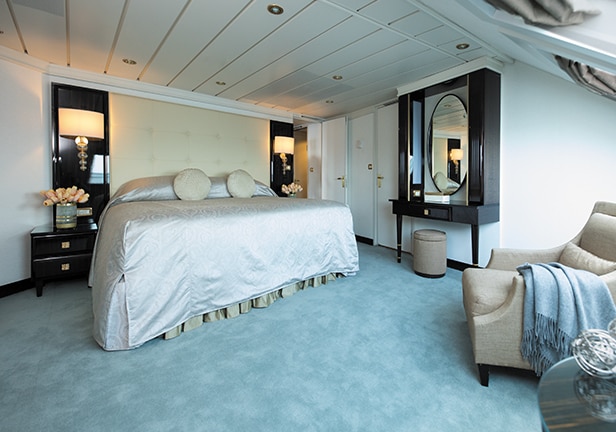
Grand Suite
Step into the richness of a dining area perfectly ensconced within a spacious, art-filled living room. Just outside is a private balcony with a table and chairs just right for in-suite breakfast. The private bedroom is large and inviting, its soothing color palette conducive to a peaceful night’s rest on your King-Sized Elite Slumber™ Bed. Two full baths and luxurious bath products invite you to indulge in unbridled ‘me time’.
Layout
- 1 Spacious Bedroom With European King-Sized Suite Slumber Bed®
- 2 Marble Bathrooms
- Spacious Living Room
- Private Balcony
- Walk-in Closet With Safe
- Accommodates Up To 3 Guests
Amenities
- 1-Night Pre-Cruise Hotel Package Including:
– Ground Transfers
– Breakfast
– Porterage - Unlimited WiFi includes up to four per suite
- 15 Minutes of Ship-to-Shore Phone Time
- Valet Laundry Service
- Choice of Guerlain, Acqua di Parma and L’Occitane® Jasmin & Bergamot Soaps, Shampoos and Lotions
- Guerlain Fragrance and Spongelle Buffer
- Personal Butler
- Priority Check-in on embarkation day with suite access at Noon
- Welcome Bottle of Premium Champagne
- Complimentary Pressing on First Night
- VIP Status to Include Dinner with a Senior Officer
- Welcome Letter from President and General Manager
- Complimentary Cocktail Party for 8
- Personalized In-Suite Full-Liquor Bar Set-Up
- 1 Sumptuous In-Suite Caviar Service
- Guaranteed Reservation Each Night in Specialty Restaurant of Your Choice†
- Complimentary 25-Minute Personal Fitness Session at the Serene Spa & Wellness™ Fitness Center
- 24-Hour Room Service with Specialty Restaurant Selections During Dining Hours
- Priority Online Shore Excursions and Dining Reservations
- 10% Discount on Premium Wine and Liquor
- 5% savings on Pre- or Post-Cruise Hotel or Land Programs
- 5% savings on Regent Choice Shore Excursions
- Selection of Bed Pillow Styles
- Selection of Fig and Tea Leaves Bath Salts
- Regent Plush Bathrobes and Slippers
- Daily Canapés
- Luxe Fruit Arrangement and Chocolate Leonidas
- Tea Forte Set-Up
- Personalized Stationery
- BOSE® SoundLink Mini II Bluetooth Speaker
- Complimentary Shore Excursion Bag
- Delivery of Up to Three Daily Newspapers
- World Atlas and Elegant Weather Clock
- Binoculars, illy® Espresso Maker and Cashmere Blankets
- Bath Scale
- Vanity and Hair Dryer
- Interactive Flat-Screen Television With Extensive Media Library, Complimentary Movies-on-Demand
- Direct Dial Satellite Phone
- Shoe Shine Service
- Essentials Including Men’s Unscented Shaving Kit, Facial Wipes, Sewing Kit, Emory Board, Stain Remover and Hand Sanitizer
- Complimentary Tote Bag
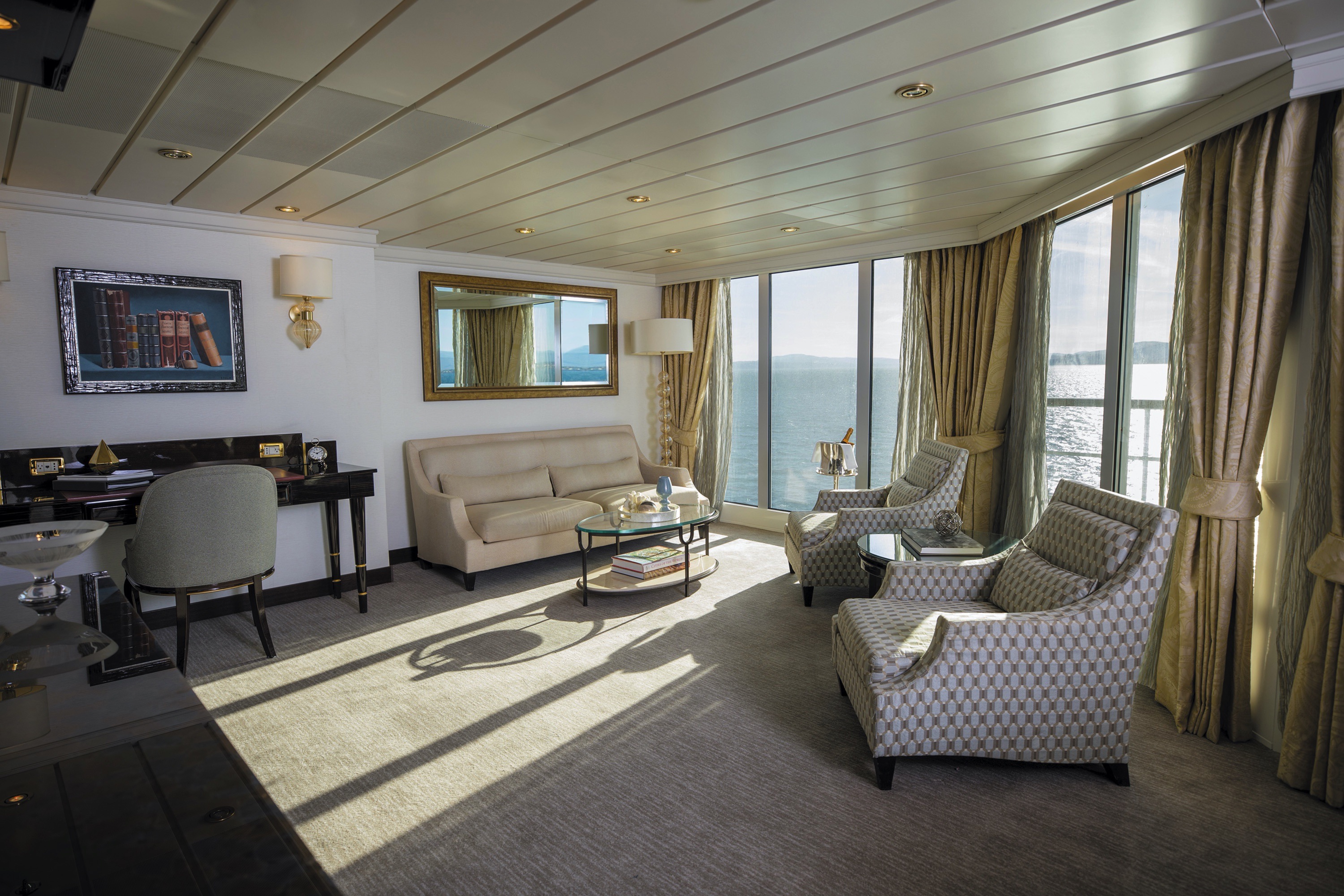
Mariner Suite
Spectacular panoramic views will seem to have been created just for you when you relax on your suite’s private balcony. Comfortably located mid-ship, this suite has a spacious separate bedroom with a European king-sized Elite Slumber™ bed and one-and-a-half baths. This suite features a spacious walk-in closet with drawers as well. To elevate your experience even more, a personal butler will be on call to help make your onboard wishes come true.
Layout
- 1 Spacious Bedroom With European King-Sized Suite Slumber Bed®
- 1 1/2 Marble Bathrooms
- Spacious Living Room
- Private Balcony
- Walk-in Closet With Safe
- Accommodates Up To 3 Guests
Amenities
- Valet Laundry Service
- 1-Night Pre-Cruise Hotel Package Including:
– Ground Transfers
– Breakfast
– Porterage - Unlimited WiFi includes up to four per suite
- 15 Minutes of Ship-to-Shore Phone Time
- Choice of Guerlain, Acqua di Parma and L’Occitane® Jasmin & Bergamot Soaps, Shampoos and Lotions
- Personal Butler
- Priority boarding on Embarkation Day with Suite Access at 1:00 pm
- Welcome Bottle of Premium Champagne
- Welcome Letter from President and General Manager
- Complimentary Pressing on First Night
- Luxe Fruit Arrangement
- Personalized In-Suite Full-Liquor Bar Set-Up
- 1 Sumptuous In-Suite Caviar Service
- 24-Hour Room Service
- Priority Online Shore Excursions and Dining Reservations
- 10% Discount on Premium Wine and Liquor
- 5% savings on Pre- or Post-Cruise Hotel or Land Programs
- 5% savings on Regent Choice Shore Excursions
- Selection of Bed Pillow Styles
- Selection of Fig and Tea Leaves Bath Salts
- Regent Plush Bathrobes and Slippers
- Daily Canapés
- Personalized Stationery
- BOSE® SoundLink Mini II Bluetooth Speaker
- Delivery of Up to Three Daily Newspapers
- World Atlas and Elegant Weather Clock
- Binoculars, illy® Espresso Maker and Cashmere Blankets
- Bath Scale
- Vanity and Hair Dryer
- Interactive Flat-Screen Television With Extensive Media Library, Complimentary Movies-on-Demand
- Direct Dial Satellite Phone
- Shoe Shine Service
- Essentials Including Men’s Unscented Shaving Kit, Facial Wipes, Sewing Kit, Emory Board, Stain Remover and Hand Sanitizer
- Complimentary Tote Bag
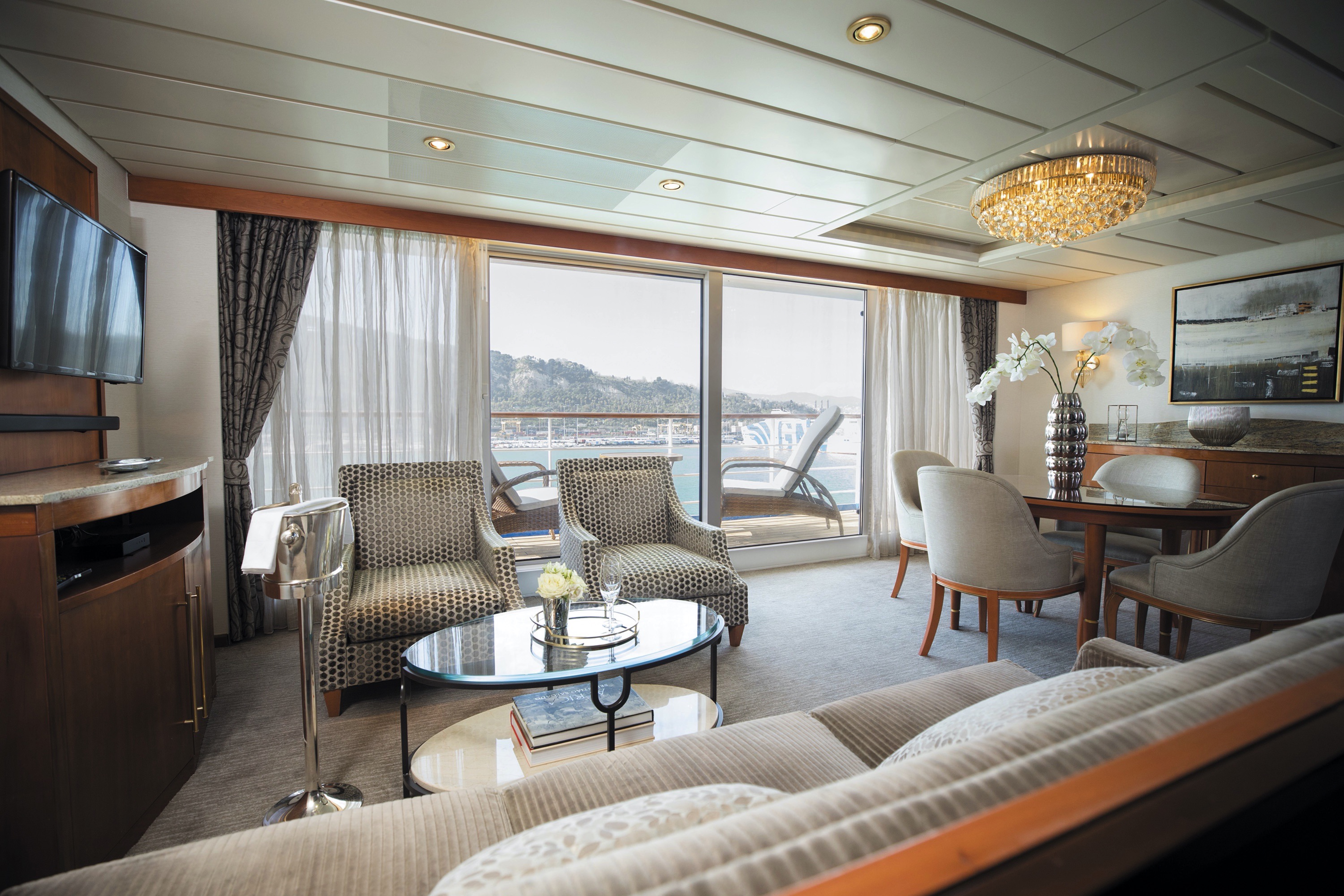
Seven Seas Suite
This suite welcomes you with soothing colours, pleasing artwork and comfortable furnishings. Relax in the sitting area after an exciting day ashore and enjoy the selection of fresh canapés delivered by your personal butler. Then retreat to your private balcony to watch the ever-changing vistas and ponder your next destination. Up to one-and-a-half baths feature fine marble accents and a tub or walk-in shower.
Layout
- 1 Spacious Bedroom With European King-Sized Suite Slumber Bed®
- 1 1/2 Marble Bathrooms
- Living Area
- Private Balcony
- Walk-in Closet With Safe
- Accommodates Up To 3 Guests
Amenities
- Valet Laundry Service
- 1-Night Pre-Cruise Hotel Package Including:
– Ground Transfers
– Breakfast
– Porterage - Unlimited WiFi includes up to four per suite
- 15 Minutes of Ship-to-Shore Phone Time
- Choice of Guerlain, Acqua di Parma and L’Occitane® Jasmin & Bergamot Soaps, Shampoos and Lotions
- Personal Butler
- Priority boarding on Embarkation Day with Suite Access at 1:00 pm
- Welcome Bottle of Champagne with
- Fresh Floral Arrangement
- Complimentary Pressing on First Night
- Luxe Fruit Arrangement
- In-Suite Mini-Bar Set-Up and Refill
- 24-Hour Room Service
- Priority Online Shore Excursions and Dining Reservations
- 10% Discount on Premium Wine and Liquor
- 5% savings on Pre- or Post-Cruise Hotel or Land Programs
- 5% savings on Regent Choice Shore Excursions
- Selection of Bed Pillow Styles
- Selection of Fig and Tea Leaves Bath Salts
- Regent Plush Bathrobes and Slippers
- Daily Canapés
- Personalized Stationery
- BOSE® SoundLink Mini II Bluetooth Speaker
- Elegant Weather Clock
- Binoculars, illy® Espresso Maker and Cashmere Blankets
- Vanity and Hair Dryer
- Interactive Flat-Screen Television With Extensive Media Library, Complimentary Movies-on-Demand
- Direct Dial Satellite Phone
- Shoe Shine Service
- Essentials Including Men’s Unscented Shaving Kit, Facial Wipes, Sewing Kit, Emory Board, Stain Remover and Hand Sanitizer
- Complimentary Tote Bag
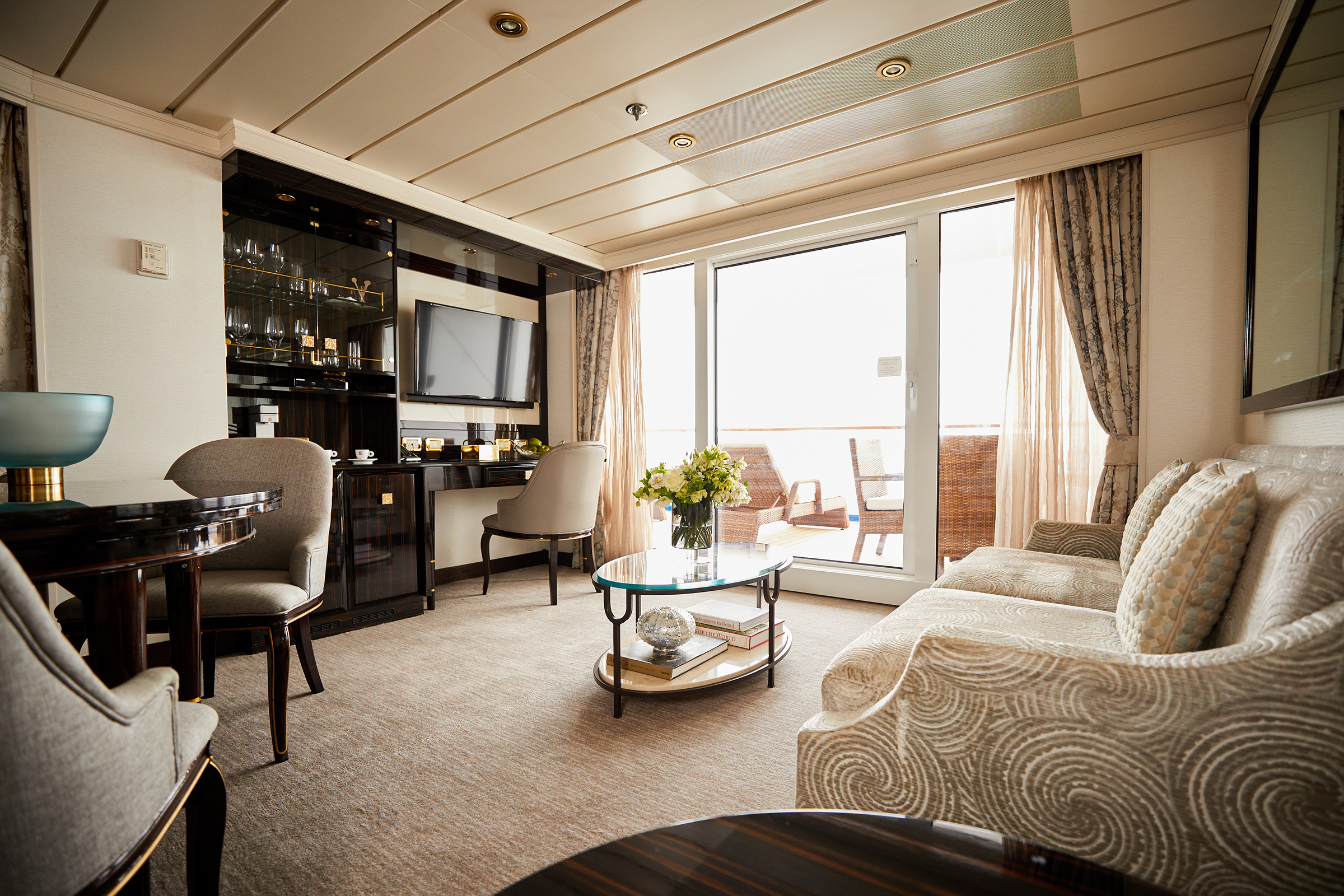
Horizon View Suite
Located along the stern of Seven Seas Mariner®, this suite offers a panoramic vista and expansive balcony that is large enough for two cushioned chaises, two chairs and a table. Inside, the bed alcove is separated from a beautifully appointed sitting area by curtains, allowing you to control how much sunlight greets you each morning. You’ll also have a personal butler attending to your needs and a bevy of luxurious amenities.
Layout
- 1 Spacious Bedroom with European King-Sized Elite Slumber™ Bed
- 1 Marble Bathroom
- Intimate Sitting Area
- Private Balcony
- Walk-in Closet With Safe
- Accommodates Up To 3 Guests
Amenities
- Valet Laundry Service
- 1-Night Pre-Cruise Hotel Package Including:
– Ground Transfers
– Breakfast
– Porterage - Unlimited WiFi includes up to four per suite
- 15 Minutes of Ship-to-Shore Phone Time
- Choice of Guerlain and L’Occitane® Jasmin & Bergamot Soaps, Shampoos and Lotions
- Personal Butler
- Access to your suite on embarkation day at 1:00 pm
- Welcome Bottle of Champagne with
- Fresh Floral Arrangement
- Complimentary Pressing on First Night
- Luxe Fruit Arrangement
- Personalized In-Suite Mini-Bar Set-Up
- 24-Hour Room Service
- Priority Online Shore Excursions and Dining Reservations
- 10% Discount on Premium Wine and Liquor
- 5% savings on Pre- or Post-Cruise Hotel or Land Programs
- 5% savings on Regent Choice Shore Excursions
- Selection of Bed Pillow Styles
- Regent Plush Bathrobes and Slippers
- Daily Canapés
- Personalized Stationery
- BOSE® SoundLink Mini II Bluetooth Speaker
- Elegant Weather Clock
- Binoculars, illy® Espresso Maker and Cashmere Blankets
- Vanity and Hair Dryer
- Interactive Flat-Screen Television With Extensive Media Library, Complimentary Movies-on-Demand
- Direct Dial Satellite Phone
- Shoe Shine Service
- Essentials Including Men’s Unscented Shaving Kit, Facial Wipes, Sewing Kit, Emory Board, Stain Remover and Hand Sanitizer
- Complimentary Tote Bag
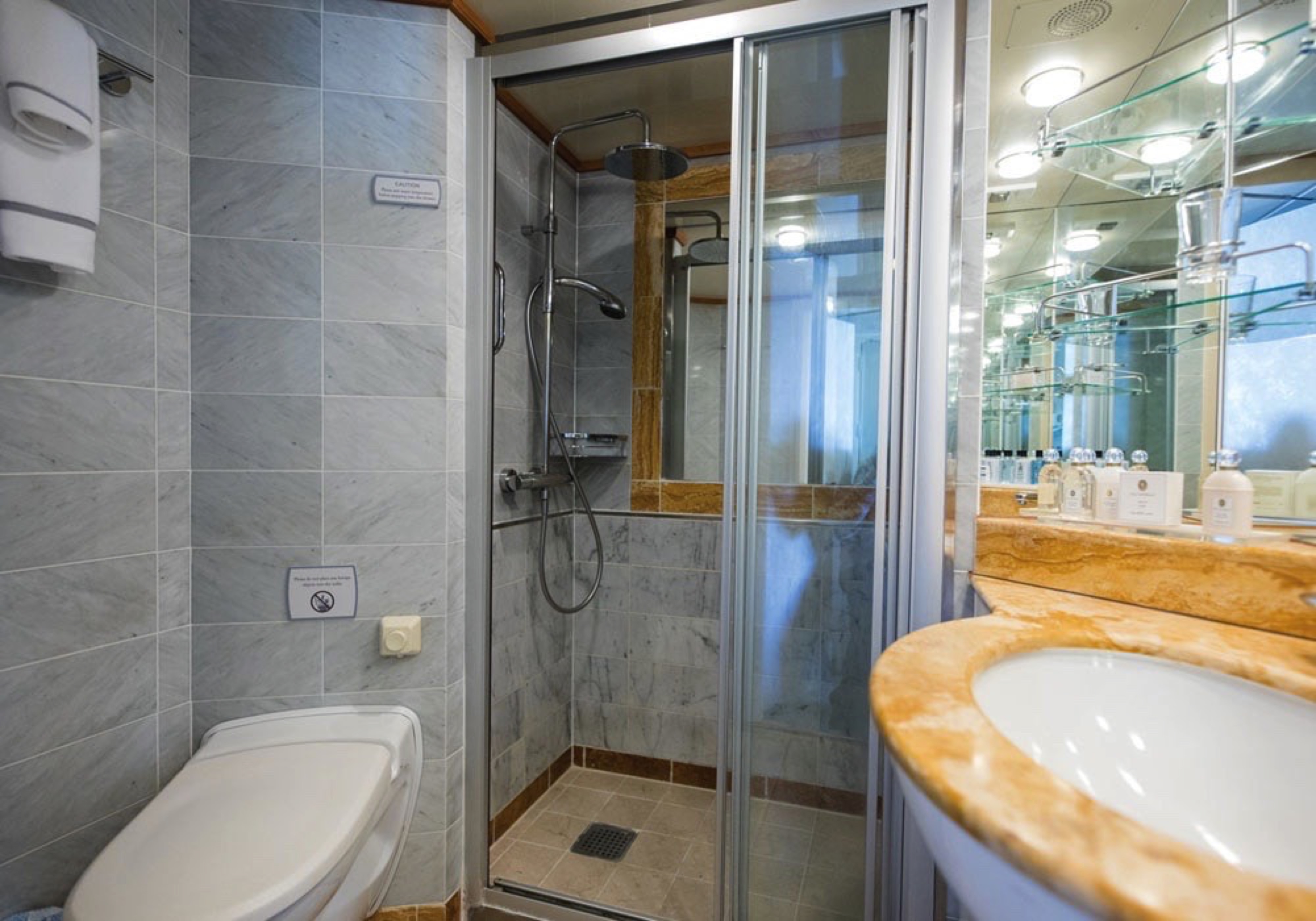
Penthouse Suite
The luxurious suite has been carefully designed to maximise space and comfort. Relax on your private balcony and indulge in your lavish bath amenities as you recharge and ready yourself for new adventures in the next port of call. This suite also includes priority online reservations for shore excursions and dining, and you’re encouraged to call on the services of a personal butler for special requests.
Layout
- European King-Sized Suite Slumber Bed®
- 1 Marble Bathroom
- Intimate Sitting Area
- Private Balcony
- Walk-in Closet With Safe
- Accommodates Up To 3 Guests
Amenities
- Valet Laundry Service
- 1-Night Pre-Cruise Hotel Package Including:
– Ground Transfers
– Breakfast
– Porterage - Unlimited WiFi includes up to four per suite
- 15 Minutes of Ship-to-Shore Phone Time
- Guerlain & L’Occitane® Jasmin & Bergamot Soaps, Shampoos and Lotions
- Personal Butler
- Welcome Bottle of Champagne with Fresh Fruit Arrangement
- Complimentary Pressing on First Night
- In-Suite Mini-Bar Set-Up and Refill
- 24-Hour Room Service
- Priority Online Shore Excursions and Dining Reservations
- 10% Discount on Premium Wine and Liquor
- 5% savings on Pre- or Post-Cruise Hotel or Land Programs
- 5% savings on Regent Choice Shore Excursions
- Selection of Bed Pillow Styles
- Regent Plush Bathrobes and Slippers
- Daily Canapés
- Personalized Stationery
- BOSE® SoundLink Mini II Bluetooth Speaker
- Binoculars, illy® Espresso Maker and Cashmere Blankets
- Vanity and Hair Dryer
- Interactive Flat-Screen Television With Extensive Media Library, Complimentary Movies-on-Demand
- Direct Dial Satellite Phone
- Shoe Shine Service
- Essentials Including Men’s Unscented Shaving Kit, Facial Wipes, Sewing Kit, Emory Board, Stain Remover and Hand Sanitizer
- Complimentary Tote Bag

Concierge Suite
In this superbly designed suite, you enjoy the comfort of richly furnished accommodations as well as exclusive luxuries available only in suites at the Concierge level and higher. Your suite includes amenities such as an illy® espresso maker and cashmere blankets, perfect for use in the morning when you wish to sip coffee and enjoy an in-suite breakfast on your private balcony. Take advantage of 24-hour room service when the mood strikes.
Layout
- European King-Sized Suite Slumber Bed®
- 1 Marble Bathroom
- Intimate Sitting Area
- Private Balcony
- Walk-in Closet With Safe
- Accommodates Up To 3 Guests
This category includes Accessibility Options in suites 1012 and 1013. For more information about accessible suites click here.
Amenities
- Valet Laundry Service
- 1-Night Pre-Cruise Hotel Package Including:
– Ground Transfers
– Breakfast
– Porterage - Unlimited WiFi includes up to four per suite
- 15 Minutes of Ship-to-Shore Phone Time
- L’Occitane® Jasmin & Bergamot Soaps, Shampoos and Lotions
- Welcome Bottle of Champagne with Fresh Fruit Arrangement
- In-Suite Mini-Bar Set-Up and Refill
- 24-Hour Room Service
- Priority Online Shore Excursions and Dining Reservations
- 10% Discount on Premium Wine and Liquor
- 5% savings on Pre- or Post-Cruise Hotel or Land Programs
- 5% savings on Regent Choice Shore Excursions
- Regent Plush Bathrobes and Slippers
- Binoculars, illy® Espresso Maker and Cashmere Blankets
- Vanity and Hair Dryer
- Interactive Flat-Screen Television With Extensive Media Library, Complimentary Movies-on-Demand
- Direct Dial Satellite Phone
- Shoe Shine Service
- Complimentary Tote Bag
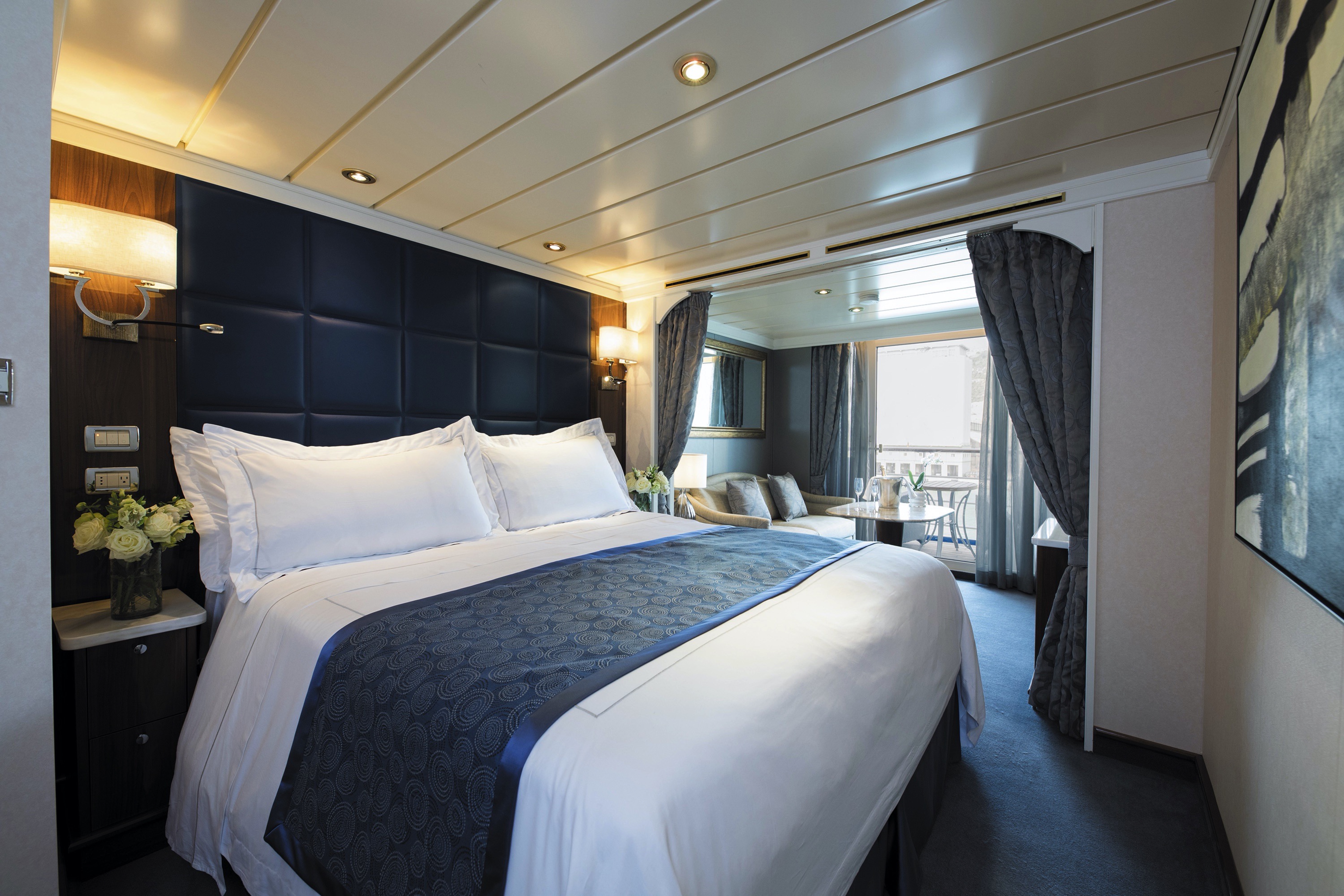
Deluxe Veranda Suite
Every inch of this suite has been thoughtfully designed to maximize interior space and embrace the magnificent scenery outdoors. From the sitting area, admire the ocean views through the floor-to-ceiling windows, or better yet, take a seat outside on your private balcony to watch the world go by. Elegant finishes such as luxurious bedding and beautiful marble detailing in the bath further enhance your comfort.
Layout
- European King-Sized Suite Slumber Bed®
- 1 Marble Bathroom
- Intimate Sitting Area
- Private Balcony
- Walk-in Closet With Safe
- Accommodates Up To 3 Guests
This category includes Accessibility Options in suites 828 and 829. For more information about accessible suites click here.
Amenities
- Valet Laundry Service
- Unlimited WiFi includes two logins per suite*
- Welcome Bottle of Champagne with Fresh Fruit Arrangement
- In-Suite Mini-Bar Set-Up and Refill
- 24-Hour Room Service
- L’Occitane® Soaps, Shampoos and Lotions
- Regent Bathrobes and Slippers
- Vanity and Hair Dryer
- Interactive Flat-Screen Television With Extensive Media Library, Complimentary Movies-on-Demand
- Direct Dial Satellite Phone
- Shoe Shine Service

Regent Suite
Incomparable craftsmanship and meticulous attention to detail are evident everywhere – from the suite’s unique design choices, such as rare works of art, to grand features like an in-suite spa retreat and Steinway piano. The only thing to rival the luxurious interior that includes two magnificent bedrooms is the spectacular ocean view from private balconies that include a Tresse Minipool high atop the ship.
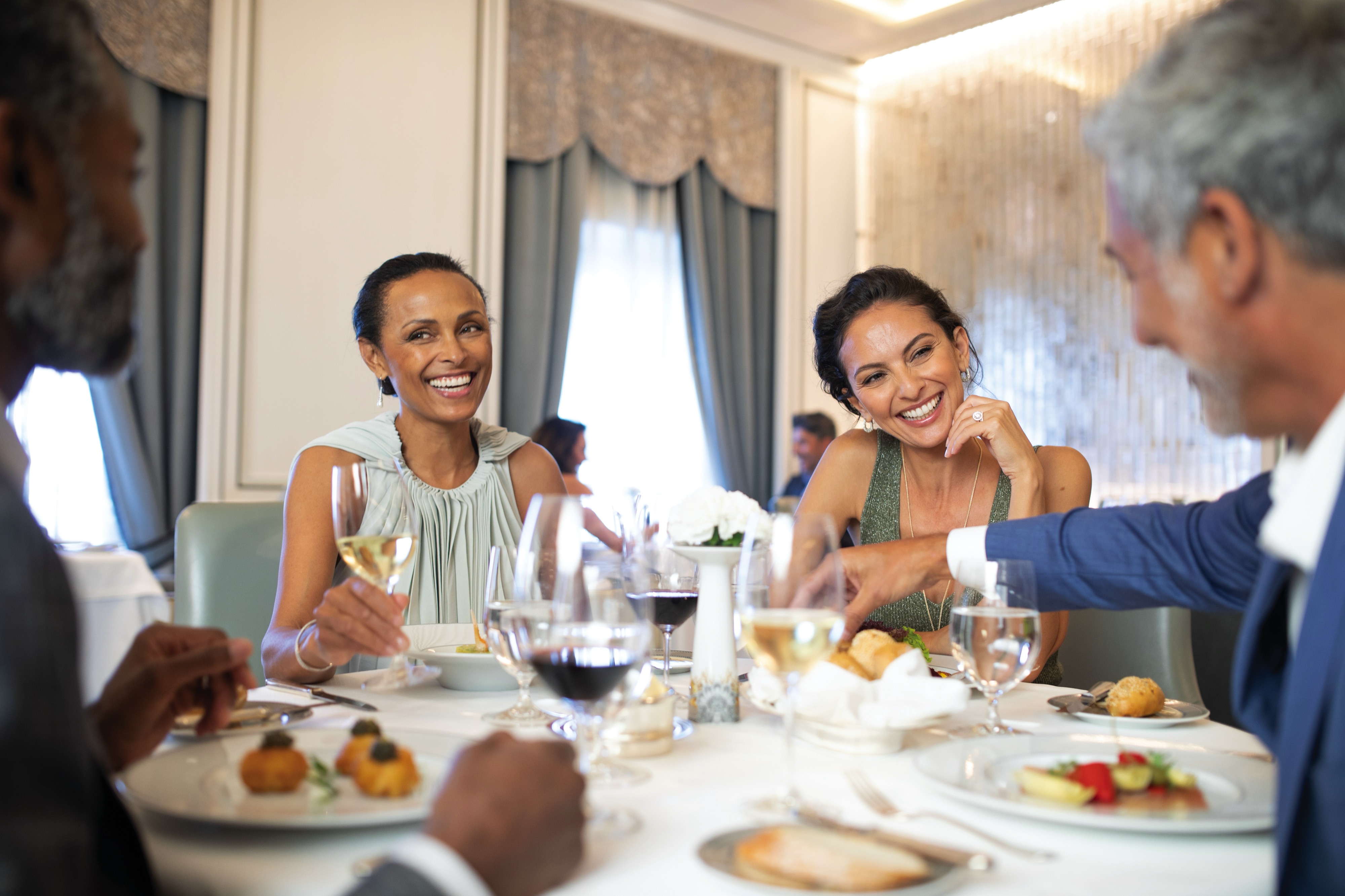
Compass Rose
Whether you arrive for breakfast, lunch or dinner, you can look forward to European-inspired Continental cuisine served in a beautifully refined atmosphere decorated in blues and silvers with stunning Versace tableware.
As the flagship restaurant aboard each of our ships, the wonderfully spacious Compass Rose serves breakfast, lunch and dinner and features an exceptional variety of European-inspired Continental cuisine, as well as flavorful vegetarian and kosher dishes. Elegantly decorated in blues and silvers with stunning Versace tableware, Compass Rose delights with a beautifully refined atmosphere bathed in natural light during the day.
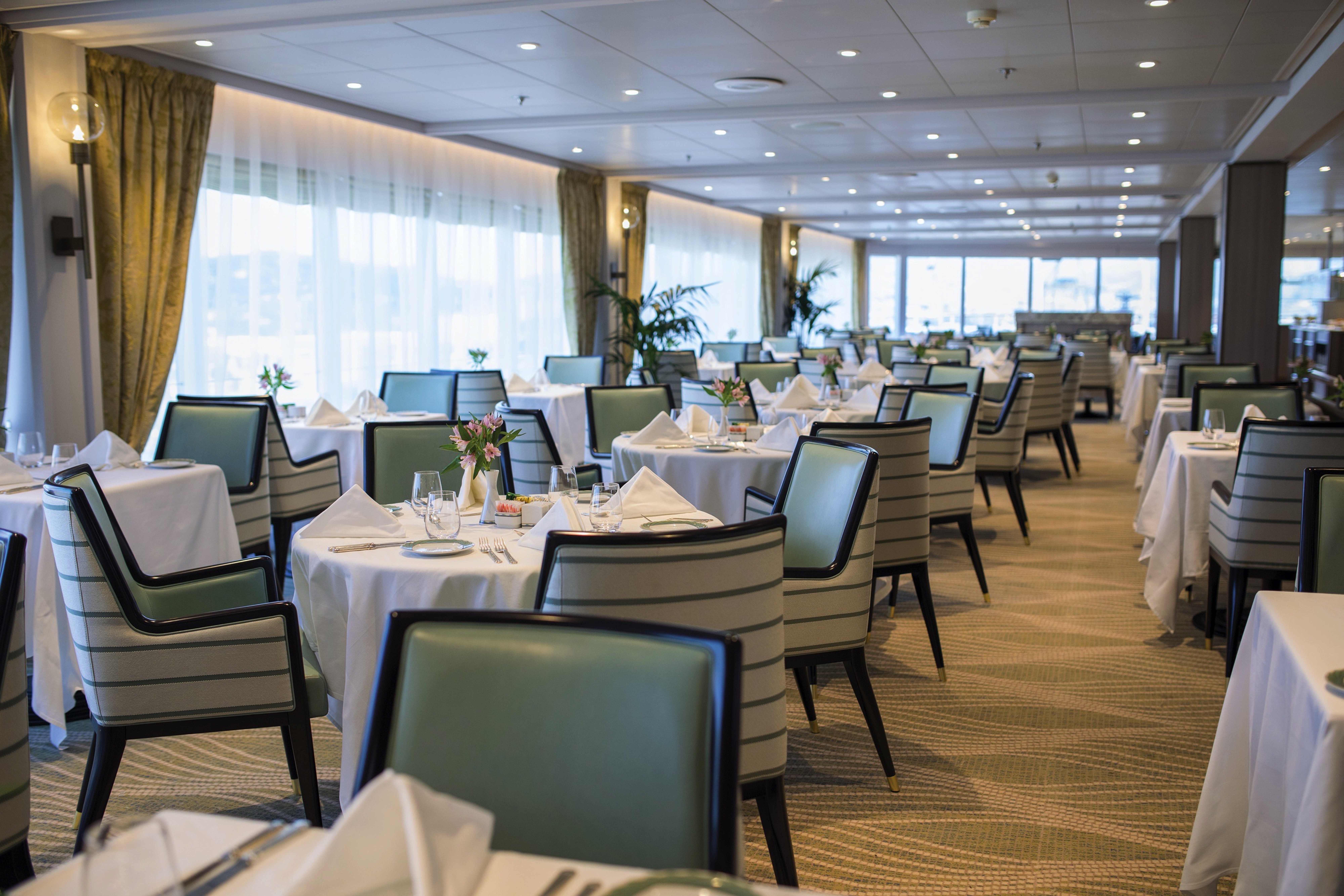
La Veranda
La Veranda features quiet alcoves, made-to-order omelettes and tasty lunch buffets that include hot carving stations, an authentic pizzeria and regional specialties that reflect cuisines of the region you’re visiting.
Serving breakfast and lunch, you’ll find La Veranda to be a popular eating spot any time of day. Spacious and comfortably casual, La Veranda offers regional specialties that often reflect the cuisines of the countries called on. Dishes are presented in a buffet style that displays the diversity of the menu. La Veranda also features an authentic pizzeria and a shaded, open-air veranda for dining al fresco.
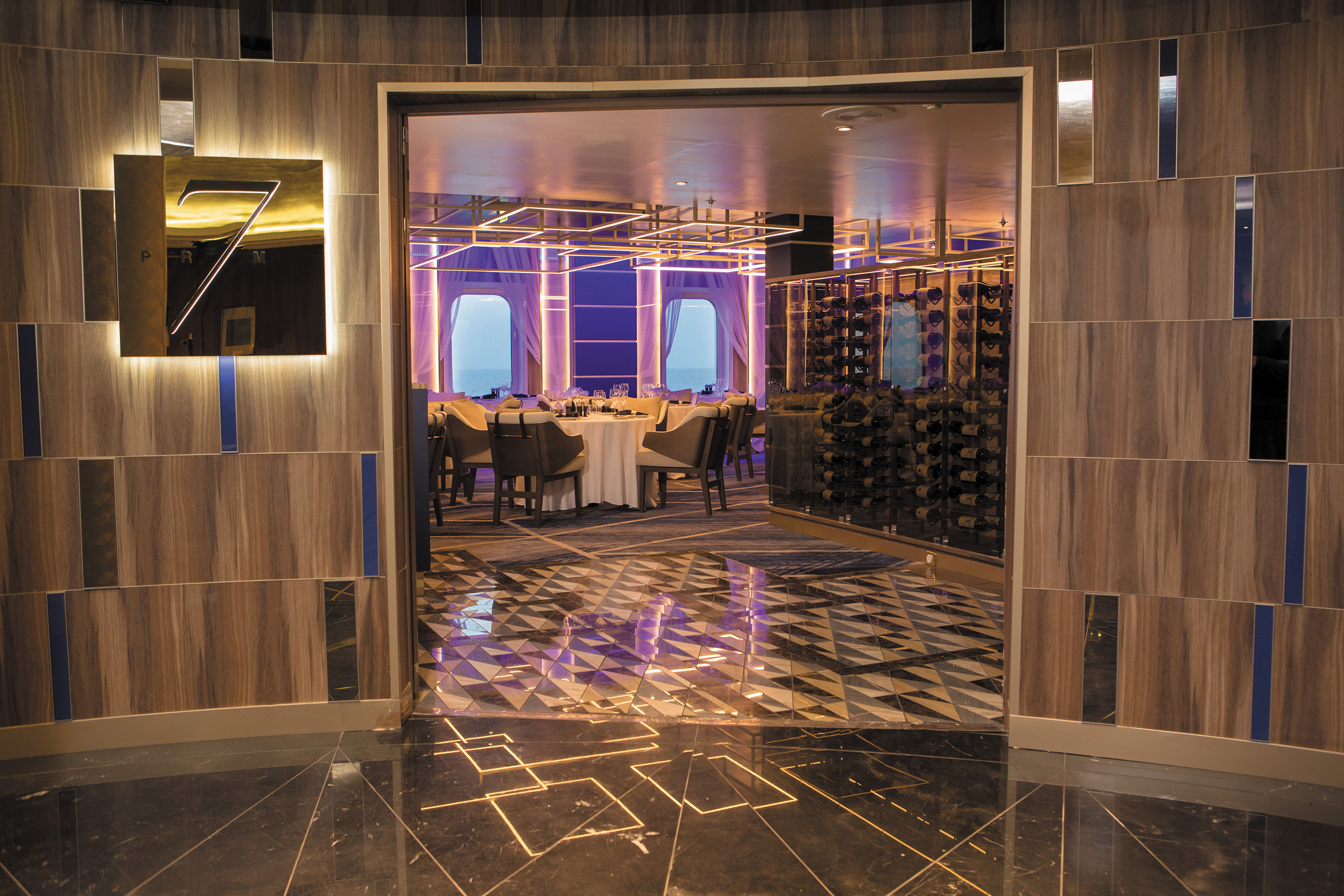
Prime 7
Vibrant blue colours and white-leather chairs heighten the senses as you enter this elegantly intimate, art-filled and luxurious setting to enjoy classic American steakhouse cuisine with a modern flair. Open for dinner only.
A true classic that sets a new standard in American steakhouse fare. Handsomely decorated throughout, Prime 7 on Seven Seas Mariner® welcomes you with a vibrant blue palette set off with white-leather chairs, dazzling the eyes as your appetite gets serious. Dine on expertly prepared filet mignon and cote de boeuf, accompanied by tantalising sides to share and topped off with expert wine recommendations. Prime 7 is open for dinner only.
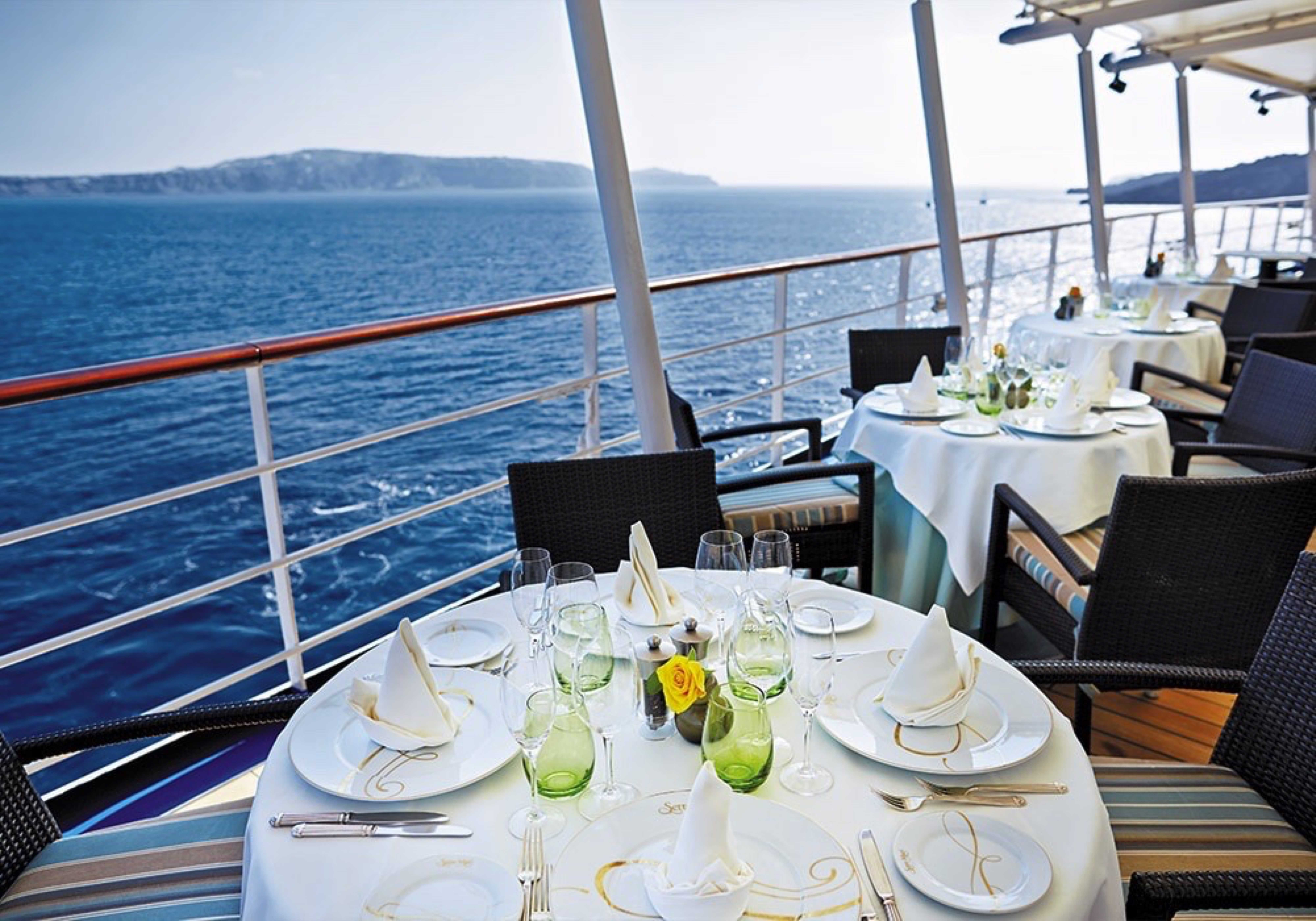
Sette Mari at La Veranda
Each evening, La Veranda transforms into Sette Mari at La Veranda, a casual, intimate dining experience. Enjoy an extensive menu of authentic antipasti and Italian specialties served á la carte and paired with fine Italian wines — complimentary of course.
Each evening, La Veranda transforms into Sette Mari at La Veranda, a casual, intimate dining experience. Enjoy an extensive menu of authentic antipasti and Italian specialties served á la carte and paired with fine Italian wines — complimentary of course. Delectable dishes are prepared á la minute by our talented chefs using only the freshest gourmet ingredients and served by our attentive waiters. Sette Mari at La Veranda is open for dinner only.
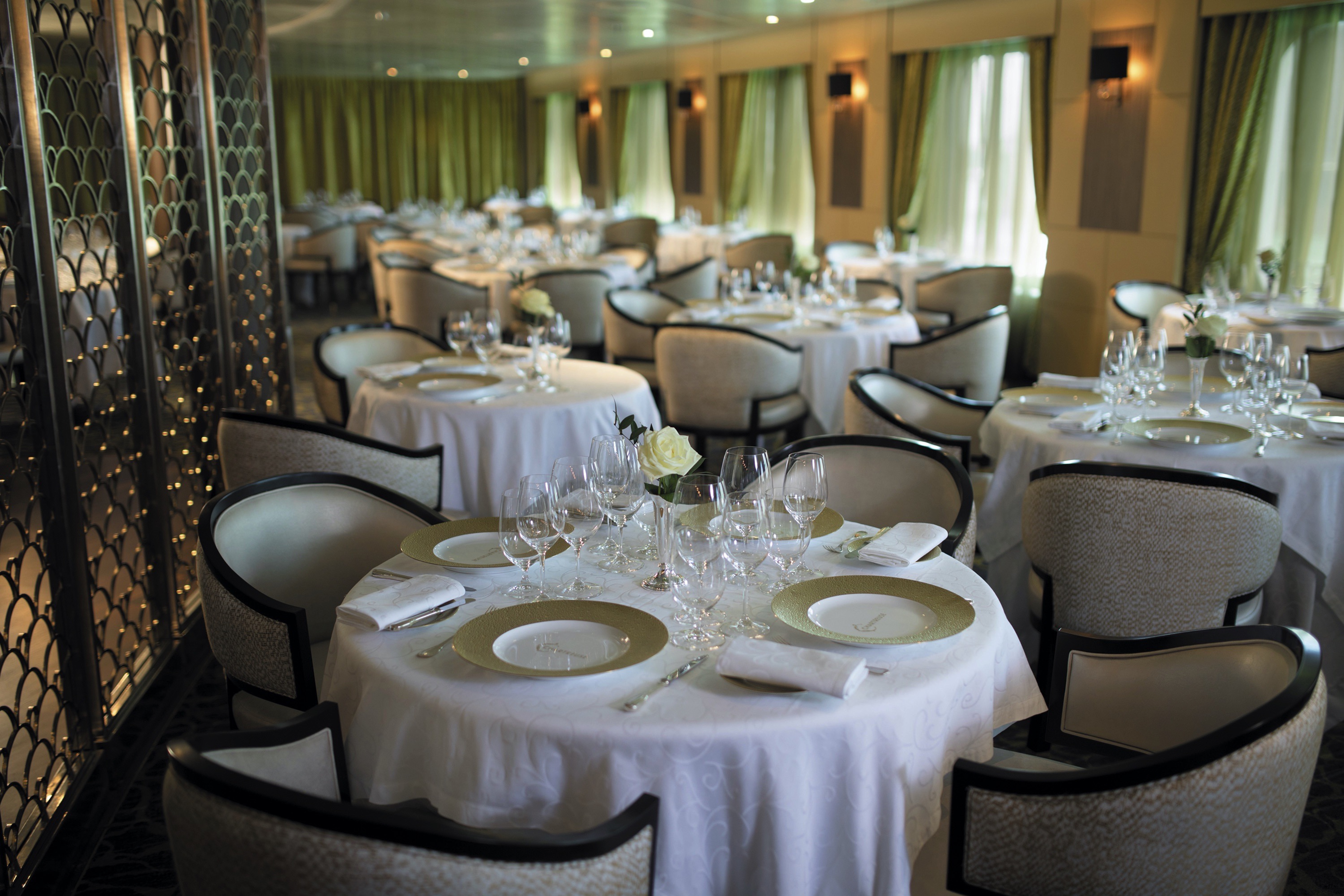
Chartreuse
A restaurant with a modern French menu and attention to detail you’ll notice in its Parisian décor, expertly prepared dishes and wait staff. About the closest thing to a Parisian culinary gem on the high seas.
Tucked away off of Horizon Lounge, Chartreuse is a hidden gem featuring modern French fare with attentive servers and a maître d’ on hand to ensure your dining experience is flawless and accompanied by the finest French wines. The menu beckons with a variety of ‘new’ flavours such as a veal rack of loin with caramelised endive, grape chutney and the earthy tones of a walnut veal jus sauce.
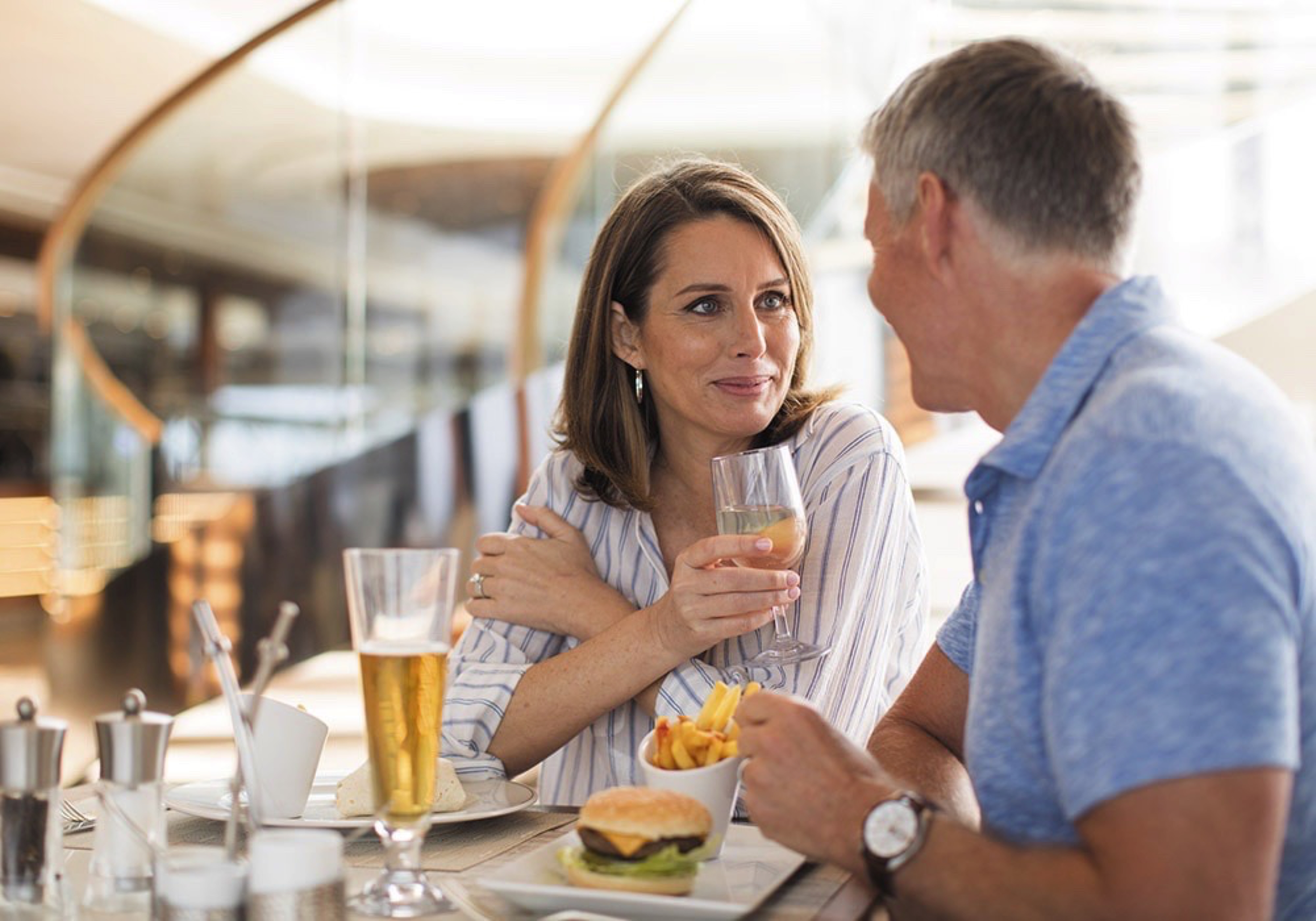
Pool Grill
After sunbathing or swimming in the pool, you may be in the mood for grilled-to-order burgers, seafood, sandwiches, even hand-dipped ice cream with sprinkles. Our Pool Grill will satisfy your comfort food cravings.
The Pool Grill is truly a come-as-you-are venue. Enjoy this casual dining experience whether you’re getting a bite after sunbathing or swimming in the pool. The Pool Grill is open-air, yet abundantly shaded for comfortable dining at lunch or dinner. Enjoy grilled-to-order burgers, grilled seafood, sandwiches, and fresh salads. Treat yourself to milkshakes and malts or an old-fashioned hand-dipped ice cream dessert with toppings.
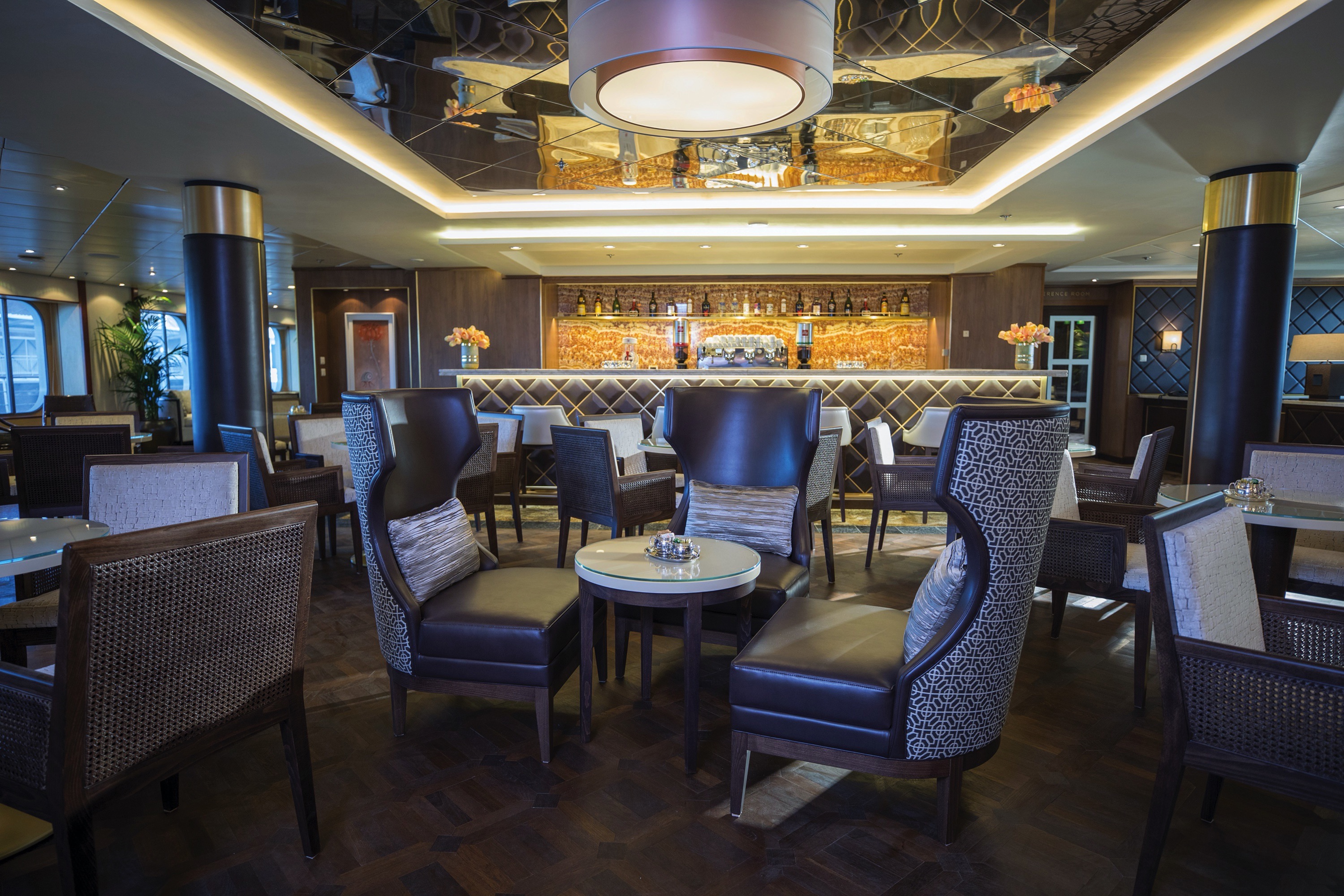
Coffee Connection
Enjoy barista-made coffees, delicious pastries, gourmet sandwiches and homemade cookies at Coffee Connection. Peruse international newspapers or strike up a conversation with new friends.
Your informal destination to relax, meet fellow guests and enjoy coffee and snacks throughout the day. Hungry? Cereals, fruits, pastries and bagels are available every morning. Lunch includes cold cuts, cheeses, assorted rolls and cookies. Sandwiches, fruit and fresh cookies and cakes are available all day. While snacking, international newspapers are available for your perusal.
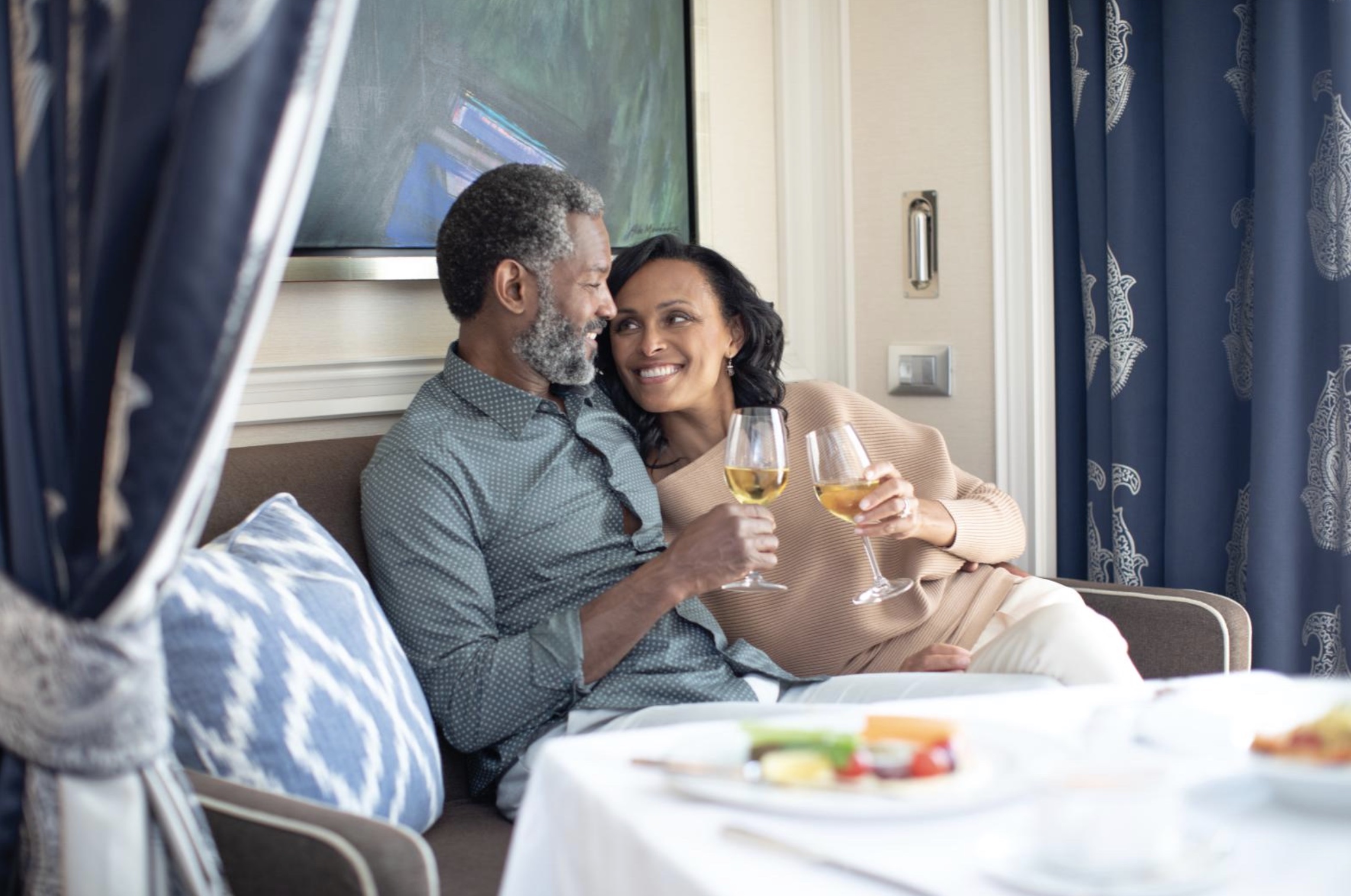
Room Service
Enjoy delectable appetisers, main courses and desserts in your suite 24 hours a day. During dinner hours, delight in ordering dishes made to your exact taste from the expansive Compass Rose menu.
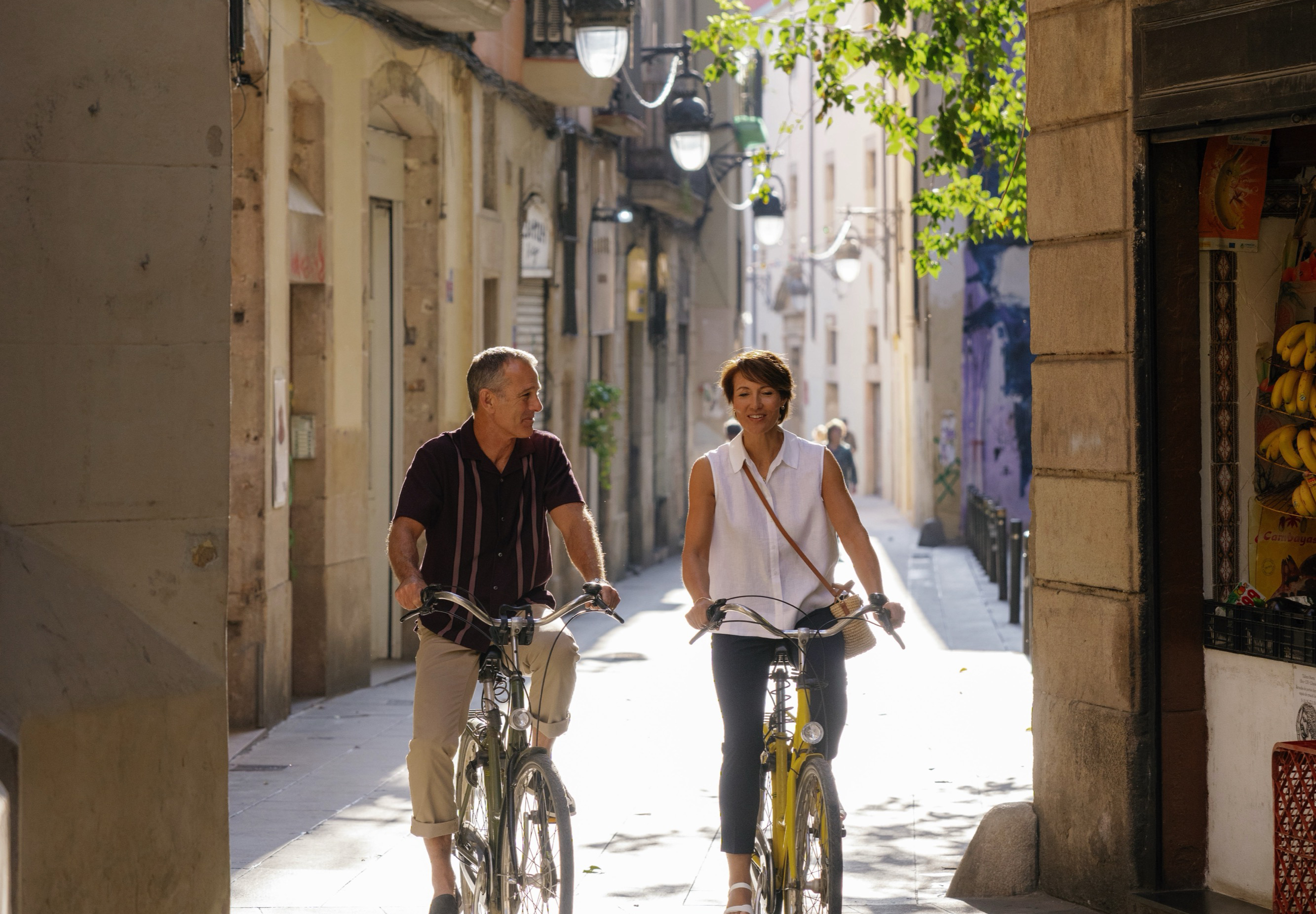
Gourmet Explorer Tours
Our distinctive Gourmet Explorer Tours, offered exclusively aboard Seven Seas Explorer, allows guests the unique opportunity to experience the culinary culture of the world’s most delicious destinations. From savouring the authentic flavours of a region to learning new techniques in local cooking classes, guests can choose from a variety of optional tours that take them to local markets to find exotic spices, sample delicious wines at breathtaking estates and savor gourmet meals expertly prepared by renowned chefs. Due to their unique itineraries, Gourmet Explorer tours require a discounted, supplementary charge.
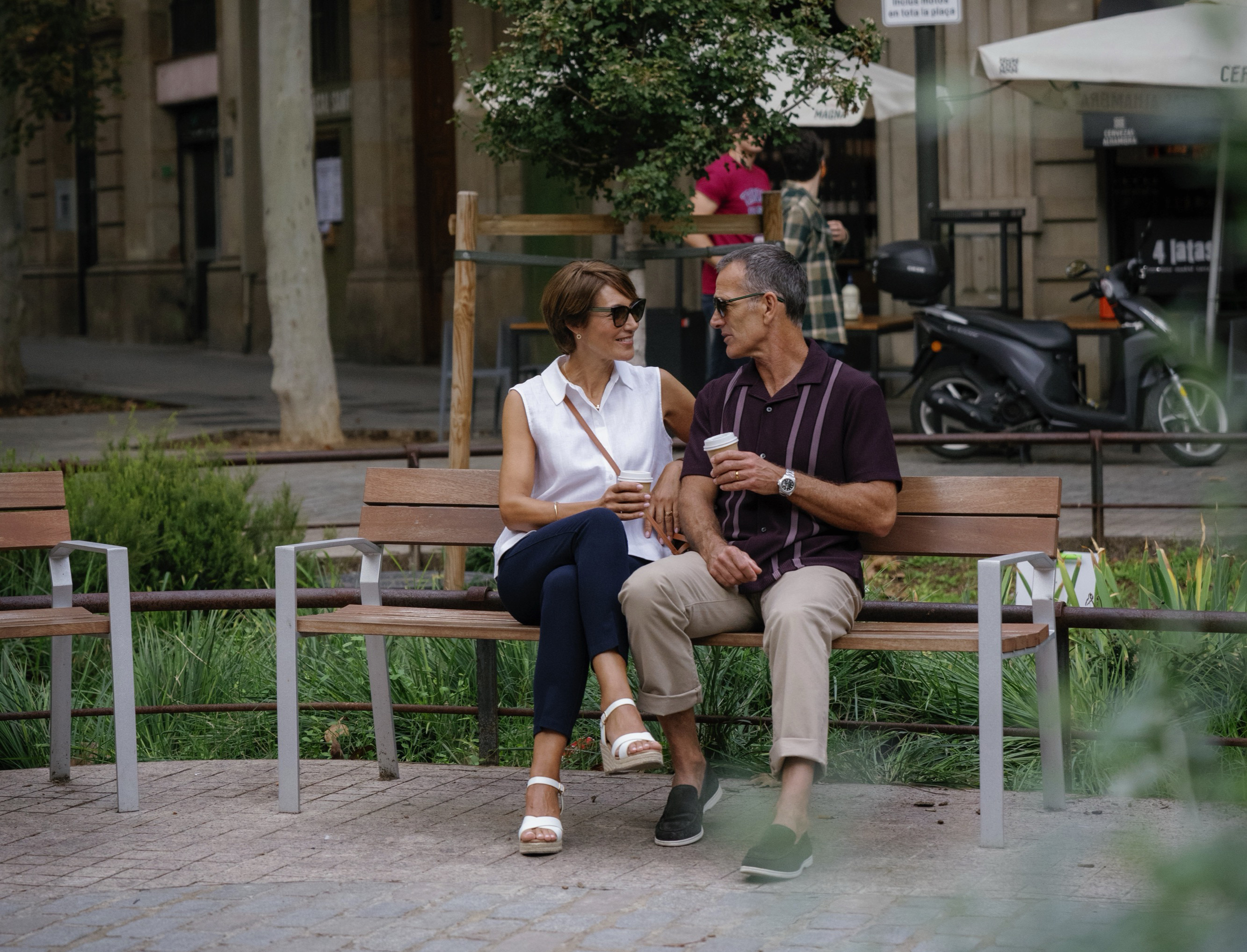
Regent Choice Shore Excursions
Take your experience to another level with the select itineraries and smaller group tours offered by our Regent Choice Shore Excursions. These unique opportunities require a discounted, supplementary charge and invite you to discover the heights of travel, from our Gourmet Explorer Tours to special experiences that take you off the beaten path.
As the name suggests, these excursions work a little harder to engage your explorer spirit. Unique itineraries and smaller groups create more personal experiences… and memories of a lifetime.
UNIQUE, UNPARALLELED EXPERIENCES
Soaring over Alaskan forests and mountains via helicopter en route to feeling the majesty of Mendenhall Glacier beneath your feet. Discover the best our world has to offer through the unparalleled experiences you’ll enjoy with Regent Choice Shore Excursions.
Enhance your shoreside experience with a Regent Choice Small Group tour. Hosting up to 16 guests, these tours provide a more intimate experience and allow for more personal engagement with your knowledgeable guide.
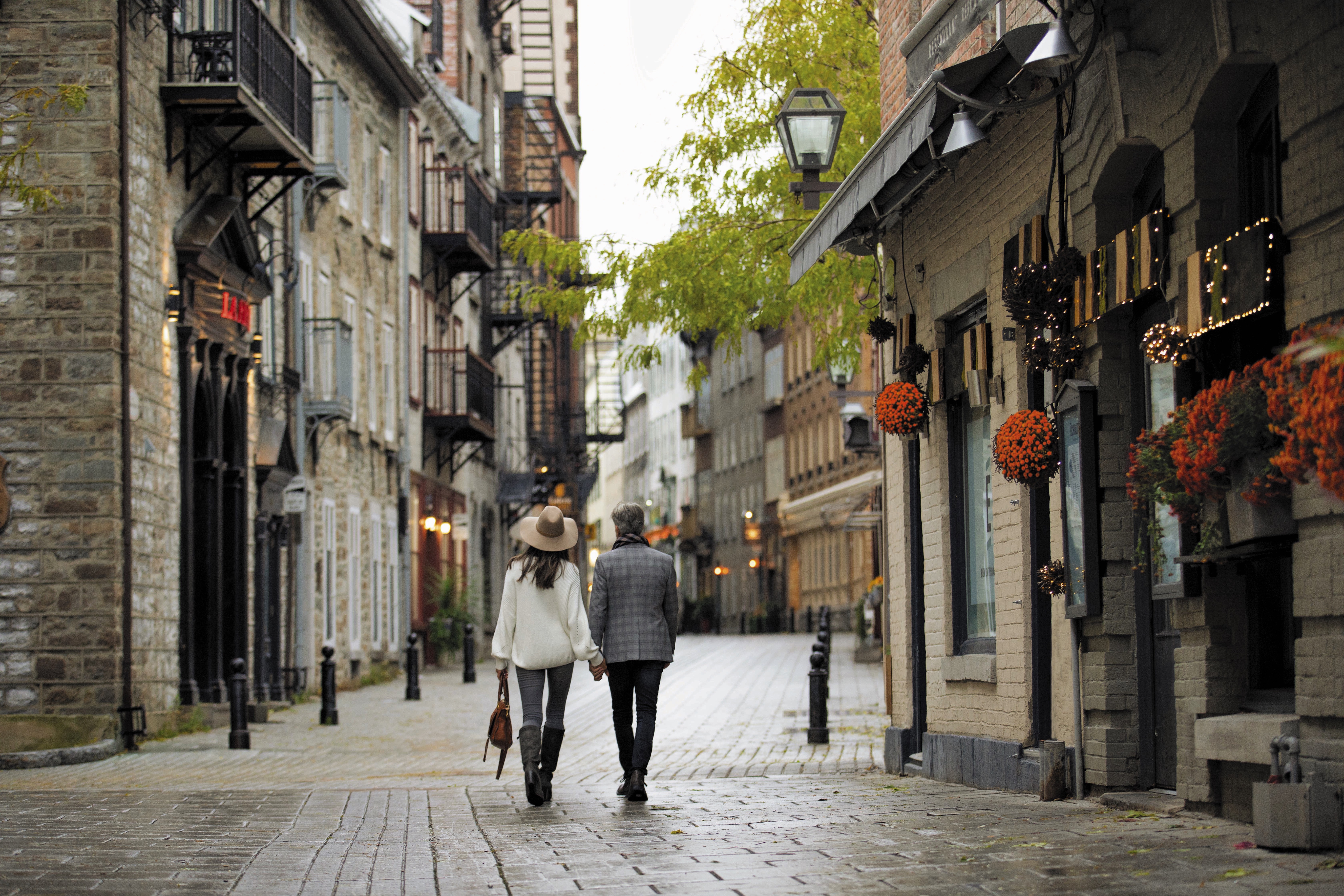
Unlimited Shore Excursions Included
Every destination we sail to harbours treasured experiences waiting to be unearthed. And there’s no better way to dig in than by taking advantage of our hallmark inclusion of thousands of wonderful, Unlimited Shore Excursions.
MAKE YOUR VACATION YOUR OWN
When your feet touch the ground, your cruise enters a new dimension. What’s your preference? Exploring the world’s great cities? Immersing yourself in local culture? Or indulging your inner beach bum? Over 4,500 Unlimited Shore Excursions across every region of the world allow you to embrace it all.
Wherever you’re traveling, opportunities to maximise memories abound. Whether it’s urban adventures brimming with history, architecture and culture or escapes to natural wonders that stagger the senses, our Unlimited Shore Excursions guarantee your vacation will be like no other. Start dreaming today.
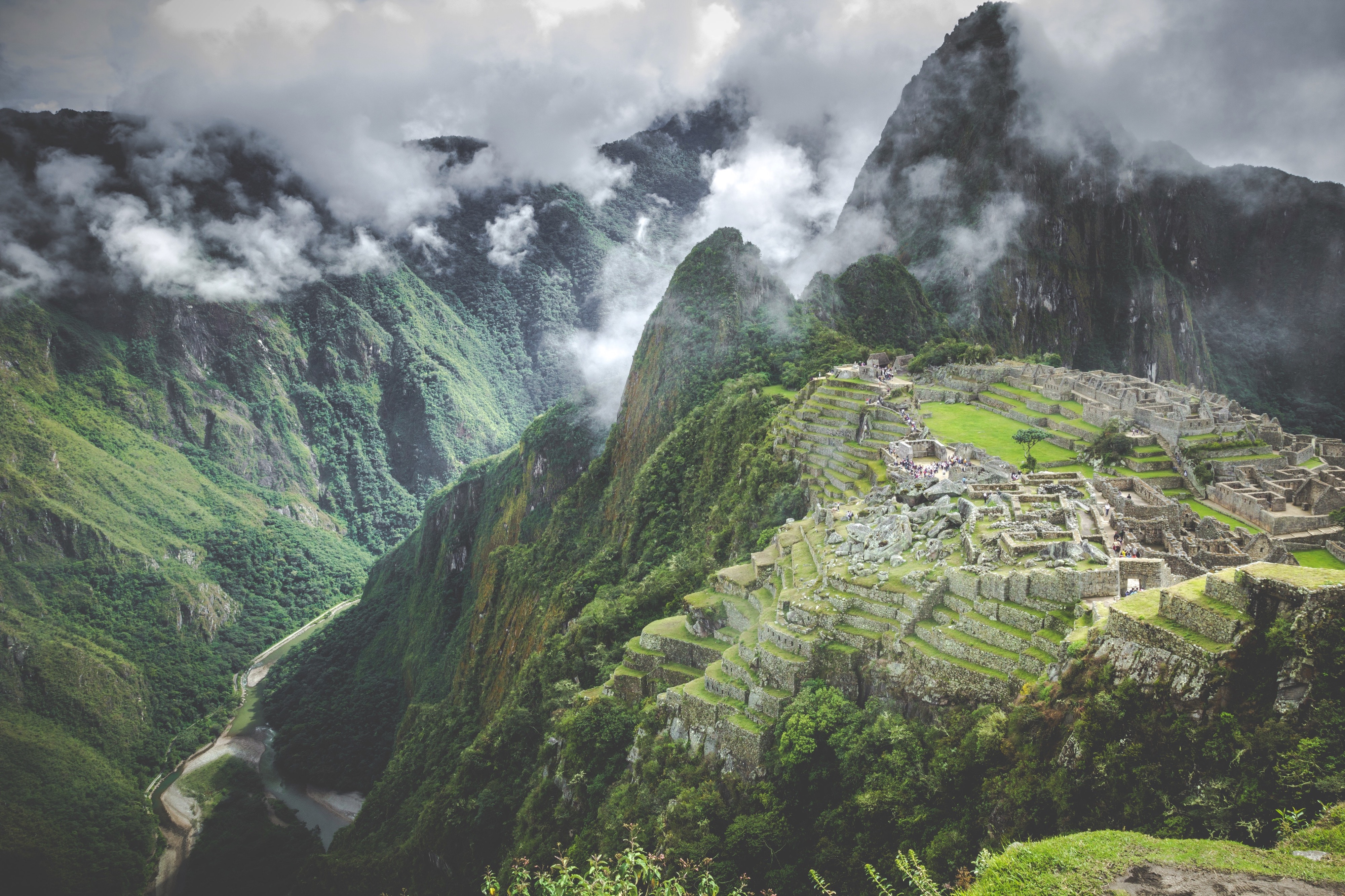
Eco-Connect Tours
Eco-Connect Tours invite you to discover and experience how local communities and groups are endeavouring to conserve, sustain and improve the environments they live in.
Engage with local groups and businesses to learn about how they are transforming the world around them while experiencing the impact of their efforts first-hand.
CONNECT & GROW
Our Eco-Connect Tours provide enriching opportunities to interact with and learn from local communities around the world as they work to conserve and sustain their surrounding environments.
Discover the valuable and beautiful flora and fauna of places like Costa Rica, Vietnam and Australia. Sample the products of sustainable farming practices in regions like France, New Zealand and Argentina. Absorb the inspiring innovations in energy production at facilities in Portugal, Iceland and Japan. This is only a sampling of the more than 150 unique Eco-Connect Tours we offer.
Reinvigorate your love for the world around you with these insightful experiences — many of which are available as part of our FREE Unlimited Shore Excursions.
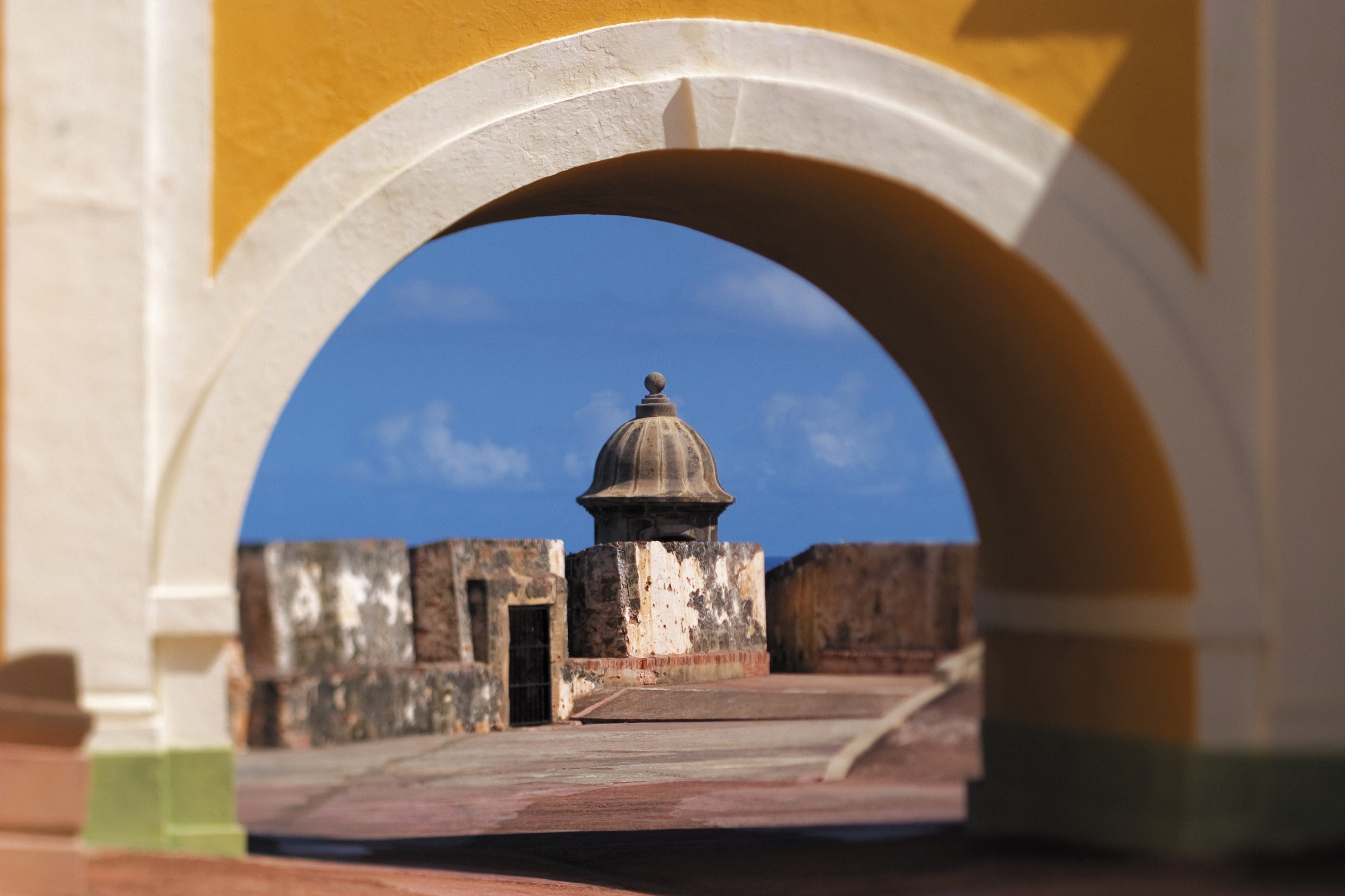
Behind The Design Tours
Every captivating design has a story to tell. Join us as we go Behind the Design to explore how and why some of the world’s great architectural designs came to be.
Glimpse behind the scenes of some of the most captivating and brilliant designs around the world.
BRILLIANT ARCHITECTURAL ACHIEVEMENTS
Our Behind the Design Tours invite guests to go beyond the surface and into the beauty of the design processes and inspirations that made some of the world’s most fascinating architectural structures.
Explore a myriad of architectural marvels across Europe and the Mediterranean, including buildings like the Munchmuseet in Oslo, Norway, the MuCEM in Marseille, France, Toree Glòries in Barcelona, and many more. This is only a sampling of the Behind the Design Tours available, with many more to come.
Expand your appreciation for architecture and design with these intriguing explorations — many of which are available as part of our FREE Unlimited Shore Excursions.e of the most captivating and brilliant designs around the world.

Go Local Tours
Uncover off-the-beaten-path experiences with our Go Local Tours providing a more direct way for you to learn the culture of a destination through the communities within. Spend a day at a family-owned goat farm in the countryside of Andalusia to learn the generations-old way of making cheese or observe skilled, local artists in their personal studios on Palma de Mallorca. Experience the world through the eyes of those who actually live there and discover the best of what you didn’t know about your favourite destinations with Go Local Tours.
Sometimes the best solution for the well-traveled guest and anyone looking to uncover off-the-beaten-path places and experiences is to start thinking like a local.
CULTURAL DISCOVERY
Go Local Tours provide a more direct way for you to experience the culture of a destination through the communities within. Spend a day at a family-owned goat farm in the countryside of Andalusia to learn the generations-old way of making cheese, discover the joy of fishing with the residents of Portofino or observe skilled local artists in their personal studios on Palma de Mallorca. Many Go Local tours are part of our Unlimited Shore Excursions, while some require a discounted, supplementary charge. Experience the world through the eyes of those who actually live there and discover the best of what you didn’t know about your favourite destination with Go Local Tours.
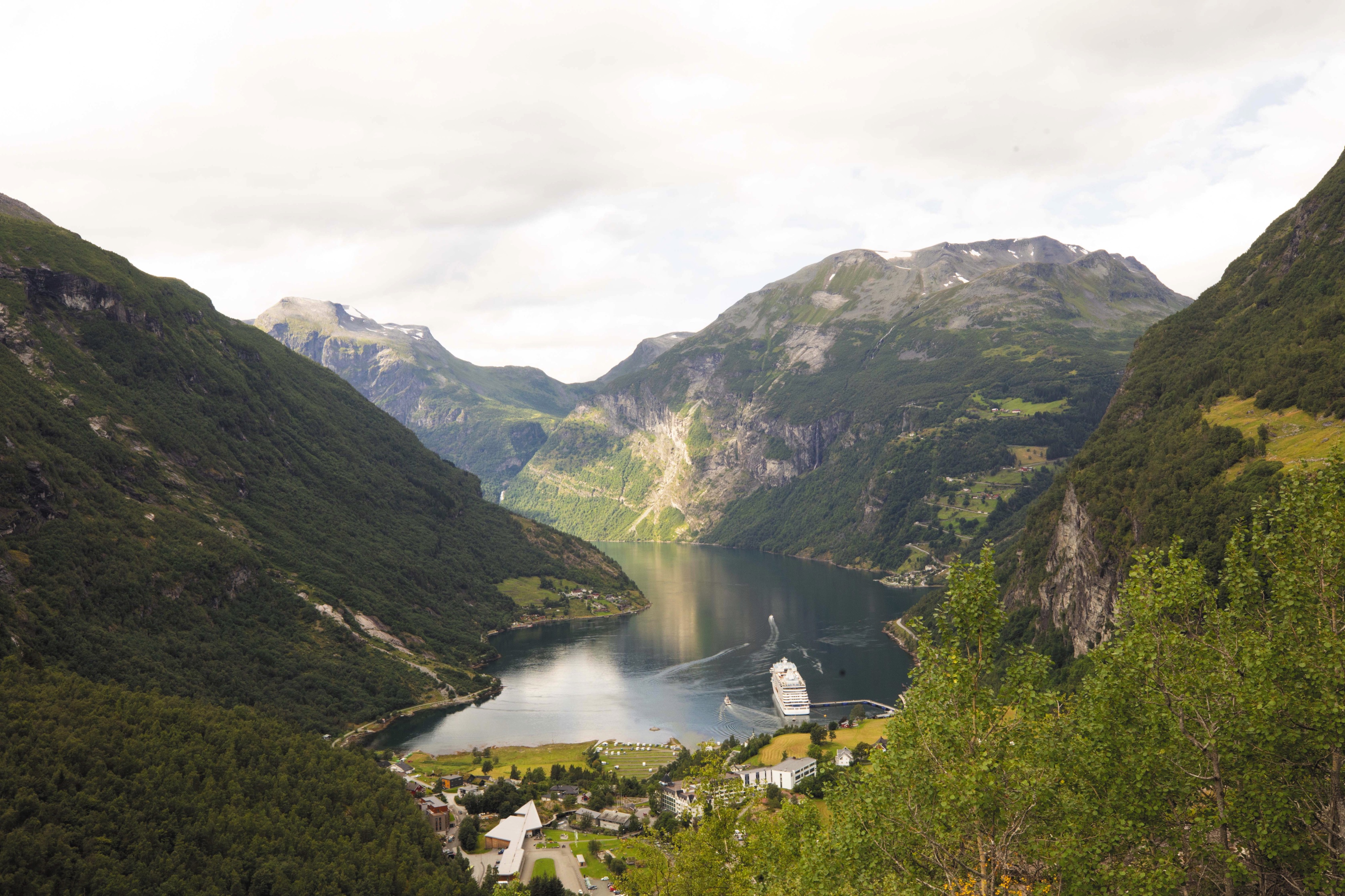
Serene Spa & Wellness™ Tours
Transcend the moment as you expand your mind and strengthen your body with a Serene Spa & Wellness Tours. Soak in a restorative, mineral-rich thermal spring in Rome or centre your chi with a taiji (tai chi) class on a beautiful and serene beach on Palma de Mallorca. Be refreshed by a Mediterranean breeze as you calm your mind and strengthen your focus through a yoga class overlooking the seaside town of Taormina. Restore and heal your mind, body and soul as you travel throughout the world with our Serene Spa & Wellness Tours.
To further enhance your vacation, our Wellness program allows you to enjoy a holistic experience from beginning to end, from complimentary fitness classes and healthy gourmet cuisine on board to Wellness Tours.
A HOLISTIC, REJUVENATING DISCOVERY
These tours allow you to discover the incredible destinations we visit while maintaining your active and healthy lifestyle. Practice yoga against a stunning backdrop in Taormina, learn about apitherapy, a school of alternative medicine based on bee products, or practice meditation on the idyllic island of Palma de Mallorca. Many Wellness Tours are part of our FREE Unlimited Shore Excursions, while some require a discounted, supplementary charge.

In-Port Overnights
Evenings provide a different view of a city as the streets light up and the locals unwind. Discover the fun of a destination’s nightlife and enjoy more time ashore with more overnights in ports across every region of the world.
LET THE NIGHTTIME SET YOU FREE
Celebrate sunsets and ease into moonrises as locals cut loose and skylines twinkle in the world’s great cities. You’re free to pursue your passions – from elegant dining to after-hour museum tours. It’s not just port cities that transform after dark. Regent in-port overnighters do, too. After the exhilaration of daytime excursions, sunset releases you to do as you please and sway to a city’s rhythms.
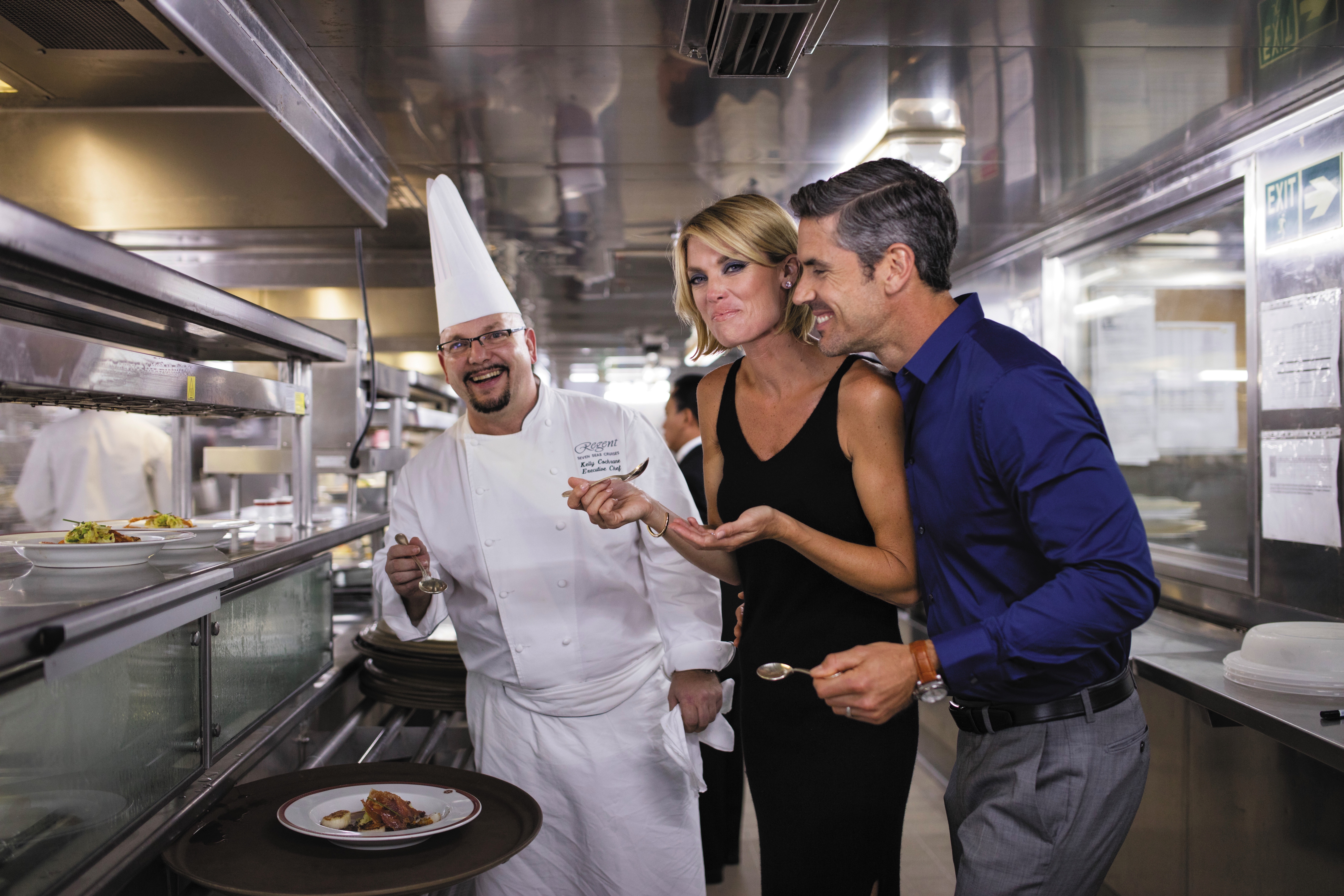
Spotlight Voyages
Explore your destination through special excursions and onboard experiences tailored to the spotlighted theme of your cruise. Hear from captivating speakers, renowned in their respective fields across multiple areas of interest, from culinary masters to renowned vintners to entertainment icons and beyond.
Discover the culinary secrets of award-winning chefs through engaging cooking demonstrations and immersive shoreside experiences. Share tasting notes with Napa Valley’s leading winemakers to discover the contrast between New World and Old-World vintages. Trace your family heritage by visiting some of your ancestral home sites with genealogists from Ancestry.com, or discover new insights from celebrated historians, journalists and tv personalities. These and more engaging opportunities await on our Spotlight Voyages, filled with one-of-a-kind onboard and shoreside experiences, tailored to the spotlighted theme of each individual sailing
Mention promo code “SPO” at time of booking for access to all complimentary Spotlight Voyage programming.
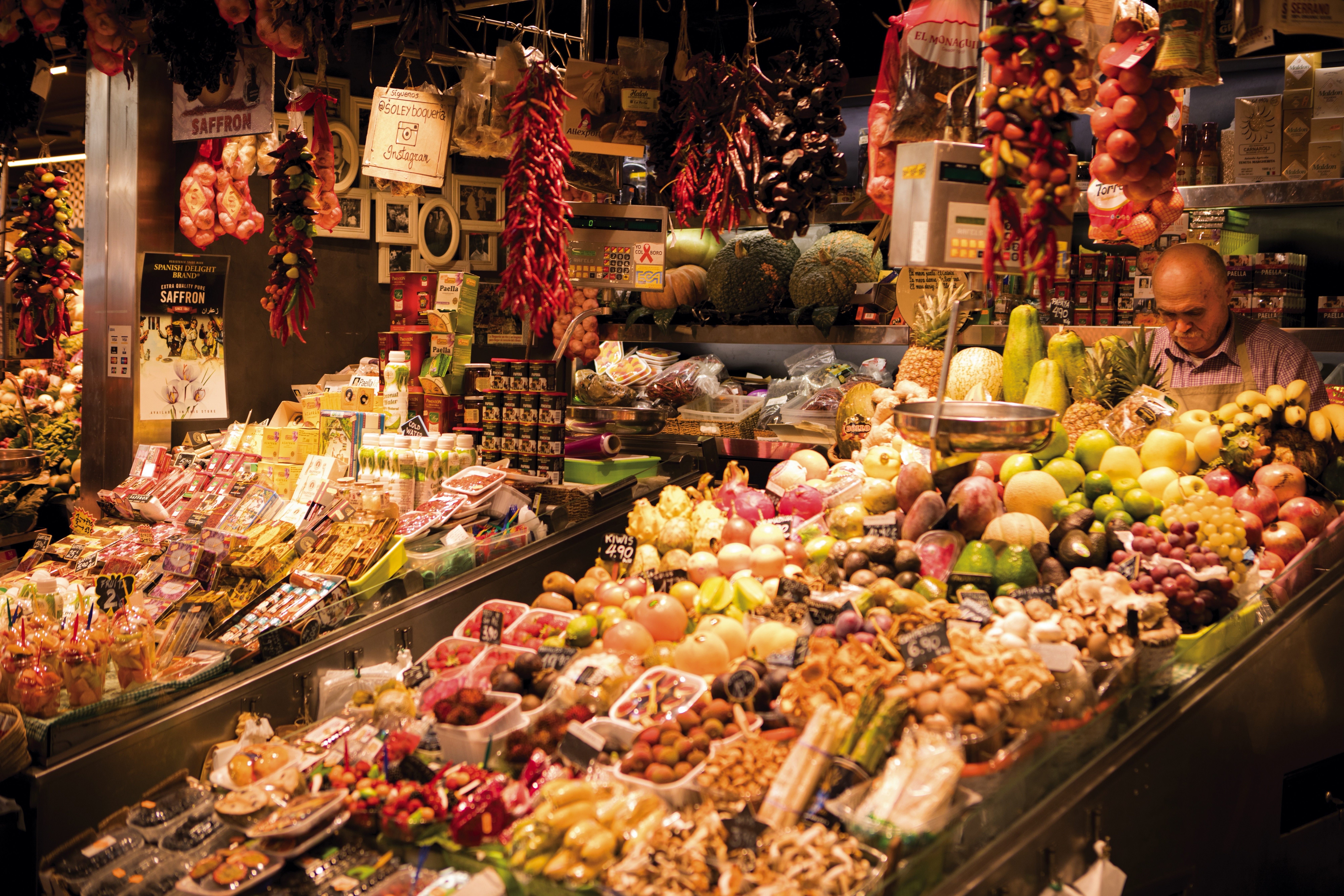
Epicurean Explorer Tours
Taste the cultures of the world with our specially curated, Master Chef-led, Epicurean Explorer Tours, unique to sailings aboard Seven Seas Splendor® and Seven Seas Explorer®. Be treated to a particularly French dining experience with Michelin-starred Master Chef René Bérard at his private estate along with a Provençal cooking demonstration in Provence or be led through the open-air, seaside market in Nice and partake in an exquisite lunch at Château Eza in Eze. Please your palate and expand your culinary knowledge with each of our delectable Epicurean Explorer Tours.
Outside of a stellar local expert, our noses may be our best guides to places beloved by foodies. Market spices drifting on a breeze, sizzling street foods, wine poured in a sun-kissed vineyard – these smells forever recall a destination as much as any photo or souvenir.
CHEF-LED SHORESIDE EXCURSIONS
Allow our chefs to be your guides on these specially crafted small-group experiences. Discover vibrant ancient markets, sample world-class restaurants, incorporate new learnings in the kitchen, and more. Exclusive aboard Seven Seas Explorer®, Seven Seas Splendor® and Seven Seas Grandeur™, these curated tours require a discounted supplementary charge.

Executive Collection & Bespoke Travel Arrangements
Envision your perfect day of sightseeing and exploring your destination exactly as you’d like… Creating your own, customised excursions is possible. Whether you’re looking to engage a private vehicle from our Executive Collection with a personal driver and/or English-speaking guide or hoping to develop a truly bespoke experience with our elite concierge team, we welcome the opportunity to help you create your perfect journey.
You choose the locales – we’ll provide the private transport. Our Executive Collection frees you to explore ports of call with a driver and/or English-speaking guide, the ultimate way to maximise your time onshore. Whether heading out to a city’s outskirts or taking off along spectacular coastlines, you’ll accrue lifelong memories by the mile (or kilometre).
MAKE YOUR VACATION YOUR OWN
Excitement builds each time a Regent Seven Seas’ cruise ship approaches a port city. Let your excitement skyrocket with a car, driver and/or English-speaking guide awaiting you onshore. Where do you go? Across the Charles River to explore Cambridge, Boston’s academic neighbour? Along Monaco’s famed Formula 1 route? Across Sydney’s iconic Harbour Bridge? Only you know for sure.
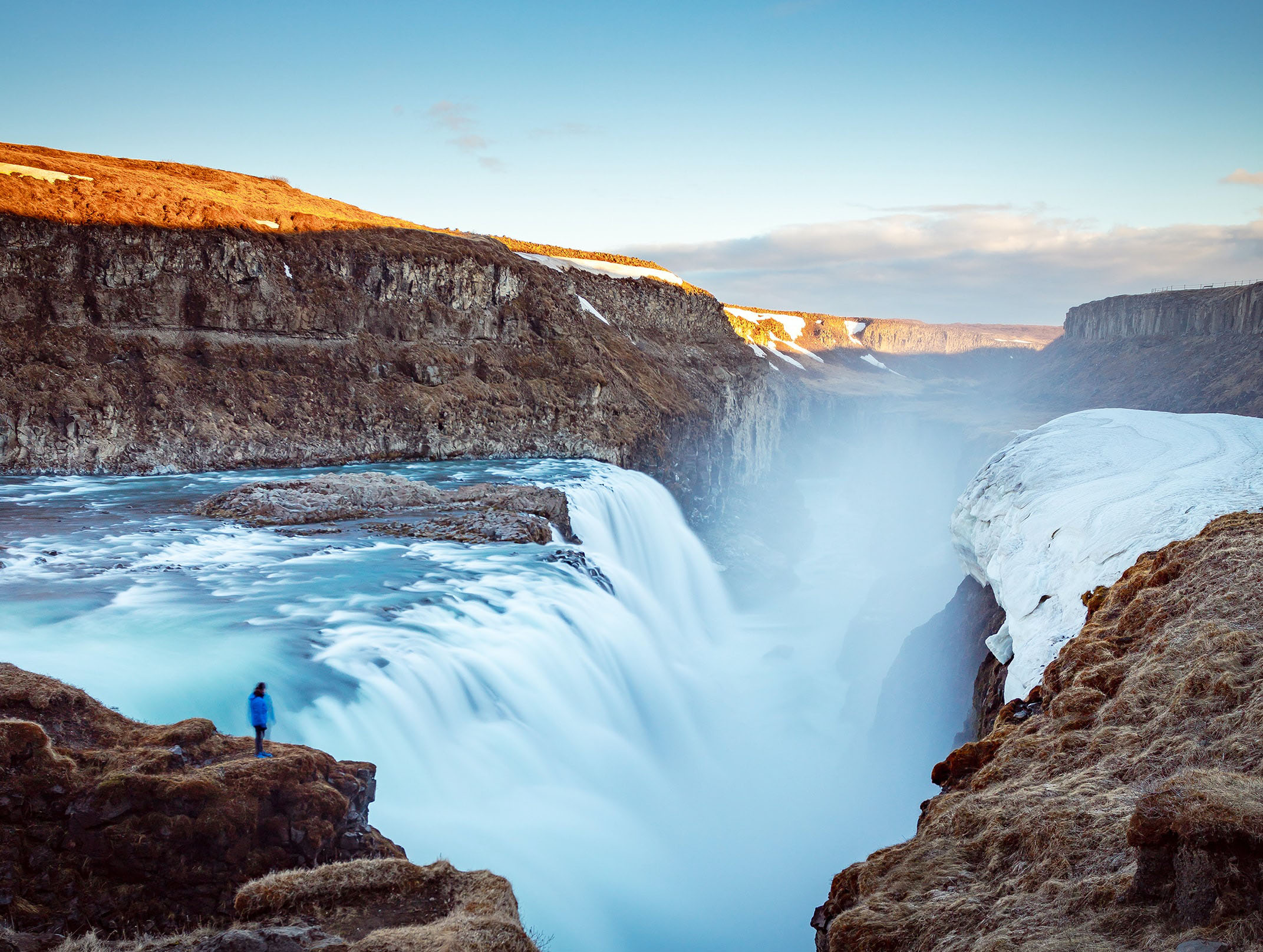
Customise Your Journey
Enhance your cruise by adding another layer of luxury to your travel with any of the multiple options we offer. Select from a variety of enhancements like immersive Land and Overland Programs, Pre- and Post-Cruise Hotel Programs and air upgrades.
PERSONALISED CRUISE EXPERIENCE
Take your all-inclusive luxury travel to the next level by personalising it. Select from a variety of enhancements like our Regent Choice Shore Excursions, Pre- and Post-Cruise Hotel Programmes and air upgrades. Embark on a specially-designed, luxury vacation that offers an experience unlike any other as you explore the cultures, sights and cuisines of your destination. Enjoy it all with The World’s Most Inclusive Luxury Experience® across air, land and sea.

The Regent Speaker Series
On every sailing, thought-provoking and captivating presentations invite guests further into the cultures and people of the destinations they’re traveling to, while select voyages offer unique experiences and learnings from thought leaders across a variety of industries, scientific fields, and the arts.
On every sailing, thought-provoking and captivating presentations invite guests further into the cultures and people of the destinations they’re traveling to, while select voyages offer unique experiences and learnings from thought leaders across a variety of industries, scientific fields, and the arts.
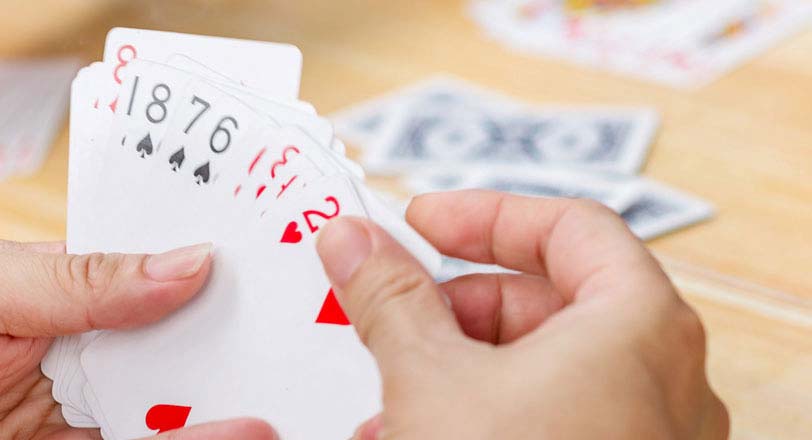
Bridge at Sea
Enjoy social and competitive Bridge play on select voyages. ACBL Certified Bridge Masters sail with guests to provide professional instruction and host games for all levels.
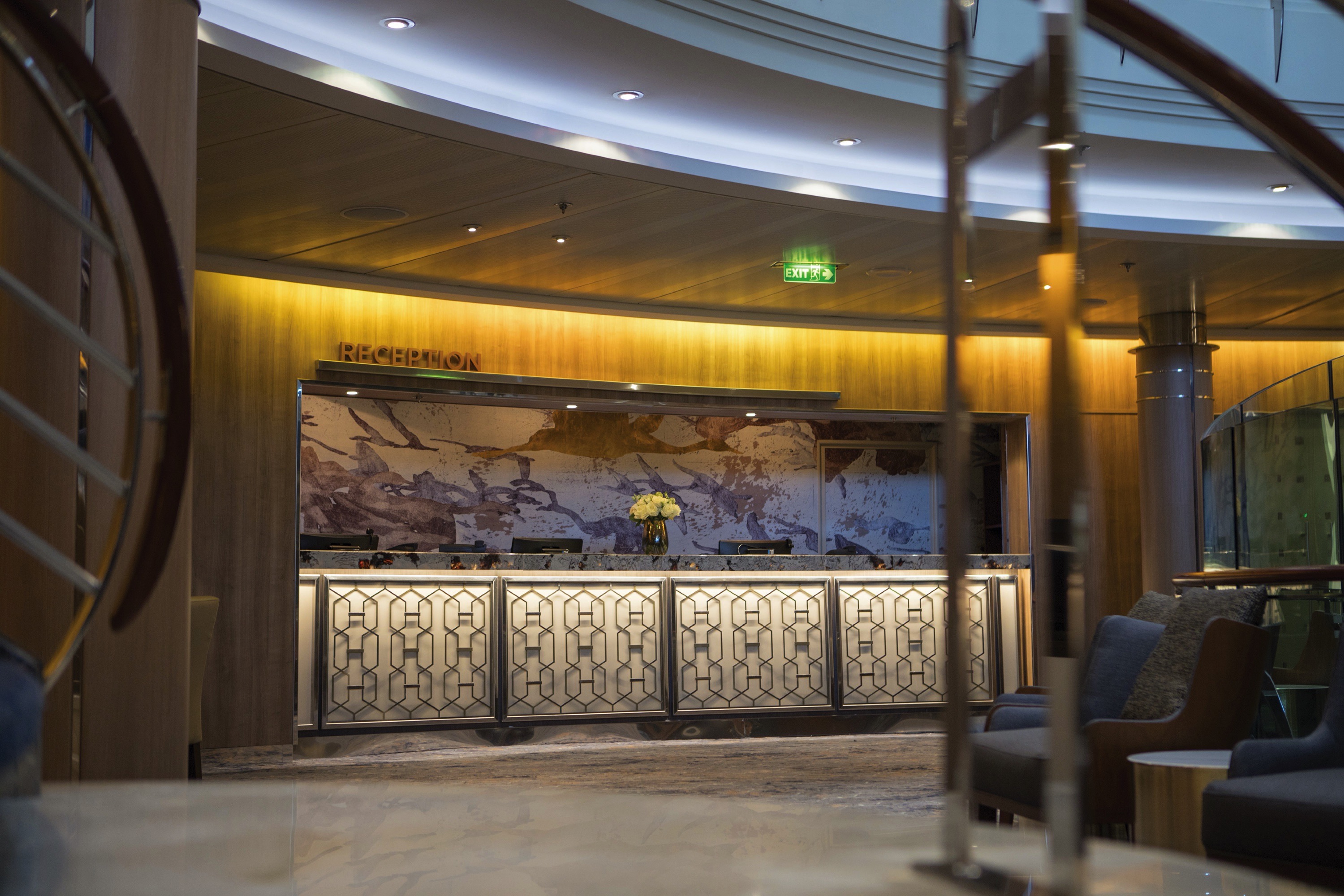
Reception & Concierge
Our knowledgeable Reception staff is available around the clock to answer your questions and ensure your pleasure with your Seven Seas Mariner® voyage. Reception is also where you may contact the ship’s Concierge.
Our welcoming Reception Desk is open 24 hours a day and staffed by personable, knowledgeable men and women who are happy to answer your questions and provide any general assistance you may need. Reception is also where you may contact the ship’s Concierge. Postcards and letters may be dropped off here as well; they’ll be delivered to the postal service at the next port of call.
GENERAL MANAGER
While cruise-related issues are first submitted to Reception/Concierge, you can be assured that a General Manager is on hand to resolve issues to your satisfaction.

Observation Lounge
As indicated by its name, the Observation Lounge offers a wonderful vantage point to enjoy staggering views as your glorious ship enters and leaves ports of call. Live music adds to the serene vibe.
A chic yet comfortable space to read, relax and enjoy a cocktail while admiring the spectacular views offered every time Seven Seas Mariner® enters and leaves one of its worldwide ports of call. Live music is played throughout the day, making this another inviting onboard destination to to unwind with afternoon tea, pre-dinner cocktails or a satisfying nightcap.

Connoisseur Club
Engage in spirited conversation with new friends in an elegant hideaway that calls to mind gentleman’s clubs of old. An elegant throwback where cigars are savoured, you’ll take to like a favourite cardigan.
Maybe it’s the deep blue walls that give the Connoisseur Club such a gentile, old-fashioned feel. Or maybe it’s the collection of impossible comfortable leather armchairs. Whatever it is, this is a relaxing spot for you and new friends to enjoy a fine cigar and sip cognac (both are available for purchase) in classic gentleman’s club environs. Smoking is permitted in the club.
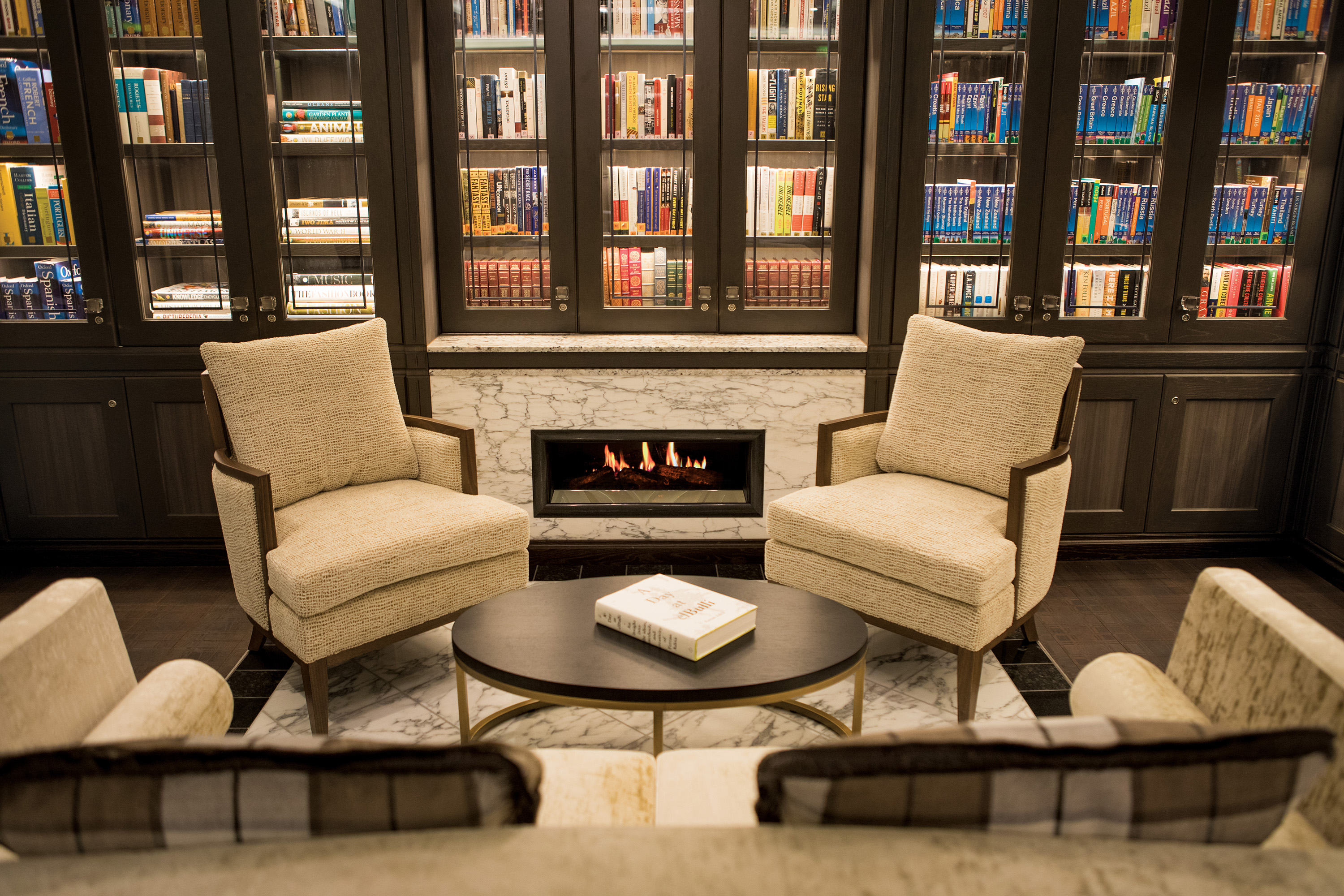
Library
Browse a vast collection of volumes, from destination-specific guide books to best-selling mysteries to classics of literature, upon a variety of comfortable chairs in our cozy Library.
Well-stocked and offering comfort for the body and mind, you’ll discover our Library is a most civil setting for reading and relaxing. Curl up with a classic novel or best-selling mystery, play a strategic game of chess or simply soak up the ambience of a sumptuous reading room. Regardless of what brings you here, our library is a welcoming, low-key treasure you just may find hard to leave.

Constellation Theatre
Take in lavishly staged, high-energy shows created and produced by our own team of Broadway choreographers and directors in our delightful hall. So grand it needs two decks, it offers plush seating and surroundings.
Smartly tiered for pleasing sightlines and decked out with delightfully plush seating, our Constellation Theatre is an intimate venue without a bad seat in the house. Settle in, admire the grand surroundings, and be prepared to witness phenomenal performances that vary from full-scale musical revues to rousing singalongs, all backed by our incredible, five-piece Regent Signature Orchestra.
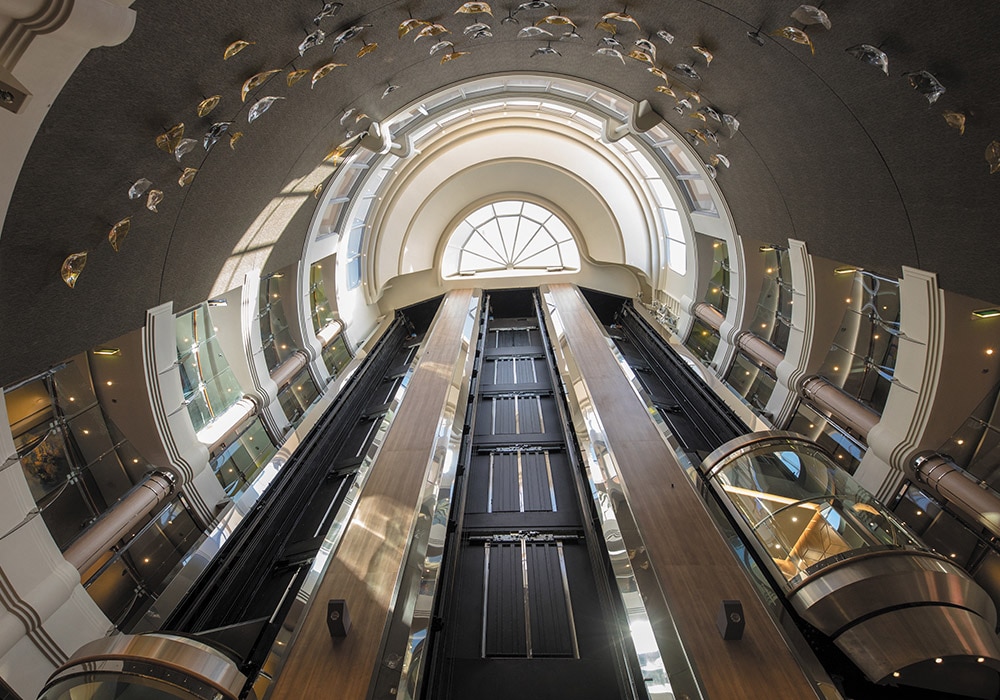
Atrium
Simply put, the Atrium is the very heart of Seven Seas Mariner®. With natural light shining from above, it’s a natural hub for guests to rendezvous or gather for organised activities.
Often described as the crossroads of the ship, our Atrium is an inspiring testament to the grandeur of luxury ocean travel. Winding staircases wrap down several decks before meeting in the Atrium, which is a work of art itself. A glittering, modern, glass sculpture rises up the inside of the Atrium, reaching all the way to the open decks.
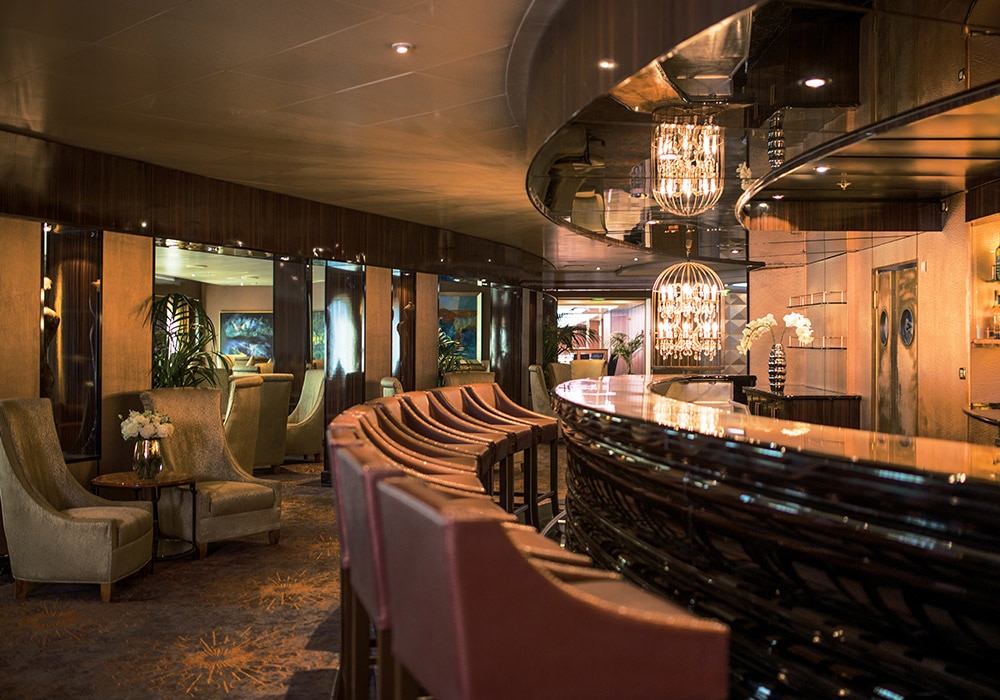
Mariner Lounge
You’ll find our popular Mariner Lounge tough to resist. It’s an inviting spot to chat with new friends over cocktails before a delicious dinner, and an exciting space to dance the night away afterwards.
Discover for yourself why the Mariner Lounge and nightclub is the perfect venue to meet new friends for a pre-dinner cocktail. As the night progresses, the spectacularly designed space turns into a nightclub where night owls gather to dance into the night or maybe sing along in a karaoke competition. Musicians entertain nightly, and during the late hours on selected nights a DJ spins records and takes requests.
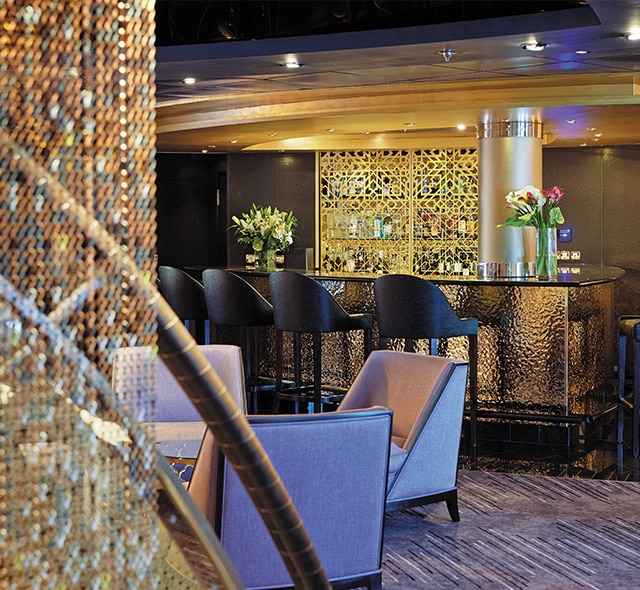
Stars Lounge & Night Club
Encircling a glistening stairwell that leads to the Casino, the Stars Lounge is a throwback nightspot that draws fun-loving crowds for after-dinner drinks and late-night cocktails. A favourite with night owls.
High-backed velvet chairs and a shimmering bar are highlights of this popular spot for after-dinner drinks and late-night cocktails, but it’s a glistening stairwell to the upstairs Casino that gives Stars Lounge a certain throwback appeal. A long-time guest favourite, this arty lounge has a circular dance floor that beckons night owls to dance into the wee hours or partake in karaoke competitions.

Horizon Lounge
A alluring destination for informal drinks in an elegant setting. With live music throughout the day and expertly poured cocktails only a request away, the Horizon Lounge is a natural spot to rendezvous with fellow travellers.
The Horizon Lounge is an ideal destination for classic cocktails or to simply relax and engage in conversation with new friends. Resident musicians play familiar tunes throughout the day as well as before and after dinner, making it ideal for informal plans. Game shows, night entertainment and live musical events are featured regularly.
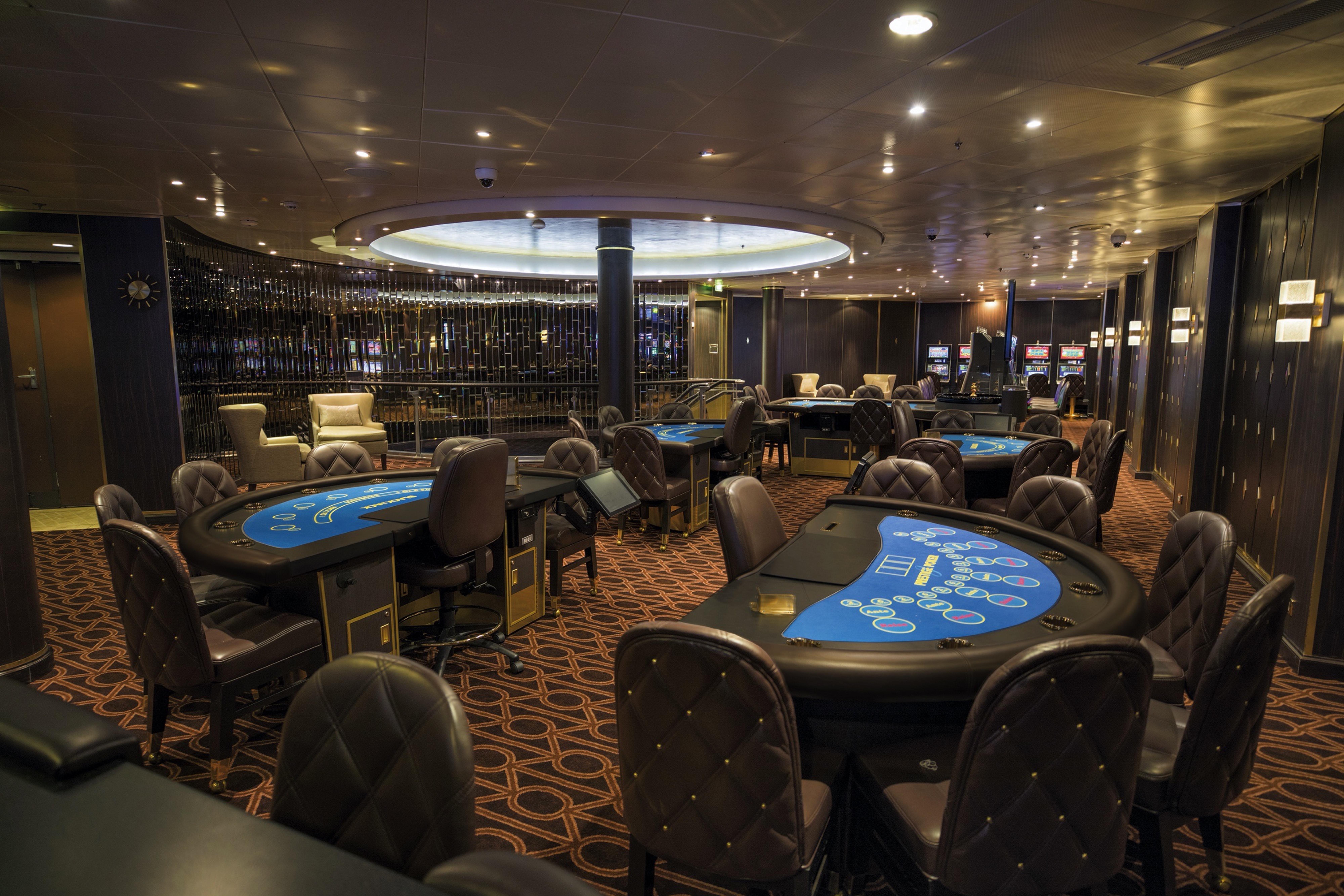
The Casino
Glass doors lead to an elegant setting bustling with games of chance that include Blackjack, roulette, poker and slot machines. The Casino is open every day at sea when not restricted by territorial border limits.
If you’re in the gaming mood, head to our elegantly appointed Casino for a few hands of blackjack or to try your luck at roulette, poker, the craps table or slot machines. Whether you’re a player or spectator, the excitement is contagious, the drinks delightful and the staff welcoming. Our stylish Casino is open every day at sea when not restricted by territorial border limits.
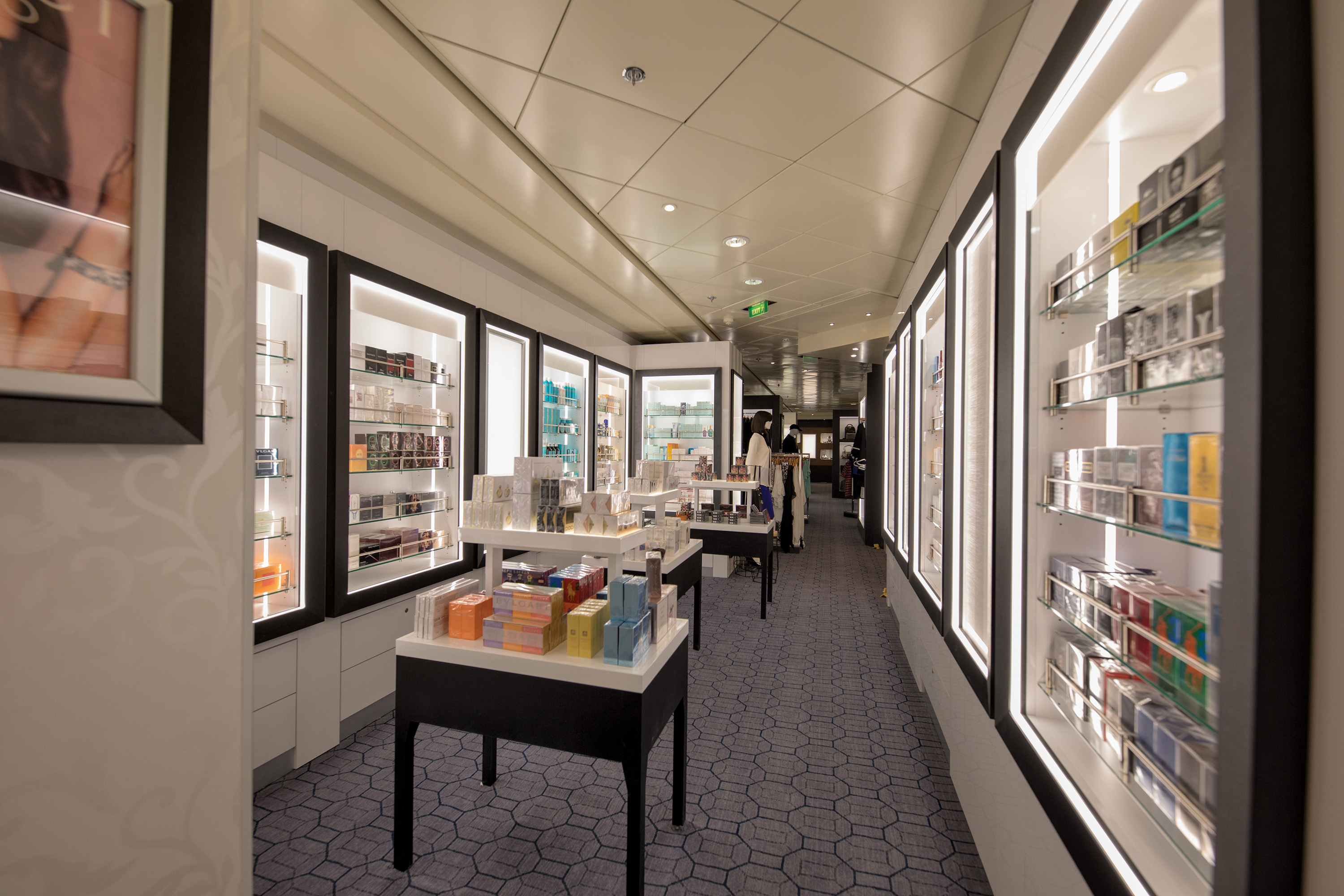
Boutiques
Whether it’s designer evening wear, handbags, fragrances or a smart gift, our boutique items are carefully selected and of the highest quality. The same may be said of our personable staff.
Stop into our boutiques and browse a wide range of items – upscale handbags to exclusive fragrances to fine jewellery – in an intimate and unhurried setting. You’ll also find a variety of clothes, Regent Seven Seas Cruises® logo wear and gift items to share with friends and family. Our boutiques are staffed by friendly salespeople. Opening hours vary and are printed in the Passages daily newsletter.
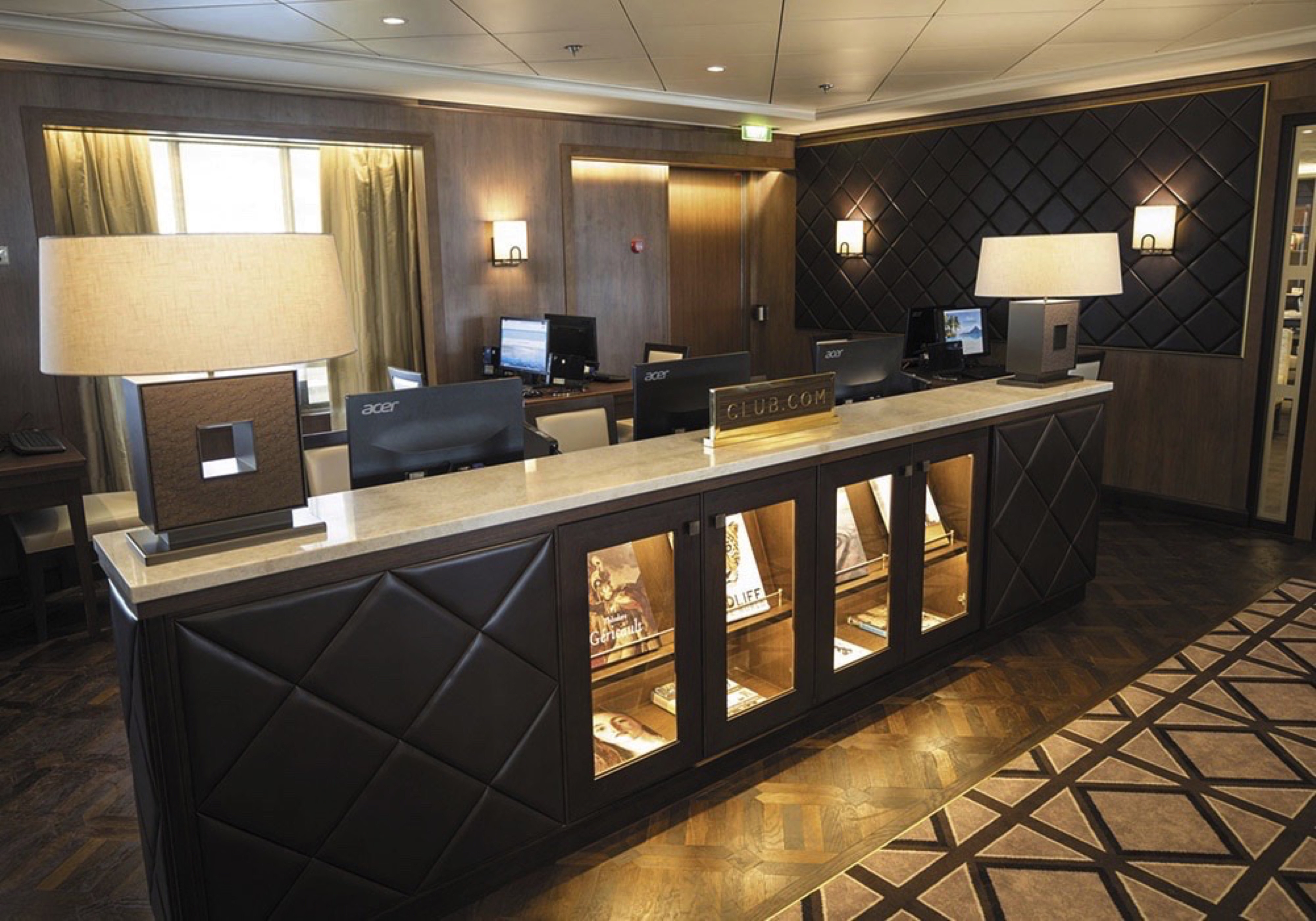
Club.com & Internet Café
For those who’ve chosen to leave their laptops at home, desktop computers are available at our staffed Internet Cafe. Of course, you may access WiFi without charge throughout the entirety of the ship.
It’s easy to stay connected, even while sailing the seven seas. Our ships have WiFi throughout for guests with their own laptops, and there are plenty of computers in the staffed Internet Café, which is open round the clock. Printers, e-mails, Internet access and Wireless access throughout the ship are all available for a nominal fee.
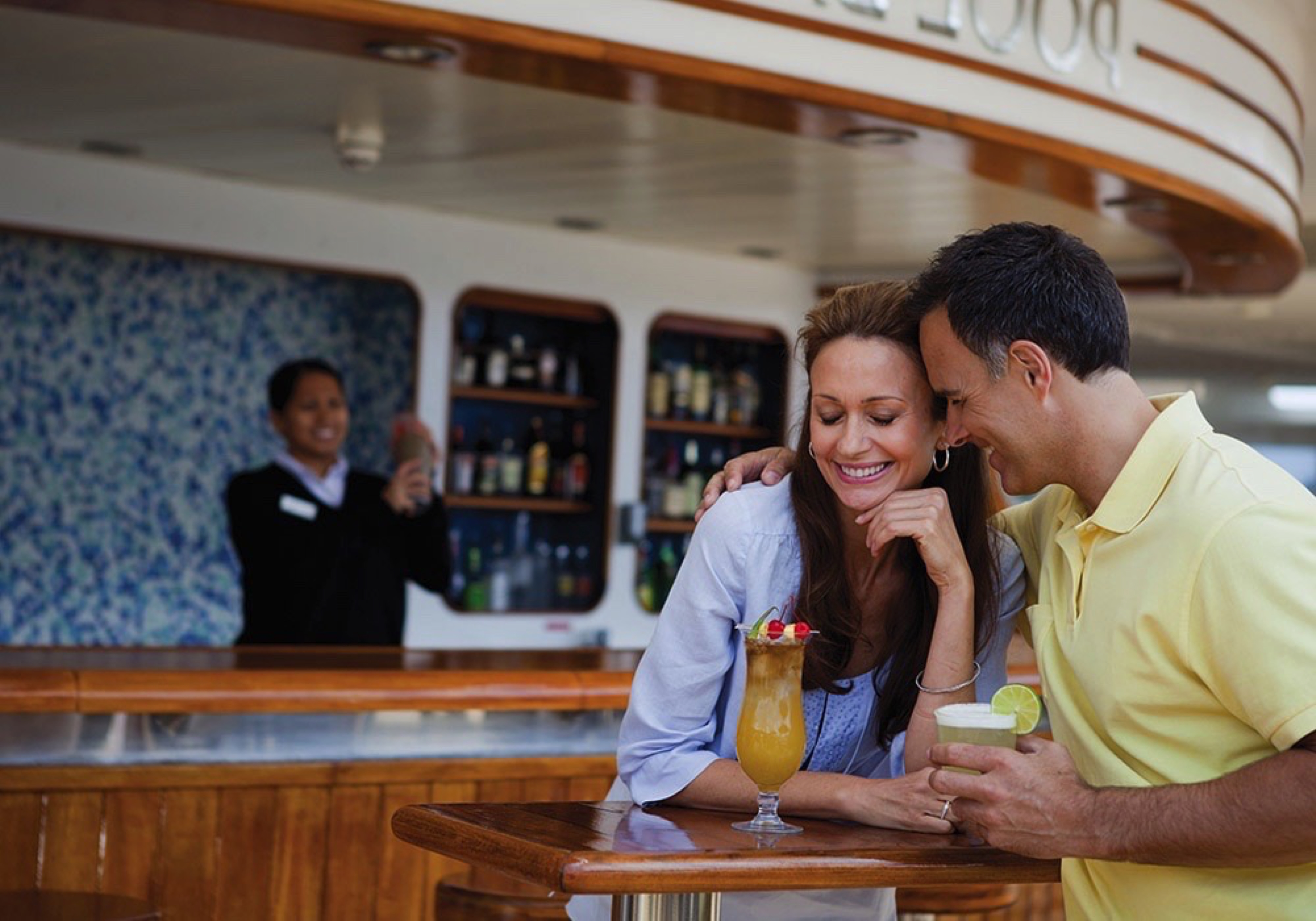
Pool Bar
Very few things equate to a pure vacation activity more than sitting at our Pool Bar. Make new friends while sipping a cocktail or frozen drink in the most laid-back atmosphere imaginable.
When you envision an activity you’re only likely to do while on vacation, sipping a frozen drink at a pool bar onboard a glorious cruise ship is probably near the top of the list. You can tick that box at our Pool Bar, where you and new friends can enjoy leisurely conversation over cocktails and frozen drinks in a delightfully relaxed atmosphere.
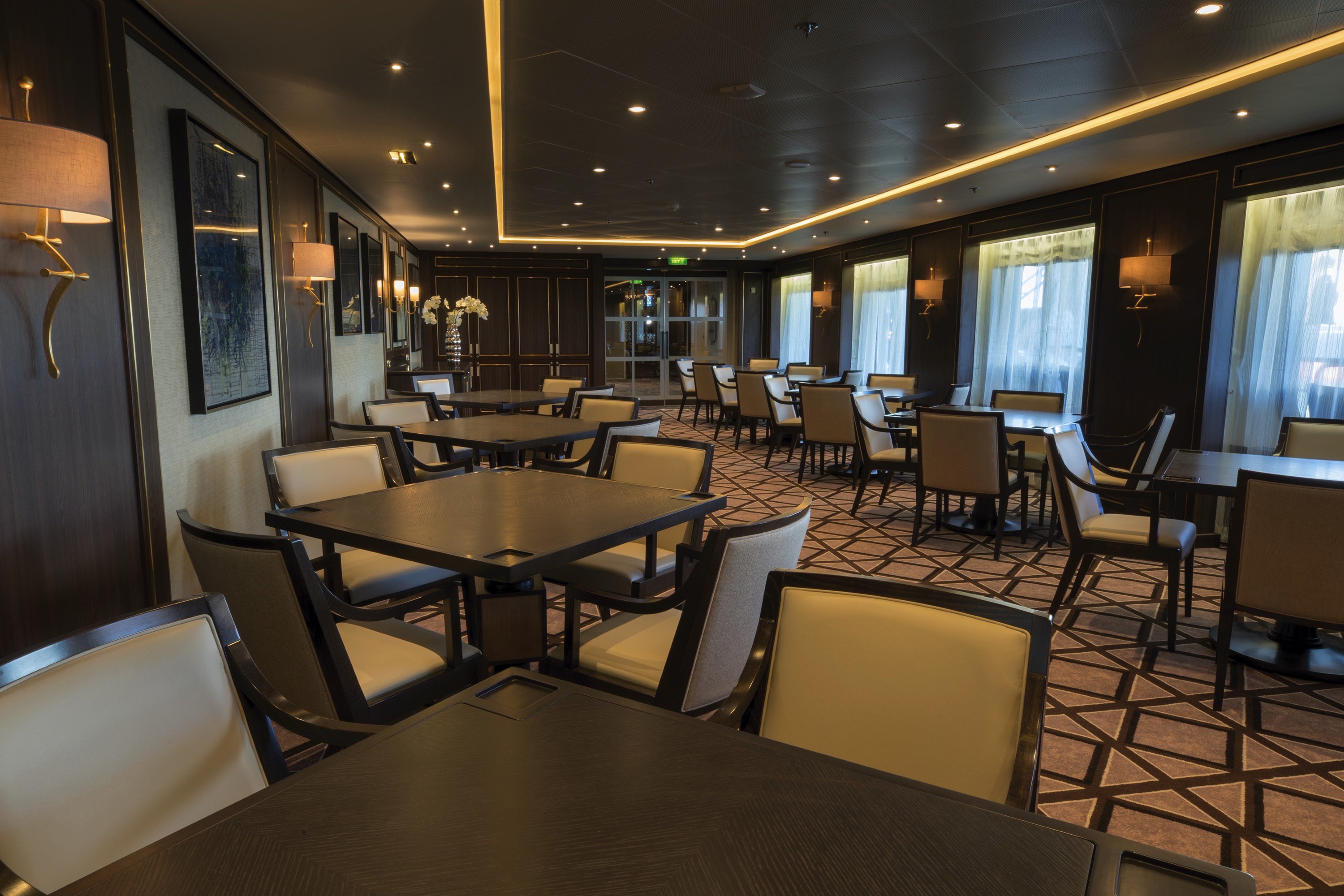
Card & Conference Room
Gather your favourite teammates in the Card Room for a lively afternoon or evening of cards, board games or a social game of Bridge. The spaces, which may be combined, are also designed to host conferences.
Two complete Card and Conference Rooms can be used for everything from bridge lectures and tournaments to corporate meetings and special events. Gather with a few friends for an afternoon or evening of fun competition with board games, cards and more. Larger groups may increase space by removing the dividing door and combining both rooms.
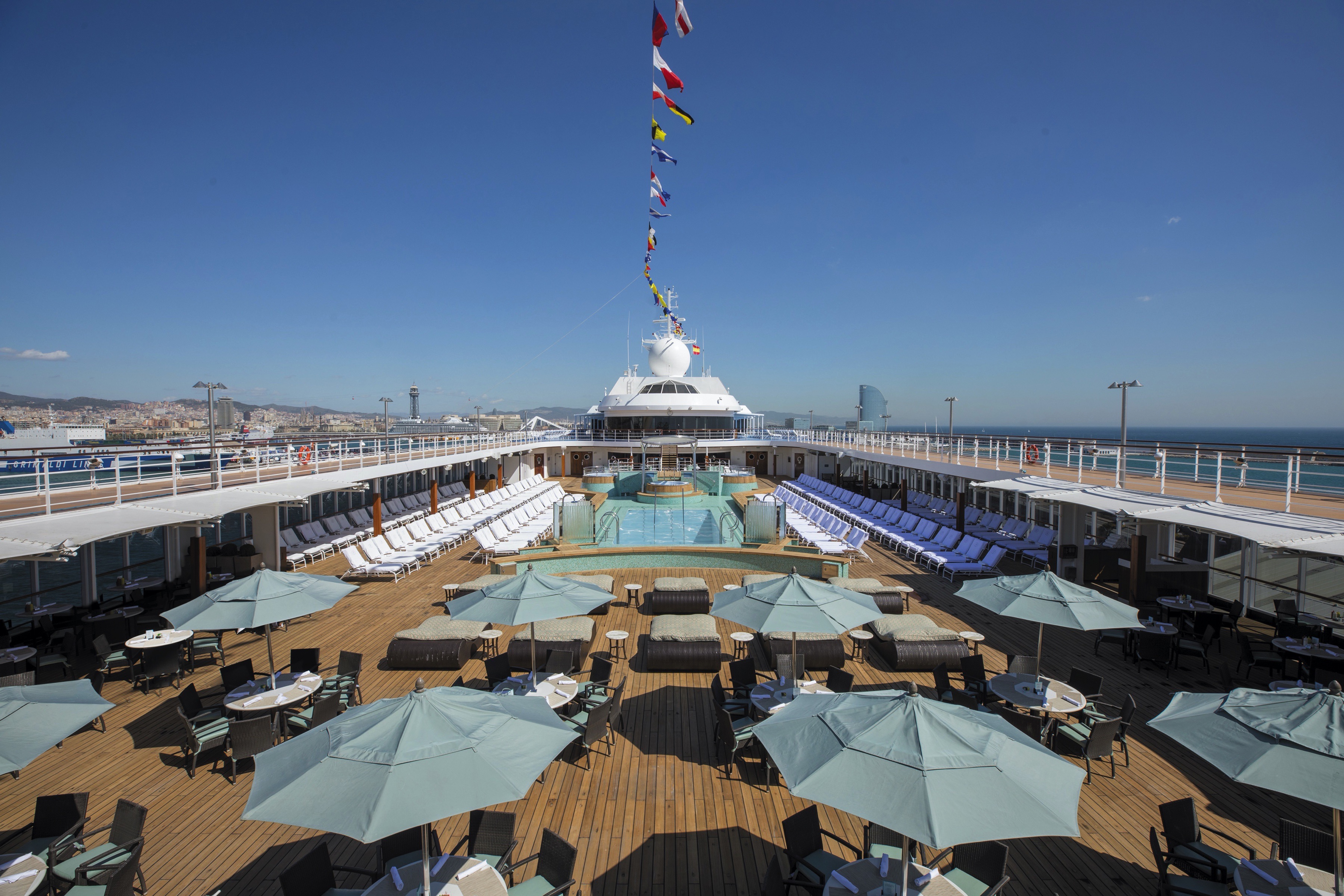
Pool Deck
For those days when nothing but sitting poolside will do, head to our Pool Deck. You’ll be greeted by an expansive space with unforgettable views, teak accents and an amiable crew offering cold drinks and lounge chairs.
Our Pool Deck is one of the most expansive at sea and features a large heated pool, two whirlpools and table tennis. Surrounded by luxurious teak accents, you’ll be consistently awestruck by the pool’s magnificent vistas high upon Seven Seas Mariner®. You’ll also be impressed by our amiable and dedicated crew, who stand at the ready to provide refreshing beverages and comfortable lounge chairs.
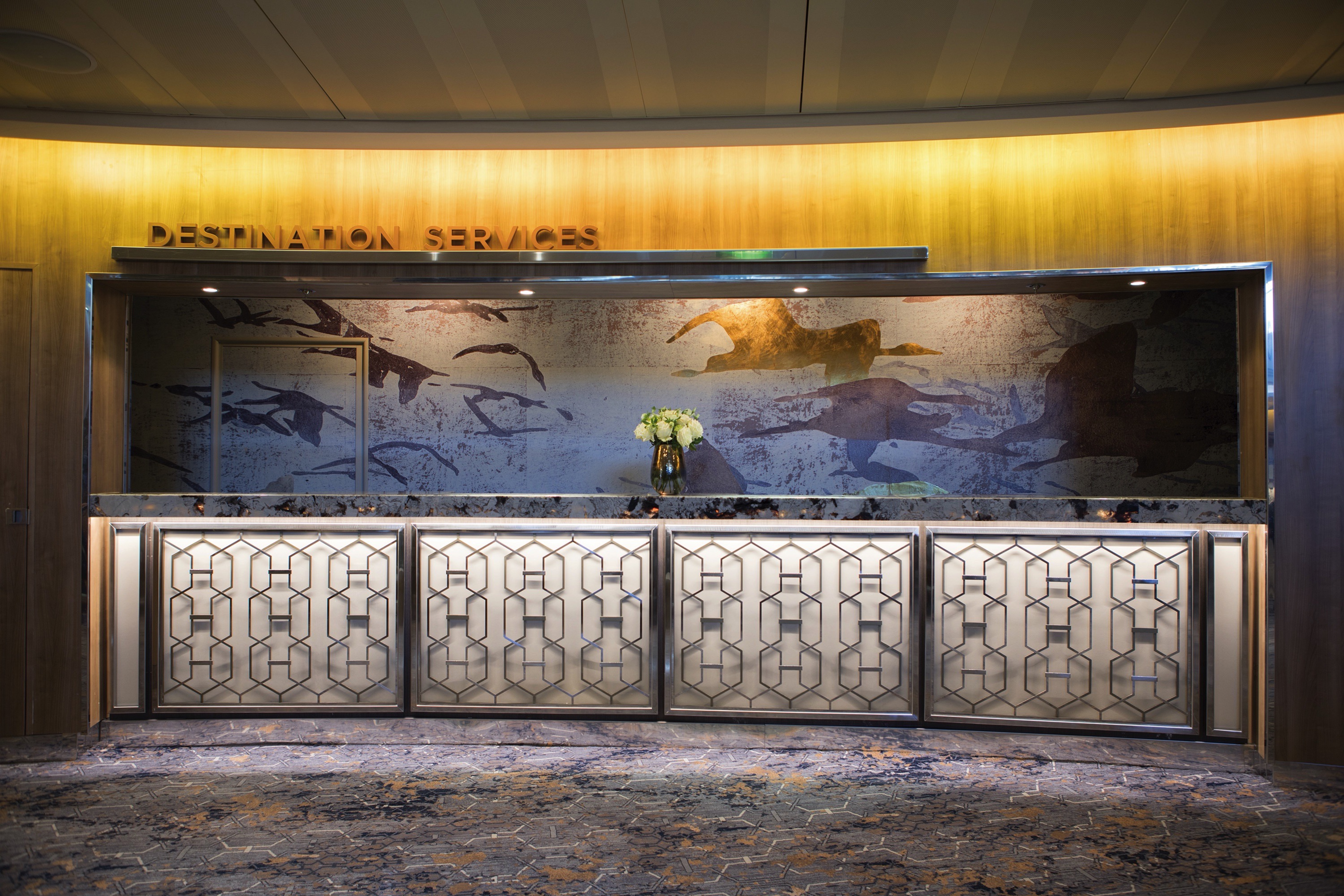
Destination Services
Whether you’re interested in a tour from our FREE Unlimited Shore Excursion menu or a unique, small-group Regent Choice Shore Excursion, our staff at Destination Services is ready to assist.
If the road to a richer life is paved with the lessons of new discoveries, our Destination Services is a great place to start. Learn about the adventures available to suit every taste and comfort level during your voyage from our dedicated staff. They can arrange unique shore excursions designed for smaller groups or assist with tailor-made pre-and post-cruise programs, from a simple stay in a luxurious hotel to a 3-night extension in a remote locale.
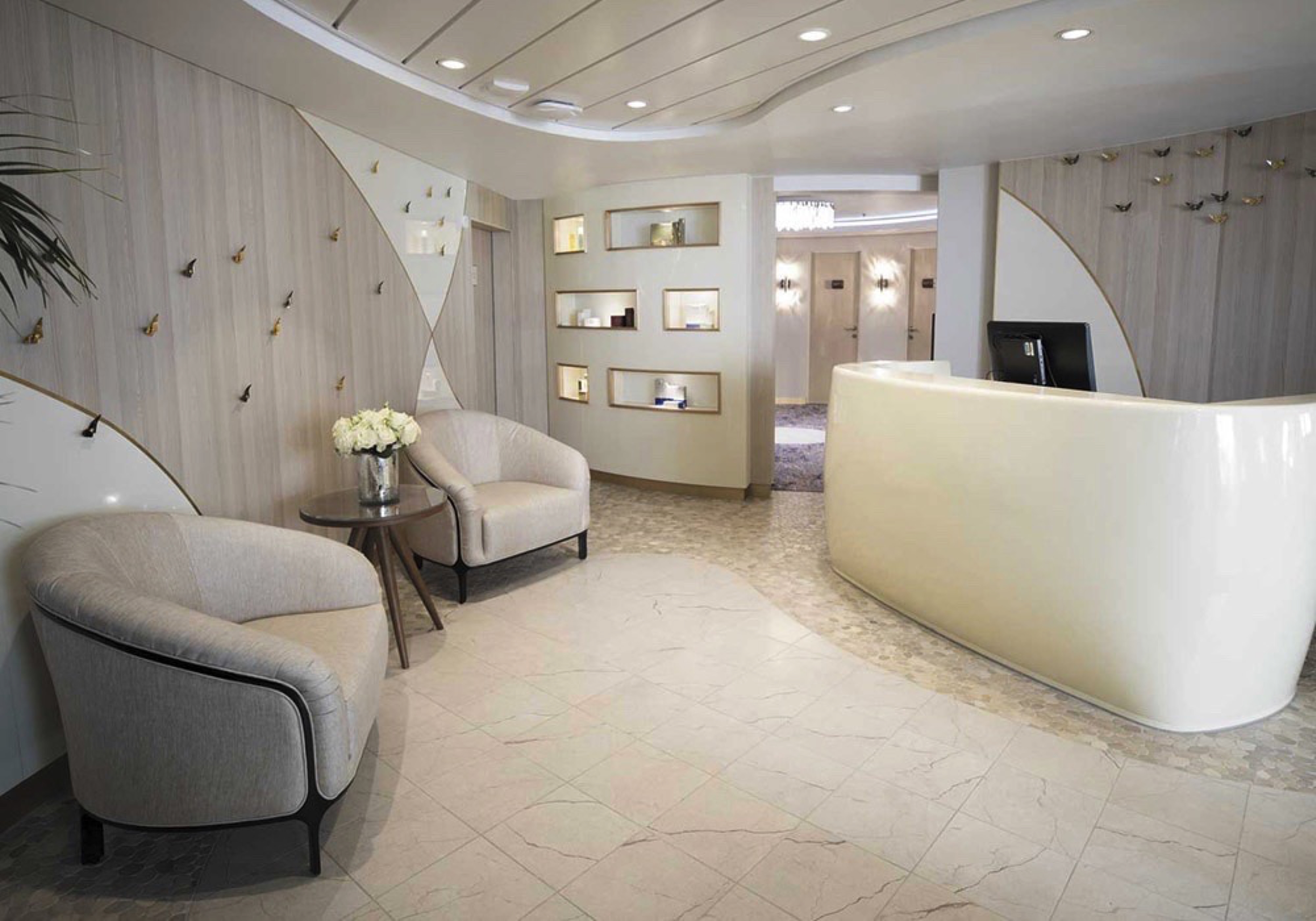
Serene Spa & Wellness™
A globally inspired, tranquil haven of health, beauty and wellness, our spa offers restorative treatments and activities that incorporate globally sourced, natural ingredients to soothe both the body and mind.
Serene Spa & Wellness is a globally inspired, tranquil haven of health, beauty and wellness, offering restorative treatments and activities to soothe both the body and mind. Strengthen and elevate both your body and mind as you engage with a variety of treatments and services designed to enhance your whole being, from massages, and body wraps to facials, manicures and pedicures and exclusive treatments curated especially for Regent Seven Seas Cruises®.
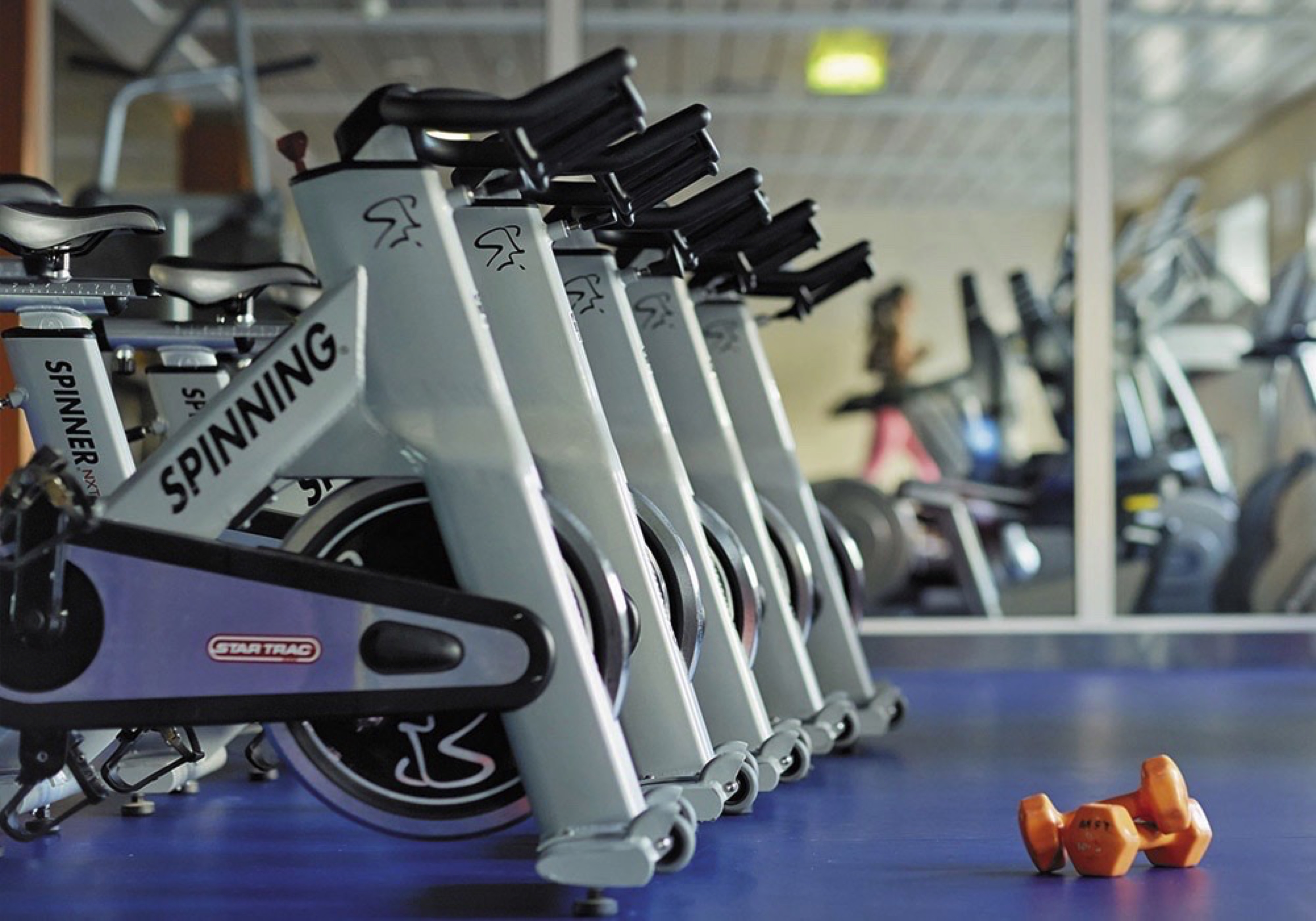
Fitness Centre
Look after yourself at sea. Take part in Pilates, yoga and aerobics classes or help yourself to spinning bikes, dumbbells, treadmills, Technogym Strength Machines, workout mats and step benches. For guests 16 and over.
Serene Spa & Wellness™ fitness experts lead popular exercise classes, such as Pilates, yoga and meditation and are on hand to offer advice and demonstrate the use of fitness equipment. Equipment includes spinning bikes, dumbbells, treadmills, Technogym Strength Machines, workout mats and step benches. One-on-one training can be arranged with a fitness instructor. Guests under the age of 16 are not permitted in the Fitness Centre.
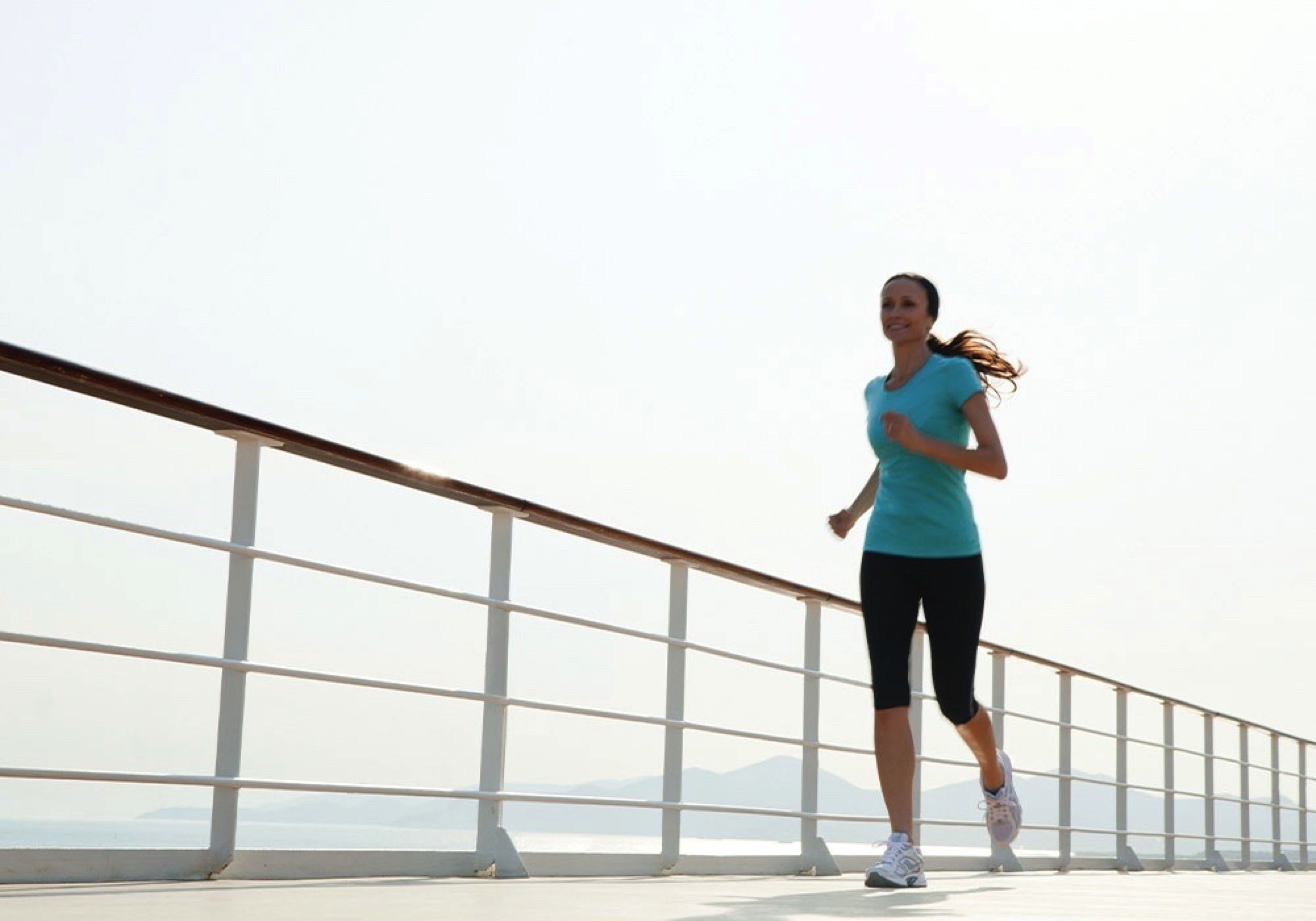
Jogging Track
If you have a regular walking or running routine, fear not – your healthy habit can be maintained while cruising the high seas. Regardless of the speed you traverse our track, dramatic views and fresh air await.
Whether you prefer to start your day with a brisk jog or wait until later and get in an afternoon walk, our Track is a popular destination for those who’ve developed active lifestyles back on dry land. Onboard Seven Seas Mariner® it’s an outstanding place to get your heart pumping while enjoying unforgettable ocean vistas.
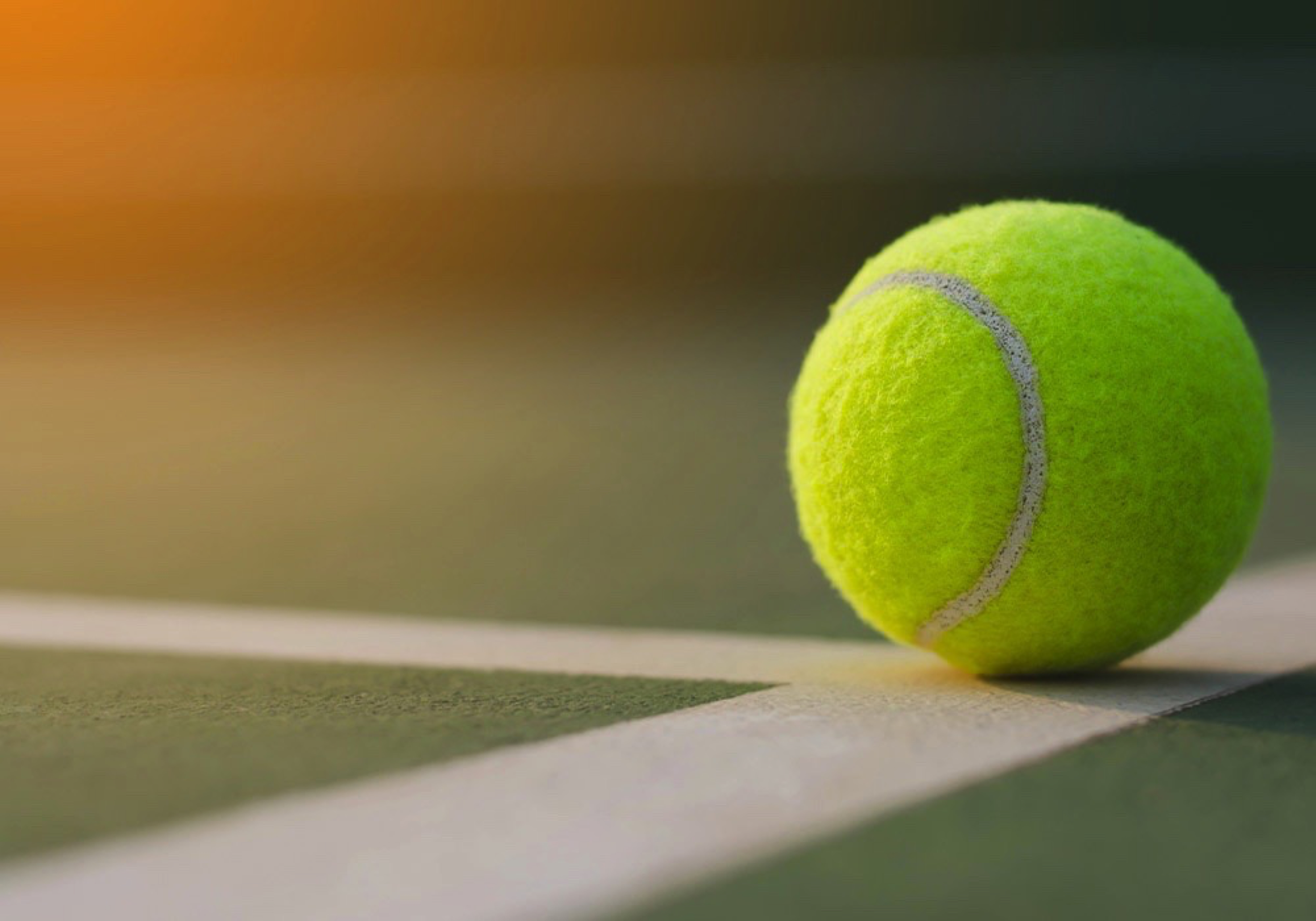
Paddle Tennis Court
Our completely screened and well-maintained paddle tennis court will beckon you and your teammates to win at all costs – or simply enjoy a fun game of paddle tennis or two.
One look at our Paddle Tennis Court and you’ll know it’s a place of serious competition. All the equipment you need is nearby, the court is completely screened and the surface is immaculate. Whether you find yourself in a tense match or something more leisurely, you and your fellow players will be enjoying fresh ocean air and fantastic views from high atop your ship.
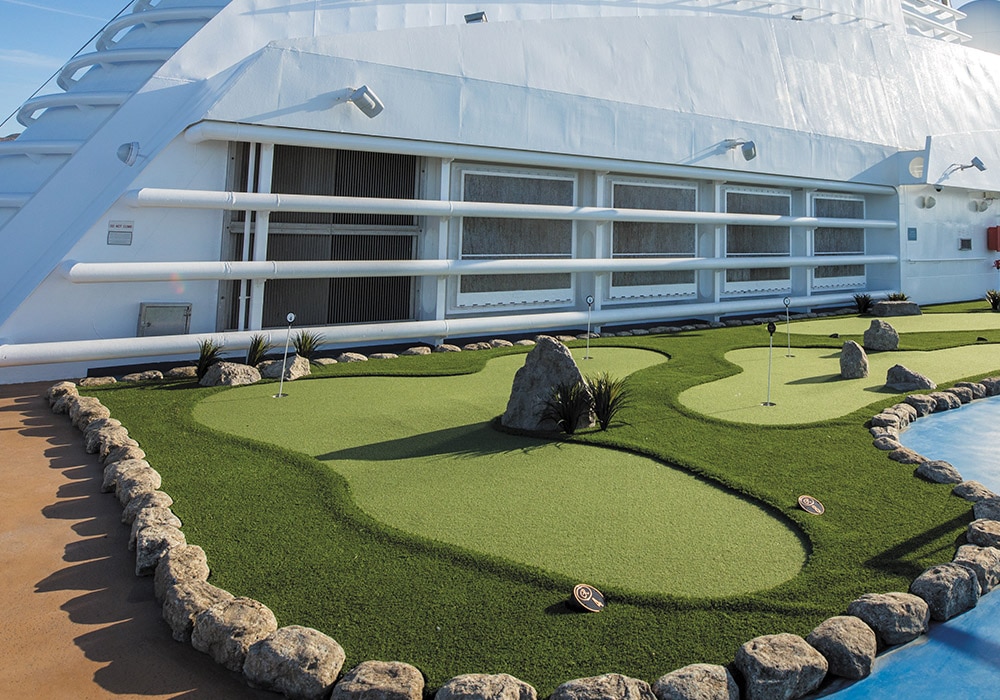
Putting Green
Not nearly as serious as the Golf Net, our Putting Greens invite you to gather friends – perhaps after an afternoon cocktail – for a spirited round of putt-putt golf or two.
While the Golf Net is meant to help you improve your fairway swing, our Putting Greens are less about self-improvement than group fun as your ship travels from one destination to another. A popular pastime is gathering friends after an afternoon cocktail and heading to the top deck of Seven Seas Mariner® for a spirited competition as twilight approaches and a delicious dinner in one of our stellar restaurants looms.
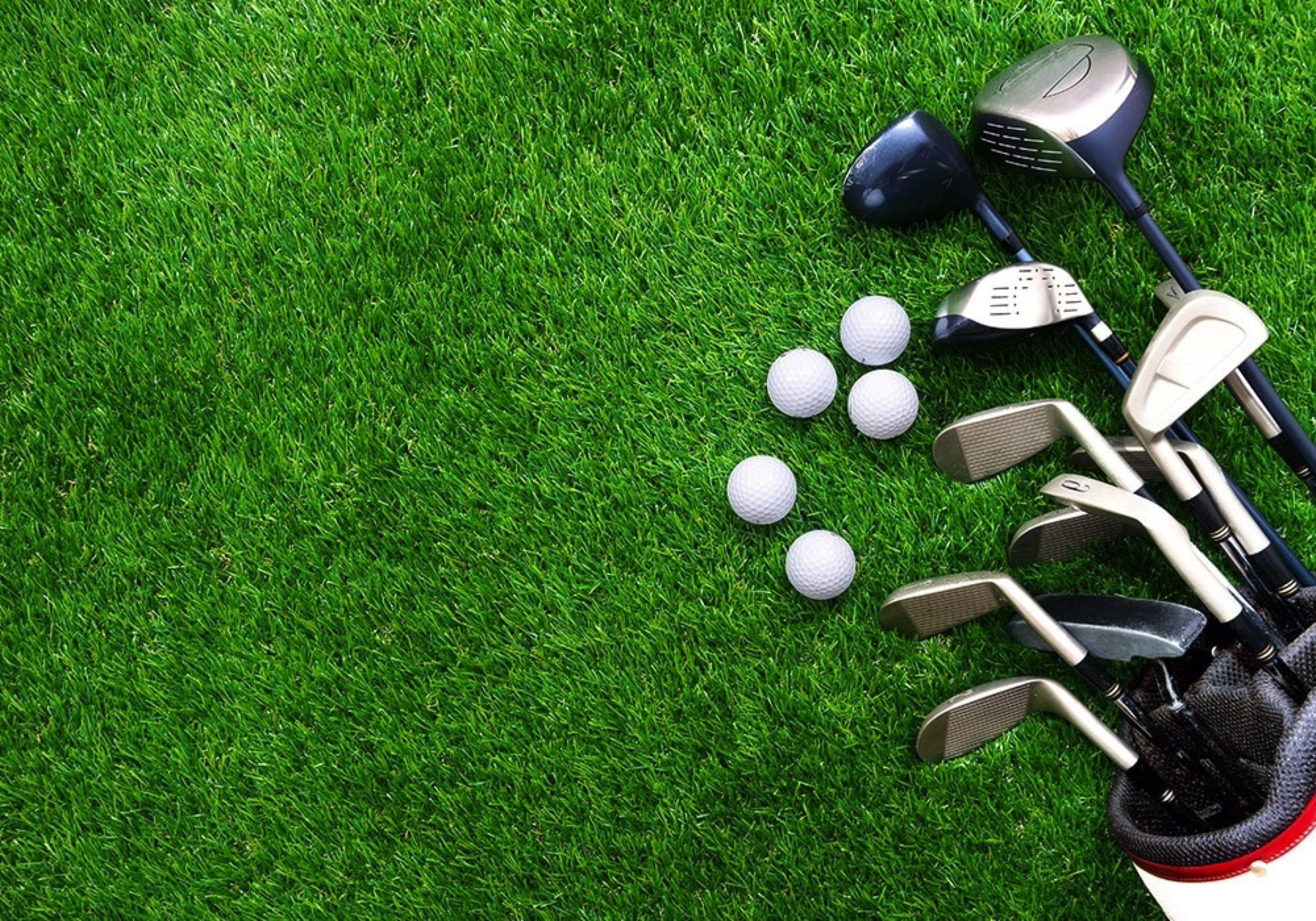
Golf Nets
If the mood strikes to work on your fairway swing, head to our Golf Net. All equipment is provided for you to practice your swing while soaking up the most glorious views imaginable.
The glorious ocean vistas you’ll admire every day won’t necessarily have you thinking of golf course fairways, but if you find yourself wishing you could be practicing your fairway swing, head to our Golf Net. All the clubs and golf balls you need are available. Who knows? Maybe you’ll return home from your voyage with a few kinks worked out of your golf swing…
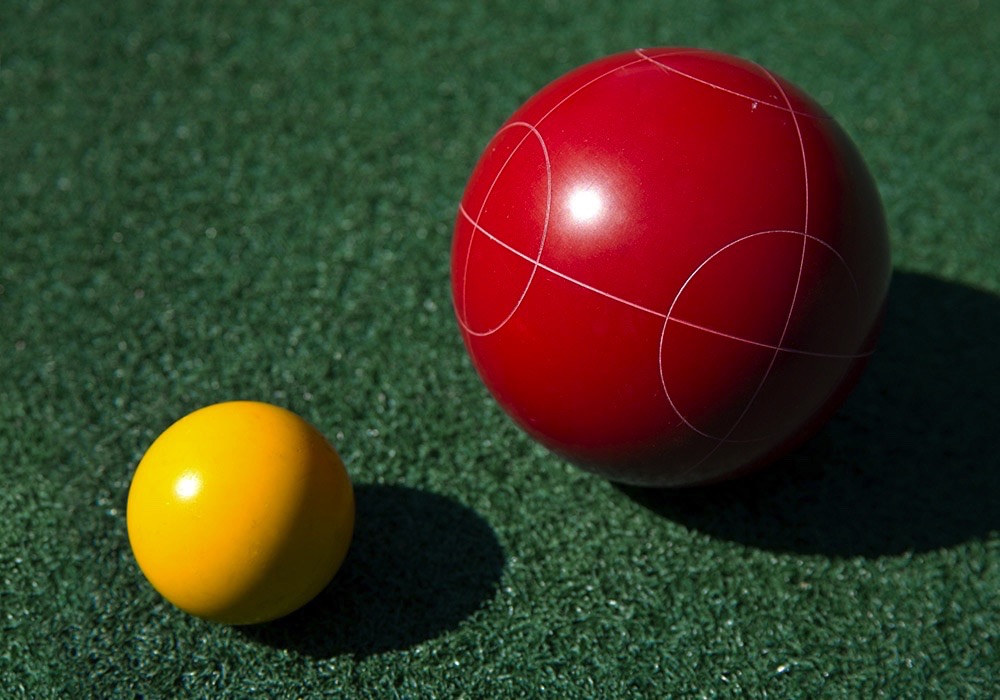
Bocce Court
Gather some friends and engage in a game originated in 5,000 BC. Our Bocce Court has the requisite equipment – a pallina and 8 larger balls – for you to engage in a spirited contest as the sun sets.
The originators of bocce ball 7,000 years ago couldn’t have imagined their simple game being played high atop a glorious ocean liner … but you’ll be able to do more than imagine while playing it onboard Seven Seas Mariner®. Bocce ball – also known as Italian lawn bowling – is played with a pallina and 8 larger balls, all of course provided.
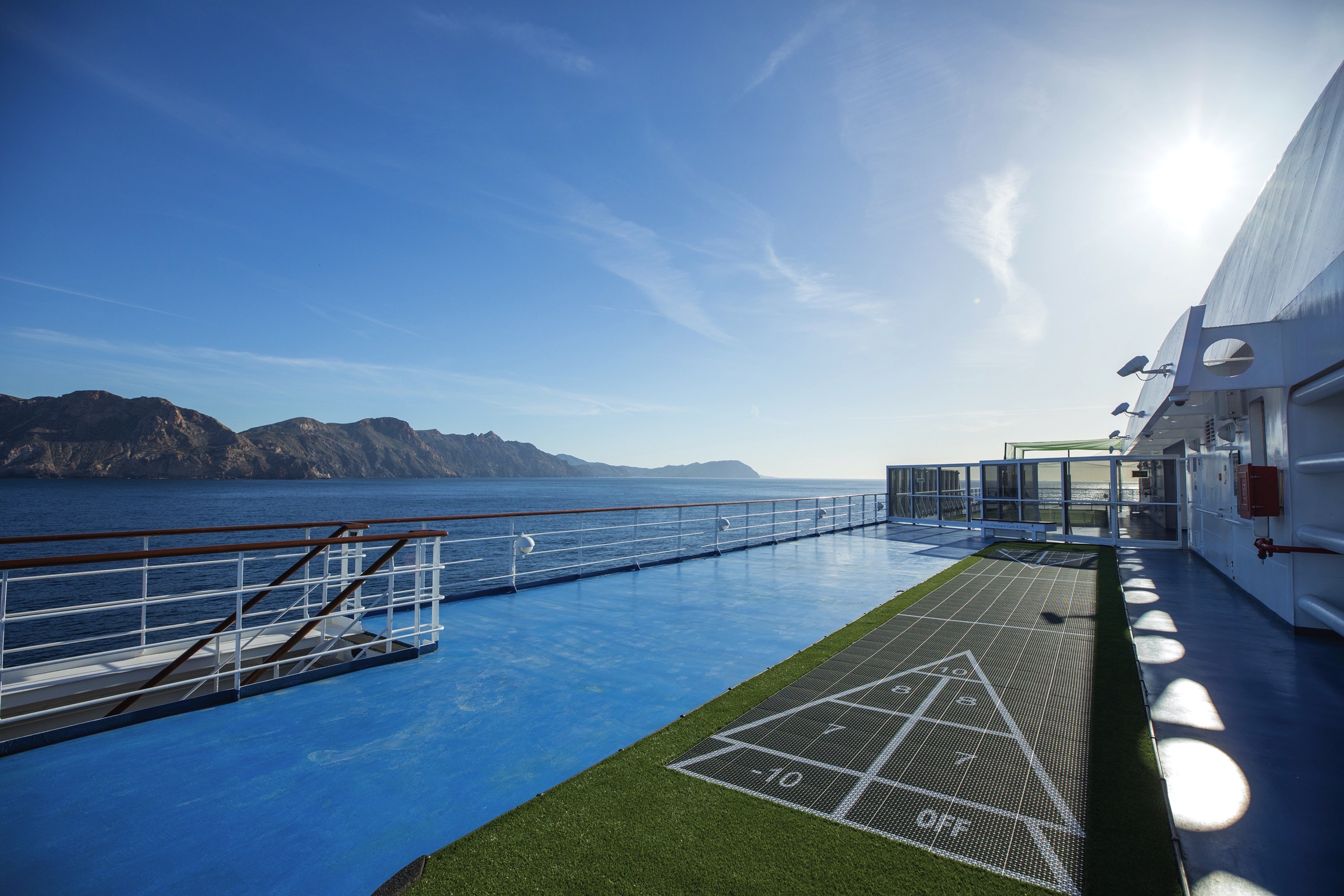
Shuffleboard
Probably the game most associated with cruise ships, shuffleboard onboard Seven Seas Mariner® is a more dramatic affair. High atop your ship, you won’t mind awaiting your turn as you take in glorious horizon views.
This isn’t the sleepy version of shuffleboard. From high atop Seven Seas Mariner®, you’ll be enchanted by ocean vistas stretching horizon to horizon as you engage in a game that dates back to 15th-century England. All equipment is well-maintained and available for use – all you have to do is bring a team, or perhaps join one in need of a player.

Club Mariner
Families with young travellers will enjoy our Club Mariner Youth Program on select voyages. Children ages 5 to 17 can participate in a range of specialised activities, from mini-putt tournaments to dance parties to movie nights. Each program is designed and supervised by friendly and professional youth counsellors.
Club Mariner is available on select sailings only. Please ask your travel professional for details.
Disabled Facilities
For details on a prearranged rental program, please contact our authorised vendor:
Scootaround Personal Transportation Solutions
- Phone: 1.888.441.7575
- Email: info@scootaround.com
- scootaround.com/rent-online
Special Dietary Requirements
Please advise Regent Seven Seas Cruises of any special dietary requirements you may have 120 days prior to sailing for voyages embarking in the US and 150 days for all other voyages, by sending an e-mail to specialrequests@rssc.com. General dietary needs such as low salt or low cholesterol foods can be satisfied onboard the ship just by speaking with the dining wait staff.
All frozen kosher prepackaged meals are provided by Borenstein Caterers Incorporated. This New York-based company has catered kosher meals for more than 60 years and works under the supervision of the Union of Orthodox Jewish Congregations of America (the OU). The menu selection includes an assortment of breakfast, lunch, and dinner dishes, with appetisers, soups, side dishes and desserts to choose from, each presented in plastic containers and double wrapped. Additionally, all bread is Pas Yisroel and all dairy products are Cholov Yisroel.
For those guests who are not strictly kosher and would like our chefs to prepare their meals, we have limited quantities of kosher proteins such as veal rack, ribeye steak, lamb rack, turkey breast, whole chicken, and fresh or frozen fish available on board. Please note that the preparation of these proteins will not be according to the rules of kashrut.
We are pleased to serve guests kosher meals, both prepackaged and fresh, exclusively in our elegant Compass Rose restaurant. Once on board, please contact the maître d’ of Compass Rose to make dining arrangements.
Age Restrictions
Infants must be six months of age as of the first day of the cruise. For voyages that have three or more consecutive days at sea, infants must be at least one year of age as of the first day of the cruise. Guests traveling with a young infant that does not meet the infant policy will be denied boarding. No refunds or other compensation shall be due from Regent Seven Seas Cruises to anyone as a result of the denial of boarding to an underage infant or any accompanying guests. Based on SOLAS requirements Regent Seven Seas Cruises cannot and will not make any exceptions to allow infants on any of their cruises which do not meet the minimum one year of age requirement. No waivers will be accepted. Please do not enquire about making any exceptions, as all requests will be denied. Any guest under the age of 18 must be accompanied by and occupy the same suite as an adult 18 years or older. Regent Seven Seas Cruises does not provide for the care, entertainment or supervision of children. Guests under the age of 16 are not permitted to use the spa or fitness facilities, even if supervised by an adult. Special promotional rates are available for children on select sailings. To be eligible, the child must be under the age of 18.
Dress Code
Attire ranges from Casual to Formal Optional. Casual wear consists of resort-style outfits; some examples are jeans, shorts, t-shirts, and tennis shoes. Casual wear is appropriate for daytime both on board or ashore. Casual wear is not appropriate after 6:00 PM. On the night prior to disembarkation, guests may need to pack their luggage early due to morning flights the next day. With this in mind, on the last night of every voyage, we will relax the dress code for dinner to Casual.
Otherwise, the recommended onboard dress in the evenings is Elegant Casual. Dinner dress for ladies includes a skirt, or slacks with a blouse or sweater, a pant suit or dress; slacks and a collared shirt for gentlemen. Sport jackets are optional. Casual wear is not to be worn at dinner. Ties are not required.
On sailings of 16 nights or more, Formal and Semi-Formal attire is optional on two of the evenings. On the two Formal Optional evenings, guests are welcome to dress as per the elegant Casual dress code or opt for a more formal choice of clothing including gowns and cocktail dresses for ladies; tuxedos, dinner jackets or dark suits with tie for gentlemen.
Smoking Policy
For the comfort and safety of all of our Guests, smoking is not permitted in any enclosed dining area, certain public venues, elevators, the Theatre, and all suites and balconies, and is only permitted in specific designated smoking areas. The use of electronic cigarettes is allowed within designated smoking areas only.
Cigarette smoking is only permitted in designated areas of the outdoor pool area and the following public rooms:
- Seven Seas Splendor: Connoisseur Club, Pool area (designated area opposite side of the Pool Bar)
- Seven Seas Explorer: Connoisseur Club, Pool area (designated area opposite side of the Pool Bar)
- Seven Seas Voyager: Connoisseur Club, Horizon Lounge (outdoor one side designated area), Pool area (designated area opposite side of the Pool Bar)
- Seven Seas Mariner: Connoisseur Club, Horizon Lounge (outdoor one side designated area), Pool area (designated area opposite side of the Pool Bar)
- Seven Seas Navigator: Galileo’s (outdoor one side designated area), Pool area (designated area opposite side of the Pool Bar)
Cigar Smoking is only permitted in the Connoisseur Club on applicable ships and the designated area on the opposite side of the Pool Bar.
Pipe smoking is only permitted in the Connoisseur Club. Pipe smoking in open deck areas is considered an extreme fire hazard and is not permitted.
Failure to comply with the above smoking policy will result in guests being asked to leave the ship at their expense, without refund or credit for the unused portion of their cruise.
Sail & Sustain
Our global sustainability program, Sail & Sustain, is centred around our commitment to drive a positive impact on society and the environment while delivering on our vision to be the vacation of choice for everyone around the world. We visit nearly 500 destinations globally, allowing our guests to travel and explore the world, and our business is inextricably linked to the preservation of our planet and the protection of our shared resources.
Our environmental, social and governance (ESG) strategy is focused on five pillars and was developed through cross-functional collaboration with key internal and external stakeholders. As we continue our ESG journey, we look forward to building upon this foundation and meaningfully contributing to the UN Sustainable Development Goals (SDGs) as we collectively chart a path towards a more sustainable future.
Alcohol Policy
The sale and consumption of alcoholic beverages will be limited to guests aged 21 years or older. However, with the exception of Hawaii, Alaska and New England voyages not leaving U.S. territorial waters, guests between the ages of 18 through 20 may purchase and personally consume wine and beer only while on board and with the consent of an accompanying parent. Authorisation will be given only when the accompanying parent completes the Young Adult Alcoholic Beverage Waiver form. This form can be obtained and completed at the Reception Desk upon embarkation. While sailing on select international voyages, guests 18 years or older are permitted to consume alcoholic beverages without having to complete the Young Adult Alcoholic Beverage Waiver form. Guests are kindly reminded to consume alcohol in moderation. Regent Seven Seas Cruises reserves the right to prohibit and retain all liquor brought aboard the ship.
Internet Access
High-speed, unlimited WiFi is available on board all Regent Seven Seas Cruises® ships, powered by Starlink’s advanced satellite technology. From January 1, 2025, two complimentary logins per suite are included in the All-Inclusive Cruise Fare for guests in Deluxe Window, Veranda, Deluxe Veranda, and Serenity Suites, and four complimentary logins for guests in Concierge Suites and above.
Guests wishing to further enhance their WiFi connection onboard may do so by purchasing a streaming upgrade package with prices varying depending on the length of sailing:
- Voyage Length 1-29 Days: $14.99 per login, per day
- Voyage Length 30+ Days: $9.99 per login, per day
Service and speed will vary port to port.
If you are utilising a mobile device that access the internet via a cellular carrier’s network (5G for example) instead of the ship’s wireless access, it will be treated as if you were using your cell phone and International roaming charges will apply. Any costs associated will be billed directly through your cell phone provider, and not through the ship.
Medical Services
Each ship has a licensed and registered doctor and nurse for professional and emergency services, which are available at customary charges. The ships’ medical centres are designed to provide medical care for certain temporary illnesses and accidents, and are not intended or capable of providing on-going treatment of pre-existing medical conditions. For guests requiring oxygen equipment, an oxygen concentrator is the only form of oxygen equipment allowed aboard ship, and must be provided by the guest. Regent Seven Seas Cruises’ wheelchairs on board are for emergency purposes only.
Laundry Services
All guests will now benefit from FREE Valet Laundry Service during their cruise. Enjoy the luxury and convenience of freshly washed, carefully pressed and folded laundry picked up and delivered to your suite throughout your voyage.
Currency
The ships currency is the US dollar and all charges made on board to the company shall be in US dollars. We operate a ‘cashless system’.
At the time of embarkation, we request registration of an accepted credit card. The night prior to your final disembarkation from the ship, a detailed statement of your shipboard charges for on board services and products will be delivered to your suite. All such charges must be settled in full by cash or accepted credit card (Visa Debit, MasterCard, American Express).
On limited itineraries the ship may offer foreign currency exchange from the Reception desk. All onboard foreign currency exchange transactions will be charged to the guest’s onboard account and a 5% transaction fee will be applied. As we are unable to provide all currencies, most can be found within the ship’s terminal.
Foreign exchange
You may purchase certain currency from the reception. All onboard foreign currency exchange transactions will be charged to the guest’s onboard account. As we are unable to provide all currencies, most can be found within the ship’s terminal.
What's Included
For over three decades, Regent has offered The Most Inclusive Luxury Experience®, whether on land or at sea. Our comprehensive included luxuries, available on every voyage, have been carefully curated to optimise each guests’ cruise. We’ll tend to every detail of your journey from start to finish, so you can enjoy the relaxed elegance and comfort aboard The World’s Most Luxurious Fleet®, as well as the heartfelt hospitality delivered by our incredible crew who not only care for you, but about you.
ALWAYS INCLUDED:
FOR YOUR COMFORT
- Spacious oceanview suites, 99% with a private balcony
- Generous walk-in closets with ample storage space in 99% of suites
- Spacious marble & stone detailed bathrooms, many with double vanities
- Personalised service with industry leading staff-to-guest ratios
- Butler service in Penthouse suites & higher
FOR YOUR ENJOYMENT
- Unlimited shore excursions
- Unlimited beverages, fine wines, craft cocktails, speciality coffees & more
- Exquisite dining including all speciality restaurants at no added cost
- Customisable in-suite mini bar replenished daily with your preferences
- Open bars and lounges and dynamic entertainment and enrichment experiences
- Unlimited access to spa facilities
FOR YOUR CONVENIENCE
- Unlimited WiFi
- Pre-paid gratuities
- Valet laundry service allowing your clients to pack light and explore more
- 24-hour in-suite dining
- 1-night pre-cruise hotel in concierge suites & higher
- Experienced concierge staff to cater to “off-menu” personal requests

Deck 12
- Paddle Tennis
- Golf Nets
- Putting Green
- Bocce Court
- Shuffleboard
- Jogging Track
- Observation Lounge

Deck 11
- Atrium
- La Veranda
- Sette Mari at La Veranda
- Pool Grill
- Pool Bar
- Pool Deck
- Pool
- Whirlpools
- Penthouse Suites
- Grand Suites

Deck 10
- Atrium
- Laundrette
- Horizon View Suites
- Seven Seas Suites
- Concierge Suites
- Penthouse Suites
- Mariner Suites

Deck 9
- Atrium
- Laundrette
- Signature Suite
- Deluxe Veranda Suites
- Horizon View Suites
- Seven Seas Suites
- Concierge Suites
- Penthouse Suites
- Mariner Suites

Deck 8
- Atrium
- Laundrette
- Horizon View Suites
- Seven Seas Suites
- Deluxe Veranda Suites
- Concierge Suites
- Penthouse Suites
- Mariner Suites

Deck 7
- Atrium
- Boutiques
- Fitness Centre
- Serene Spa & Wellness™
- The Casino
- Seven Seas Suites
- Horizon View Suites
- Deluxe Veranda Suites

Deck 6
- Atrium
- Boutiques
- Card & Conference Room
- Chartreuse
- Club.com
- Coffee Connection
- Connoisseur Club
- Constellation Theatre
- Horizon Lounge
- Stars Lounge
- Stars Night Club
- Library
- The Garden Promenade
- Horizon Lounge

Deck 5
- Atrium
- Compass Rose
- Constellation Theatre
- Mariner Lounge
- Prime 7
- Destination Services
- Reception & Concierge


